Italy
Italy (Italian: Italia [iˈtaːlja] (![]() listen)), officially the Italian Republic (Italian: Repubblica Italiana [reˈpubːlika itaˈljaːna]),[13][14][15][16] is a country consisting of a peninsula delimited by the Alps and several islands surrounding it. Italy is located in Southern Europe,[17][18] and is also considered part of Western Europe.[19][20] A unitary parliamentary republic with Rome as its capital, the country covers a total area of 301,340 km2 (116,350 sq mi) and shares land borders with France, Switzerland, Austria, Slovenia, and the enclaved microstates of Vatican City and San Marino. Italy has a territorial enclave in Switzerland (Campione) and a maritime exclave in Tunisian waters (Lampedusa). With around 60 million inhabitants, Italy is the third-most populous member state of the European Union.
listen)), officially the Italian Republic (Italian: Repubblica Italiana [reˈpubːlika itaˈljaːna]),[13][14][15][16] is a country consisting of a peninsula delimited by the Alps and several islands surrounding it. Italy is located in Southern Europe,[17][18] and is also considered part of Western Europe.[19][20] A unitary parliamentary republic with Rome as its capital, the country covers a total area of 301,340 km2 (116,350 sq mi) and shares land borders with France, Switzerland, Austria, Slovenia, and the enclaved microstates of Vatican City and San Marino. Italy has a territorial enclave in Switzerland (Campione) and a maritime exclave in Tunisian waters (Lampedusa). With around 60 million inhabitants, Italy is the third-most populous member state of the European Union.
Italian Republic | |
|---|---|
.svg.png.webp) 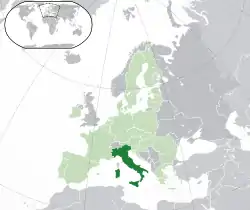 Location of Italy (dark green) – in Europe (light green & dark grey) | |
| Capital and largest city | Rome 41°54′N 12°29′E |
| Official languages | Italiana |
| Native languages | See full list |
| Ethnic groups (2017)[1] | |
| Religion (2012)[2] |
|
| Demonym(s) | Italian |
| Government | Unitary parliamentary constitutional republic |
| Sergio Mattarella | |
| Giuseppe Conte | |
| Elisabetta Casellati | |
| Roberto Fico | |
| Legislature | Parliament |
| Senate of the Republic | |
| Chamber of Deputies | |
| Formation | |
| 17 March 1861 | |
• Republic | 2 June 1946 |
| 1 January 1948 | |
| 1 January 1958 | |
| Area | |
• Total | 301,340 km2 (116,350 sq mi) (71st) |
• Water (%) | 1.24 (as of 2015)[3] |
| Population | |
• 2020 estimate | |
• 2011 census | |
• Density | 201.3/km2 (521.4/sq mi) (63rd) |
| GDP (PPP) | 2019 estimate |
• Total | |
• Per capita | |
| GDP (nominal) | 2019 estimate |
• Total | |
• Per capita | |
| Gini (2018) | medium |
| HDI (2019) | very high · 29th |
| Currency | Euro (€)b (EUR) |
| Time zone | UTC+1 (CET) |
| UTC+2 (CEST) | |
| Date format | dd/mm/yyyy yyyy-mm-dd (AD)[9] |
| Driving side | right |
| Calling code | +39c |
| ISO 3166 code | IT |
| Internet TLD | .itd |
| |
Due to its central geographic location in Southern Europe and the Mediterranean, Italy has historically been home to myriad peoples and cultures. In addition to the various ancient peoples dispersed throughout what is now modern-day Italy, the most predominant being the Indo-European Italic peoples who gave the peninsula its name, beginning from the classical era, Phoenicians and Carthaginians founded colonies mostly in insular Italy,[21] Greeks established settlements in the so-called Magna Graecia of Southern Italy, while Etruscans and Celts inhabited central and northern Italy respectively. An Italic tribe known as the Latins formed the Roman Kingdom in the 8th century BC, which eventually became a republic with a government of the Senate and the People. The Roman Republic initially conquered and assimilated its neighbours on the Italian peninsula, eventually expanding and conquering parts of Europe, North Africa and Asia. By the first century BC, the Roman Empire emerged as the dominant power in the Mediterranean Basin and became a leading cultural, political and religious centre, inaugurating the Pax Romana, a period of more than 200 years during which Italy's law, technology, economy, art, and literature developed.[22][23] Italy remained the homeland of the Romans and the metropole of the empire, whose legacy can also be observed in the global distribution of culture, governments, Christianity and the Latin script.
During the Early Middle Ages, Italy endured the fall of the Western Roman Empire and barbarian invasions, but by the 11th century numerous rival city-states and maritime republics, mainly in the northern and central regions of Italy, rose to great prosperity through trade, commerce and banking, laying the groundwork for modern capitalism.[24] These mostly independent statelets served as Europe's main trading hubs with Asia and the Near East, often enjoying a greater degree of democracy than the larger feudal monarchies that were consolidating throughout Europe; however, part of central Italy was under the control of the theocratic Papal States, while Southern Italy remained largely feudal until the 19th century, partially as a result of a succession of Byzantine, Arab, Norman, Angevin, Aragonese and other foreign conquests of the region.[25] The Renaissance began in Italy and spread to the rest of Europe, bringing a renewed interest in humanism, science, exploration and art. Italian culture flourished, producing famous scholars, artists and polymaths. During the Middle Ages, Italian explorers discovered new routes to the Far East and the New World, helping to usher in the European Age of Discovery. Nevertheless, Italy's commercial and political power significantly waned with the opening of trade routes that bypassed the Mediterranean.[26] Centuries of foreign meddling and conquest and the rivalry and infighting between the Italian city-states, such as the Italian Wars of the 15th and 16th centuries, left Italy politically fragmented, and it was further conquered and divided among multiple foreign European powers over the centuries.
By the mid-19th century, rising Italian nationalism and calls for independence from foreign control led to a period of revolutionary political upheaval. After centuries of foreign domination and political division, Italy was almost entirely unified in 1861, establishing the Kingdom of Italy as a great power.[27] From the late 19th century to the early 20th century, Italy rapidly industrialised, mainly in the north, and acquired a colonial empire,[28] while the south remained largely impoverished and excluded from industrialisation, fuelling a large and influential diaspora.[29] Despite being one of the four main allied powers in World War I, Italy entered a period of economic crisis and social turmoil, leading to the rise of the Italian fascist dictatorship in 1922. Participation in World War II on the Axis side ended in military defeat, economic destruction and the Italian Civil War. Following the liberation of Italy and the rise of the Italian Resistance, the country abolished their monarchy, established a democratic Republic, enjoyed a prolonged economic boom, and became a highly developed country.[30]
Today, Italy is considered to be one of the world's most culturally and economically advanced countries,[30][31][32] with the world's eighth-largest economy by nominal GDP (third in the European Union), sixth-largest national wealth and third-largest central bank gold reserve. It ranks very highly in life expectancy, quality of life,[33] healthcare,[34] and education. The country plays a prominent role in regional and global economic, military, cultural and diplomatic affairs; it is both a regional power[35][36] and a great power,[37][38] and is ranked the world's eighth most-powerful military. Italy is a founding and leading member of the European Union and a member of numerous international institutions, including the United Nations, NATO, the OECD, the Organization for Security and Co-operation in Europe, the World Trade Organization, the Group of Seven, the G20, the Union for the Mediterranean, the Council of Europe, Uniting for Consensus, the Schengen Area and many more. The country has long been a global centre of art, music, literature, philosophy, science and technology, and fashion, and has greatly influenced and contributed to diverse fields including cinema, cuisine, sports, jurisprudence, banking and business.[39] As a reflection of its cultural wealth, Italy is home to the world's largest number of World Heritage Sites (55), and is the fifth-most visited country.
Name

Hypotheses for the etymology of the name "Italia" are numerous.[40] One is that it was borrowed via Greek from the Oscan Víteliú 'land of calves' (cf. Lat vitulus "calf", Umb vitlo "calf").[41] Greek historian Dionysius of Halicarnassus states this account together with the legend that Italy was named after Italus,[42] mentioned also by Aristotle[43] and Thucydides.[44]
According to Antiochus of Syracuse, the term Italy was used by the Greeks to initially refer only to the southern portion of the Bruttium peninsula corresponding to the modern province of Reggio and part of the provinces of Catanzaro and Vibo Valentia in southern Italy. Nevertheless, by his time the larger concept of Oenotria and "Italy" had become synonymous and the name also applied to most of Lucania as well. According to Strabo's Geographica, before the expansion of the Roman Republic, the name was used by Greeks to indicate the land between the strait of Messina and the line connecting the gulf of Salerno and gulf of Taranto, corresponding roughly to the current region of Calabria. The Greeks gradually came to apply the name "Italia" to a larger region[45] In addition to the "Greek Italy" in the south, historians have suggested the existence of an "Etruscan Italy" covering variable areas of central Italy.[46]
The borders of Roman Italy, Italia, are better established. Cato's Origines, the first work of history composed in Latin, described Italy as the entire peninsula south of the Alps.[47] According to Cato and several Roman authors, the Alps formed the "walls of Italy".[48] In 264 BC, Roman Italy extended from the Arno and Rubicon rivers of the centre-north to the entire south. The northern area of Cisalpine Gaul was occupied by Rome in the 220s BC and became considered geographically and de facto part of Italy,[49] but remained politically and de jure separated. It was legally merged into the administrative unit of Italy in 42 BC by the triumvir Octavian as a ratification of Caesar's unpublished acts (Acta Caesaris).[50][51][52][53][54] The islands of Sardinia, Corsica, Sicily and Malta were added to Italy by Diocletian in 292 AD.[55]
History
Prehistory and antiquity
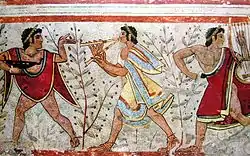
Thousands of Paleolithic-era artifacts have been recovered from Monte Poggiolo and dated to around 850,000 years before the present, making them the oldest evidence of first hominins habitation in the peninsula.[57] Excavations throughout Italy revealed a Neanderthal presence dating back to the Palaeolithic period some 200,000 years ago,[58] while modern Humans appeared about 40,000 years ago at Riparo Mochi.[59] Archaeological sites from this period include Addaura cave, Altamura, Ceprano, and Gravina in Puglia.[60]
The Ancient peoples of pre-Roman Italy – such as the Umbrians, the Latins (from which the Romans emerged), Volsci, Oscans, Samnites, Sabines, the Celts, the Ligures, the Veneti, the Iapygians and many others – were Indo-European peoples, most of them specifically of the Italic group. The main historic peoples of possible non-Indo-European or pre-Indo-European heritage include the Etruscans of central and northern Italy, the Elymians and the Sicani in Sicily, and the prehistoric Sardinians, who gave birth to the Nuragic civilisation. Other ancient populations being of undetermined language families and of possible non-Indo-European origin include the Rhaetian people and Cammuni, known for their rock carvings in Valcamonica, the largest collections of prehistoric petroglyphs in the world.[61] A well-preserved natural mummy known as Ötzi the Iceman, determined to be 5,000 years old (between 3400 and 3100 BCE, Copper Age), was discovered in the Similaun glacier of South Tyrol in 1991.[62]
The first foreign colonizers were the Phoenicians, who initially established colonies and founded various emporiums on the coasts of Sicily and Sardinia. Some of these soon became small urban centres and were developed parallel to the Greek colonies; among the main centres there were the cities of Motya, Zyz (modern Palermo), Soluntum in Sicily and Nora, Sulci, and Tharros in Sardinia.[63]
Between the 17th and the 11th centuries BC Mycenaean Greeks established contacts with Italy[64][65][66][67] and in the 8th and 7th centuries BC a number of Greek colonies were established all along the coast of Sicily and the southern part of the Italian Peninsula, that became known as Magna Graecia. The Greek colonization placed the Italic peoples in contact with democratic government forms and with elevated artistic and cultural expressions.[68]
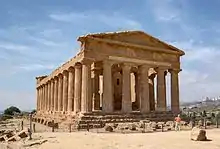
Phoenician and Greek colonization
The first foreign colonizers were the Phoenicians, who initially founded various emporiums on the coasts of Sicily and Sardinia. Some of these quickly become small urban centers and develop parallel to the Greek colonies; among the main centers are the cities of Mozia, Zyz, Kfra in Sicily and Nora, Sulci, Tharros in Sardinia.[69]
After the eighth century BC, colonizers from Greece settled on the coasts of southern Italy giving life to Magna Graecia and those of Sicily. Ionian settlers founded Elaia, Kyme, Rhegion, Parthènope, Naxos, Zankles, Hymera and Katane. Doric colonists founded Taras, Syrakousai, Megara Hyblaia, Leontinoi, Akragas, Ghelas; the Syracusans founded Ankón and Adria; the megarese founded Selinunte. The Achaeans founded Sybaris, Poseidonia, Kroton, Lokroi Epizephyrioi and Metapontum; tarantini and thuriots found Herakleia.
The Greek colonization places the Italic peoples in contact with democratic forms of government and with high artistic and cultural expressions.[70]
Ancient Rome
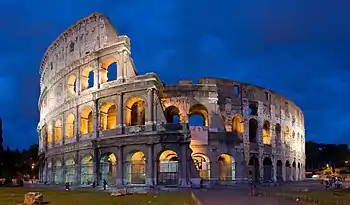

Rome, a settlement around a ford on the river Tiber in central Italy conventionally founded in 753 BC, was ruled for a period of 244 years by a monarchical system, initially with sovereigns of Latin and Sabine origin, later by Etruscan kings. The tradition handed down seven kings: Romulus, Numa Pompilius, Tullus Hostilius, Ancus Marcius, Tarquinius Priscus, Servius Tullius and Tarquinius Superbus. In 509 BC, the Romans expelled the last king from their city, favouring a government of the Senate and the People (SPQR) and establishing an oligarchic republic.
The Italian Peninsula, named Italia, was consolidated into a single entity during the Roman expansion and conquest of new lands at the expense of the other Italic tribes, Etruscans, Celts, and Greeks. A permanent association with most of the local tribes and cities was formed, and Rome began the conquest of Western Europe, Northern Africa and the Middle East. In the wake of Julius Caesar's rise and death in the first century BC, Rome grew over the course of centuries into a massive empire stretching from Britain to the borders of Persia, and engulfing the whole Mediterranean basin, in which Greek and Roman and many other cultures merged into a unique civilisation. The long and triumphant reign of the first emperor, Augustus, began a golden age of peace and prosperity. Italy remained the metropole of the empire, and as the homeland of the Romans and the territory of the capital, maintained a special status which made it "not a province, but the Domina (ruler) of the provinces".[71] More than two centuries of stability followed, during which Italy was referred to as the rectrix mundi (queen of the world) and omnium terrarum parens (motherland of all lands).[72]
The Roman Empire was among the most powerful economic, cultural, political and military forces in the world of its time, and it was one of the largest empires in world history. At its height under Trajan, it covered 5 million square kilometres.[73][74] The Roman legacy has deeply influenced the Western civilisation, shaping most of the modern world; among the many legacies of Roman dominance are the widespread use of the Romance languages derived from Latin, the numerical system, the modern Western alphabet and calendar, and the emergence of Christianity as a major world religion.[75] The Indo-Roman trade relations, beginning around the 1st century BCE, testifies to extensive Roman trade in far away regions; many reminders of the commercial trade between the Indian subcontinent and Italy have been found, such as the ivory statuette Pompeii Lakshmi from the ruins of Pompeii.
In a slow decline since the third century AD, the Empire split in two in 395 AD. The Western Empire, under the pressure of the barbarian invasions, eventually dissolved in 476 AD when its last emperor, Romulus Augustulus, was deposed by the Germanic chief Odoacer. The Eastern half of the Empire survived for another thousand years.
Middle Ages
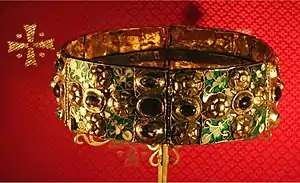
After the fall of the Western Roman Empire, Italy fell under the power of Odoacer's kingdom, and, later, was seized by the Ostrogoths,[76] followed in the 6th century by a brief reconquest under Byzantine Emperor Justinian. The invasion of another Germanic tribe, the Lombards, late in the same century, reduced the Byzantine presence to the rump realm of the Exarchate of Ravenna and started the end of political unity of the peninsula for the next 1,300 years. Invasions of the peninsula caused a chaotic succession of barbarian kingdoms and the so-called "dark ages". The Lombard kingdom was subsequently absorbed into the Frankish Empire by Charlemagne in the late 8th century. The Franks also helped the formation of the Papal States in central Italy. Until the 13th century, Italian politics was dominated by the relations between the Holy Roman Emperors and the Papacy, with most of the Italian city-states siding with the former (Ghibellines) or with the latter (Guelphs) from momentary convenience.[77]
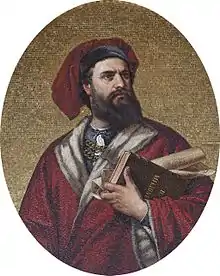
The Germanic Emperor and the Roman Pontiff became the universal powers of medieval Europe. However, the conflict for the investiture controversy (a conflict over two radically different views of whether secular authorities such as kings, counts, or dukes, had any legitimate role in appointments to ecclesiastical offices) and the clash between Guelphs and Ghibellines led to the end of the Imperial-feudal system in the north of Italy where city-states gained independence. It was during this chaotic era that Italian towns saw the rise of a peculiar institution, the medieval commune. Given the power vacuum caused by extreme territorial fragmentation and the struggle between the Empire and the Holy See, local communities sought autonomous ways to maintain law and order.[79] The investiture controversy was finally resolved by the Concordat of Worms. In 1176 a league of city-states, the Lombard League, defeated the German emperor Frederick Barbarossa at the Battle of Legnano, thus ensuring effective independence for most of northern and central Italian cities.
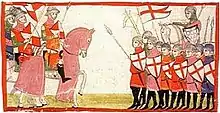
Italian city-states such as Milan, Florence and Venice played a crucial innovative role in financial development, devising the main instruments and practices of banking and the emergence of new forms of social and economic organization.[80] In coastal and southern areas, the maritime republics grew to eventually dominate the Mediterranean and monopolise trade routes to the Orient. They were independent thalassocratic city-states, though most of them originated from territories once belonging to the Byzantine Empire. All these cities during the time of their independence had similar systems of government in which the merchant class had considerable power. Although in practice these were oligarchical, and bore little resemblance to a modern democracy, the relative political freedom they afforded was conducive to academic and artistic advancement.[81] The four best known maritime republics were Venice, Genoa, Pisa and Amalfi; the others were Ancona, Gaeta, Noli, and Ragusa.[82][83][84] Each of the maritime republics had dominion over different overseas lands, including many Mediterranean islands (especially Sardinia and Corsica), lands on the Adriatic, Aegean, and Black Sea (Crimea), and commercial colonies in the Near East and in North Africa. Venice maintained enormous tracts of land in Greece, Cyprus, Istria and Dalmatia until as late as the mid-17th century.[85]
Right: Trade routes and colonies of the Genoese (red) and Venetian (green) empires.
Venice and Genoa were Europe's main gateway to trade with the East, and a producer of fine glass, while Florence was a capital of silk, wool, banks and jewellery. The wealth such business brought to Italy meant that large public and private artistic projects could be commissioned. The republics were heavily involved in the Crusades, providing support and transport, but most especially taking advantage of the political and trading opportunities resulting from these wars.[81] Italy first felt huge economic changes in Europe which led to the commercial revolution: the Republic of Venice was able to defeat the Byzantine Empire and finance the voyages of Marco Polo to Asia; the first universities were formed in Italian cities, and scholars such as Thomas Aquinas obtained international fame; Frederick of Sicily made Italy the political-cultural centre of a reign that temporarily included the Holy Roman Empire and the Kingdom of Jerusalem; capitalism and banking families emerged in Florence, where Dante and Giotto were active around 1300.[24]
In the south, Sicily had become an Islamic emirate in the 9th century, thriving until the Italo-Normans conquered it in the late 11th century together with most of the Lombard and Byzantine principalities of southern Italy.[86] Through a complex series of events, southern Italy developed as a unified kingdom, first under the House of Hohenstaufen, then under the Capetian House of Anjou and, from the 15th century, the House of Aragon. In Sardinia, the former Byzantine provinces became independent states known in Italian as Judicates, although some parts of the island fell under Genoese or Pisan rule until the eventual Aragonese annexation in the 15th century. The Black Death pandemic of 1348 left its mark on Italy by killing perhaps one third of the population.[87][88] However, the recovery from the plague led to a resurgence of cities, trade and economy which allowed the bloom of Humanism and Renaissance, that later spread to Europe.
Early Modern
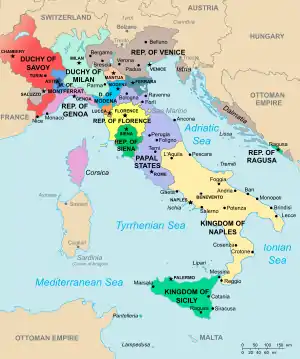
Italy was the birthplace and heart of the Renaissance during the 1400s and 1500s. The Italian Renaissance marked the transition from the medieval period to the modern age as Europe recovered, economically and culturally, from the crises of the Late Middle Ages and entered the Early Modern Period. The Italian polities were now regional states effectively ruled by Princes, de facto monarchs in control of trade and administration, and their courts became major centres of Arts and Sciences. The Italian princedoms represented a first form of modern states as opposed to feudal monarchies and multinational empires. The princedoms were led by political dynasties and merchant families such as the Medici in Florence, the Visconti and Sforza in the Duchy of Milan, the Doria in the Republic of Genoa, the Mocenigo and Barbarigo in the Republic of Venice, the Este in Ferrara, and the Gonzaga in Mantua.[89][90] The Renaissance was therefore a result of the great wealth accumulated by Italian merchant cities combined with the patronage of its dominant families.[89] Italian Renaissance exercised a dominant influence on subsequent European painting and sculpture for centuries afterwards, with artists such as Leonardo da Vinci, Brunelleschi, Botticelli, Michelangelo, Raphael, Giotto, Donatello, and Titian, and architects such as Filippo Brunelleschi, Leon Battista Alberti, Andrea Palladio, and Donato Bramante.
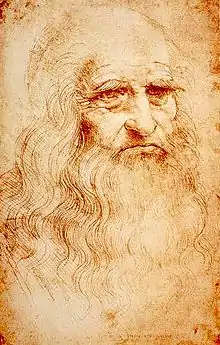
Following the conclusion of the western schism in favour of Rome at the Council of Constance (1415–1417), the new Pope Martin V returned to the Papal States after a three years-long journey that touched many Italian cities and restored Italy as the sole centre of Western Christianity. During the course of this voyage, the Medici Bank was made the official credit institution of the Papacy and several significant ties were established between the Church and the new political dynasties of the peninsula. The Popes' status as elective monarchs turned the conclaves and consistories of the Renaissance into political battles between the courts of Italy for primacy in the peninsula and access to the immense resources of the Catholic Church. In 1439, Pope Eugenius IV and the Byzantine Emperor John VIII Palaiologos signed a reconciliation agreement between the Catholic Church and the Orthodox Church at the Council of Florence hosted by Cosimo the old de Medici. In 1453, Italian forces under Giovanni Giustiniani were sent by Pope Nicholas V to defend the Walls of Constantinople but the decisive battle was lost to the more advanced Turkish army equipped with cannons, and Byzantium fell to Sultan Mehmed II.
The fall of Constantinople led to the migration of Greek scholars and texts to Italy, fueling the rediscovery of Greco-Roman Humanism.[91][92][93] Humanist rulers such as Federico da Montefeltro and Pope Pius II worked to establish ideal cities where man is the measure of all things, and therefore founded Urbino and Pienza respectively. Pico della Mirandola wrote the Oration on the Dignity of Man, considered the manifesto of Renaissance Humanism, in which he stressed the importance of free will in human beings. The humanist historian Leonardo Bruni was the first to divide human history in three periods: Antiquity, Middle Ages and Modernity.[94] The second consequence of the Fall of Constantinople was the beginning of the Age of Discovery.

Italian explorers and navigators from the dominant maritime republics, eager to find an alternative route to the Indies in order to bypass the Ottoman Empire, offered their services to monarchs of Atlantic countries and played a key role in ushering the Age of Discovery and the European colonization of the Americas. The most notable among them were: Christopher Columbus, colonizer in the name of Spain, who is credited with discovering the New World and the opening of the Americas for conquest and settlement by Europeans;[95] John Cabot, sailing for England, who was the first European to set foot in "New Found Land" and explore parts of the North American continent in 1497;[96] Amerigo Vespucci, sailing for Portugal, who first demonstrated in about 1501 that the New World (in particular Brazil) was not Asia as initially conjectured, but a fourth continent previously unknown to people of the Old World (America is named after him);[97][98] and Giovanni da Verrazzano, at the service of France, renowned as the first European to explore the Atlantic coast of North America between Florida and New Brunswick in 1524;[99]
Following the fall of Constantinople, the wars in Lombardy came to an end and a defensive alliance known as Italic League was formed between Venice, Naples, Florence, Milan, and the Papacy. Lorenzo the Magnificent de Medici was the greatest Florentine patron of the Renaissance and supporter of the Italic League. He notably avoided the collapse of the League in the aftermath of the Pazzi Conspiracy and during the aborted invasion of Italy by the Turks. However, the military campaign of Charles VIII of France in Italy caused the end of the Italic League and initiated the Italian Wars between the Valois and the Habsburgs. During the High Renaissance of the 1500s, Italy was therefore both the main European battleground and the cultural-economic centre of the continent. Popes such as Julius II (1503–1513) fought for the control of Italy against foreign monarchs, others such as Paul III (1534–1549) preferred to mediate between the European powers in order to secure peace in Italy. In the middle of this conflict, the Medici popes Leo X (1513–1521) and Clement VII (1523–1534) opposed the Protestant reformation and advanced the interests of their family. The end of the wars ultimately left northern Italy indirectly subject to the Austrian Habsburgs and Southern Italy under direct Spanish Habsburg rule.
The Papacy remained independent and launched the Counter-reformation. Key events of the period include: the Council of Trent (1545–1563); the excommunication of Elizabeth I (1570) and the Battle of Lepanto (1571), both occurring during the pontificate of Pius V; the construction of the Gregorian observatory, the adoption of the Gregorian calendar, and the Jesuit China mission of Matteo Ricci under Pope Gregory XIII; the French Wars of Religion; the Long Turkish War and the execution of Giordano Bruno in 1600, under Pope Clement VIII; the birth of the Lyncean Academy of the Papal States, of which the main figure was Galileo Galilei (later put on trial); the final phases of the Thirty Years' War (1618–1648) during the pontificates of Urban VIII and Innocent X; and the formation of the last Holy League by Innocent XI during the Great Turkish War
The Italian economy declined during the 1600s and 1700s, as the peninsula was excluded from the rising Atlantic slave trade. Following the European wars of succession of the 18th century, the south passed to a cadet branch of the Spanish Bourbons and the North fell under the influence of the Habsburg-Lorraine of Austria. During the Coalition Wars, northern-central Italy was reorganised by Napoleon in a number of Sister Republics of France and later as a Kingdom of Italy in personal union with the French Empire.[100] The southern half of the peninsula was administered by Joachim Murat, Napoleon's brother-in-law, who was crowned as King of Naples. The 1814 Congress of Vienna restored the situation of the late 18th century, but the ideals of the French Revolution could not be eradicated, and soon re-surfaced during the political upheavals that characterised the first part of the 19th century.
Italian unification
.jpg.webp)
.jpg.webp)
The birth of the Kingdom of Italy was the result of efforts by Italian nationalists and monarchists loyal to the House of Savoy to establish a united kingdom encompassing the entire Italian Peninsula. Following the Congress of Vienna in 1815, the political and social Italian unification movement, or Risorgimento, emerged to unite Italy consolidating the different states of the peninsula and liberate it from foreign control. A prominent radical figure was the patriotic journalist Giuseppe Mazzini, member of the secret revolutionary society Carbonari and founder of the influential political movement Young Italy in the early 1830s, who favoured a unitary republic and advocated a broad nationalist movement. His prolific output of propaganda helped the unification movement stay active.

The most famous member of Young Italy was the revolutionary and general Giuseppe Garibaldi, renowned for his extremely loyal followers,[103] who led the Italian republican drive for unification in Southern Italy. However, the Northern Italy monarchy of the House of Savoy in the Kingdom of Sardinia, whose government was led by Camillo Benso, Count of Cavour, also had ambitions of establishing a united Italian state. In the context of the 1848 liberal revolutions that swept through Europe, an unsuccessful first war of independence was declared on Austria. In 1855, the Kingdom of Sardinia became an ally of Britain and France in the Crimean War, giving Cavour's diplomacy legitimacy in the eyes of the great powers.[104][105] The Kingdom of Sardinia again attacked the Austrian Empire in the Second Italian War of Independence of 1859, with the aid of France, resulting in liberating Lombardy.
In 1860–1861, Garibaldi led the drive for unification in Naples and Sicily (the Expedition of the Thousand),[106] while the House of Savoy troops occupied the central territories of the Italian peninsula, except Rome and part of Papal States. Teano was the site of the famous meeting of 26 October 1860 between Giuseppe Garibaldi and Victor Emmanuel II, last King of Sardinia, in which Garibaldi shook Victor Emanuel's hand and hailed him as King of Italy; thus, Garibaldi sacrificed republican hopes for the sake of Italian unity under a monarchy. Cavour agreed to include Garibaldi's Southern Italy allowing it to join the union with the Kingdom of Sardinia in 1860. This allowed the Sardinian government to declare a united Italian kingdom on 17 March 1861.[107] Victor Emmanuel II then became the first king of a united Italy, and the capital was moved from Turin to Florence.
In 1866, Victor Emmanuel II allied with Prussia during the Austro-Prussian War, waging the Third Italian War of Independence which allowed Italy to annexe Venetia. Finally, in 1870, as France abandoned its garrisons in Rome during the disastrous Franco-Prussian War to keep the large Prussian Army at bay, the Italians rushed to fill the power gap by taking over the Papal States. Italian unification was completed and shortly afterwards Italy's capital was moved to Rome. Victor Emmanuel, Garibaldi, Cavour and Mazzini have been referred as Italy's Four Fathers of the Fatherland.[101]
Monarchical period
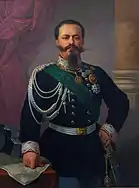
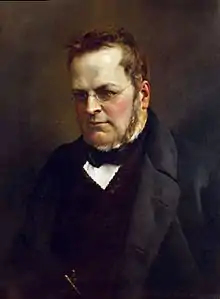
The new Kingdom of Italy obtained Great Power status. The Constitutional Law of the Kingdom of Sardinia the Albertine Statute of 1848, was extended to the whole Kingdom of Italy in 1861, and provided for basic freedoms of the new State, but electoral laws excluded the non-propertied and uneducated classes from voting. The government of the new kingdom took place in a framework of parliamentary constitutional monarchy dominated by liberal forces. As Northern Italy quickly industrialised, the South and rural areas of the North remained underdeveloped and overpopulated, forcing millions of people to migrate abroad and fuelling a large and influential diaspora. The Italian Socialist Party constantly increased in strength, challenging the traditional liberal and conservative establishment.
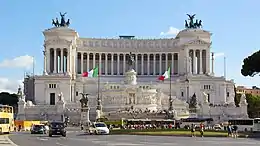
Starting from the last two decades of the 19th century, Italy developed into a colonial power by forcing under its rule Eritrea and Somalia in East Africa, Tripolitania and Cyrenaica in North Africa (later unified in the colony of Libya) and the Dodecanese islands.[108] From 2 November 1899 to 7 September 1901, Italy also participated as part of the Eight-Nation Alliance forces during the Boxer Rebellion in China; on 7 September 1901, a concession in Tientsin was ceded to the country, and on 7 June 1902, the concession was taken into Italian possession and administered by a consul. In 1913, male universal suffrage was adopted. The pre-war period dominated by Giovanni Giolitti, Prime Minister five times between 1892 and 1921, was characterized by the economic, industrial and political-cultural modernization of Italian society.
Italy, nominally allied with the German Empire and the Empire of Austria-Hungary in the Triple Alliance, in 1915 joined the Allies into World War I with a promise of substantial territorial gains, that included western Inner Carniola, former Austrian Littoral, Dalmatia as well as parts of the Ottoman Empire. The country gave a fundamental contribution to the victory of the conflict as one of the "Big Four" top Allied powers. The war was initially inconclusive, as the Italian army got stuck in a long attrition war in the Alps, making little progress and suffering very heavy losses. However, the reorganization of the army and the conscription of the so-called '99 Boys (Ragazzi del '99, all males born in 1899 who were turning 18) led to more effective Italian victories in major battles, such as on Monte Grappa and in a series of battles on the Piave river. Eventually, in October 1918, the Italians launched a massive offensive, culminating in the victory of Vittorio Veneto. The Italian victory[109][110][111] marked the end of the war on the Italian Front, secured the dissolution of the Austro-Hungarian Empire and was chiefly instrumental in ending the First World War less than two weeks later.
During the war, more than 650,000 Italian soldiers and as many civilians died[112] and the kingdom went to the brink of bankruptcy. Under the Peace Treaties of Saint-Germain, Rapallo and Rome, Italy gained a permanent seat in the League of Nations's executive council and obtained most of the promised territories, but not Dalmatia (except Zara), allowing nationalists to define the victory as "mutilated". Moreover, Italy annexed the Hungarian harbour of Fiume, that was not part of territories promised at London but had been occupied after the end of the war by Gabriele D'Annunzio.
Fascist regime
The socialist agitations that followed the devastation of the Great War, inspired by the Russian Revolution, led to counter-revolution and repression throughout Italy. The liberal establishment, fearing a Soviet-style revolution, started to endorse the small National Fascist Party, led by Benito Mussolini. In October 1922 the Blackshirts of the National Fascist Party attempted a coup named the "March on Rome" which failed but at the last minute, King Victor Emmanuel III refused to proclaim a state of siege and appointed Mussolini prime minister. Over the next few years, Mussolini banned all political parties and curtailed personal liberties, thus forming a dictatorship. These actions attracted international attention and eventually inspired similar dictatorships such as Nazi Germany and Francoist Spain.
In 1935, Mussolini invaded Ethiopia and founded the Italian East Africa, resulting in an international alienation and leading to Italy's withdrawal from the League of Nations; Italy allied with Nazi Germany and the Empire of Japan and strongly supported Francisco Franco in the Spanish civil war. In 1939, Italy annexed Albania, a de facto protectorate for decades. Italy entered World War II on 10 June 1940. After initially advancing in British Somaliland, Egypt, the Balkans and eastern fronts, the Italians were defeated in East Africa, Soviet Union and North Africa.

The Armistice of Villa Giusti, which ended fighting between Italy and Austria-Hungary at the end of World War I, resulted in Italian annexation of neighbouring parts of Yugoslavia. During the interwar period, the fascist Italian government undertook a campaign of Italianisation in the areas it annexed, which suppressed Slavic language, schools, political parties, and cultural institutions. During World War II, Italian war crimes included extrajudicial killings and ethnic cleansing[113] by deportation of about 25,000 people, mainly Jews, Croats, and Slovenians, to the Italian concentration camps, such as Rab, Gonars, Monigo, Renicci di Anghiari and elsewhere. In Italy and Yugoslavia, unlike in Germany, few war crimes were prosecuted.[114][115][116][117] Yugoslav Partisans perpetrated their own crimes during and after the war, including the foibe killings. Meanwhile, about 250,000 Italians and anti-communist Slavs fled to Italy in the Istrian exodus.
An Allied invasion of Sicily began in July 1943, leading to the collapse of the Fascist regime and the fall of Mussolini on 25 July. Mussolini was deposed and arrested by order of King Victor Emmanuel III in co-operation with the majority of the members of the Grand Council of Fascism, which passed a motion of no confidence. On 8 September, Italy signed the Armistice of Cassibile, ending its war with the Allies. The Germans helped by the Italian fascists shortly succeeded in taking control of northern and central Italy. The country remained a battlefield for the rest of the war, as the Allies were slowly moving up from the south.
In the north, the Germans set up the Italian Social Republic (RSI), a Nazi puppet state with Mussolini installed as leader after he was rescued by German paratroopers. Some Italian troops in the south were organized into the Italian Co-belligerent Army, which fought alongside the Allies for the rest of the war, while other Italian troops, loyal to Mussolini and his RSI, continued to fight alongside the Germans in the National Republican Army. As result, the country descended into civil war. Also, the post-armistice period saw the rise of a large anti-fascist resistance movement, the Resistenza, which fought a guerilla war against the German and RSI forces. In late April 1945, with total defeat looming, Mussolini attempted to escape north,[118] but was captured and summarily executed near Lake Como by Italian partisans. His body was then taken to Milan, where it was hung upside down at a service station for public viewing and to provide confirmation of his demise.[119] Hostilities ended on 29 April 1945, when the German forces in Italy surrendered. Nearly half a million Italians (including civilians) died in the conflict,[120] and the Italian economy had been all but destroyed; per capita income in 1944 was at its lowest point since the beginning of the 20th century.[121]
Republican Italy
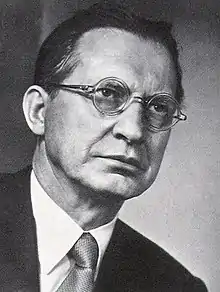
Italy became a republic after a referendum[122] held on 2 June 1946, a day celebrated since as Republic Day. This was also the first time that Italian women were entitled to vote.[123] Victor Emmanuel III's son, Umberto II, was forced to abdicate and exiled. The Republican Constitution was approved on 1 January 1948. Under the Treaty of Peace with Italy of 1947, most of the Julian March was lost to Yugoslavia and, later, the Free Territory of Trieste was divided between the two states. Italy also lost all of its colonial possessions, formally ending the Italian Empire. In 1950, Italian Somaliland was made a United Nations Trust Territory under Italian administration until 1 July 1960. The Italian border that applies today has existed since 1975, when Trieste was formally annexed to Italy.
Fears of a possible Communist takeover (especially in the United States) proved crucial for the first universal suffrage electoral outcome on 18 April 1948, when the Christian Democrats, under the leadership of Alcide De Gasperi, obtained a landslide victory.[124][125] Consequently, in 1949 Italy became a member of NATO. The Marshall Plan helped to revive the Italian economy which, until the late 1960s, enjoyed a period of sustained economic growth commonly called the "Economic Miracle". In 1957, Italy was a founding member of the European Economic Community (EEC), which became the European Union (EU) in 1993.
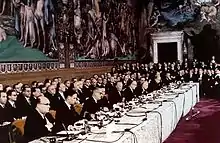
From the late 1960s until the early 1980s, the country experienced the Years of Lead, a period characterised by economic crisis (especially after the 1973 oil crisis), widespread social conflicts and terrorist massacres carried out by opposing extremist groups, with the alleged involvement of US and Soviet intelligence.[126][127][128] The Years of Lead culminated in the assassination of the Christian Democrat leader Aldo Moro in 1978 and the Bologna railway station massacre in 1980, where 85 people died.
In the 1980s, for the first time since 1945, two governments were led by non-Christian-Democrat premiers: one republican (Giovanni Spadolini) and one socialist (Bettino Craxi); the Christian Democrats remained, however, the main government party. During Craxi's government, the economy recovered and Italy became the world's fifth-largest industrial nation after it gained the entry into the Group of Seven in the 1970s. However, as a result of his spending policies, the Italian national debt skyrocketed during the Craxi era, soon passing 100% of the country's GDP.
Italy faced several terror attacks between 1992 and 1993 perpetrated by the Sicilian Mafia as a consequence of several life sentences pronounced during the "Maxi Trial", and of the new anti-mafia measures launched by the government. In 1992, two major dynamite attacks killed the judges Giovanni Falcone (23 May in the Capaci bombing) and Paolo Borsellino (19 July in the Via D'Amelio bombing).[129] One year later (May–July 1993), tourist spots were attacked, such as the Via dei Georgofili in Florence, Via Palestro in Milan, and the Piazza San Giovanni in Laterano and Via San Teodoro in Rome, leaving 10 dead and 93 injured and causing severe damage to cultural heritage such as the Uffizi Gallery. The Catholic Church openly condemned the Mafia, and two churches were bombed and an anti-Mafia priest shot dead in Rome.[130][131][132] Also in the early 1990s, Italy faced significant challenges, as voters – disenchanted with political paralysis, massive public debt and the extensive corruption system (known as Tangentopoli) uncovered by the Clean Hands (Mani Pulite) investigation – demanded radical reforms. The scandals involved all major parties, but especially those in the government coalition: the Christian Democrats, who ruled for almost 50 years, underwent a severe crisis and eventually disbanded, splitting up into several factions.[133] The Communists reorganised as a social-democratic force. During the 1990s and the 2000s, centre-right (dominated by media magnate Silvio Berlusconi) and centre-left coalitions (led by university professor Romano Prodi) alternately governed the country.
Amidst the Great Recession, Berlusconi resigned in 2011, and his conservative government was replaced by the technocratic cabinet of Mario Monti.[134] Following the 2013 general election, the Vice-Secretary of the Democratic Party Enrico Letta formed a new government at the head of a right-left Grand coalition. In 2014, challenged by the new Secretary of the PD Matteo Renzi, Letta resigned and was replaced by Renzi. The new government started important constitutional reforms such as the abolition of the Senate and a new electoral law. On 4 December the constitutional reform was rejected in a referendum and Renzi resigned; the Foreign Affairs Minister Paolo Gentiloni was appointed new Prime Minister.[135]
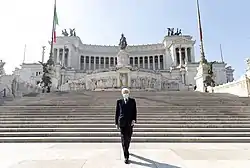
In the European migrant crisis of the 2010s, Italy was the entry point and leading destination for most asylum seekers entering the EU. From 2013 to 2018, the country took in over 700,000 migrants and refugees,[136] mainly from sub-Saharan Africa,[137] which caused great strain on the public purse and a surge in the support for far-right or eurosceptic political parties.[138][139] The 2018 general election was characterized by a strong showing of the Five Star Movement and the League and the university professor Giuseppe Conte became the Prime Minister at the head of a populist coalition between these two parties.[140] However, after only fourteen months the League withdrew its support to Conte, who formed a new unprecedented government coalition between the Five Star Movement and the centre-left.[141][142]
In 2020, Italy was severely hit by the COVID-19 pandemic.[143] From March to May, Conte's government imposed a national lockdown as a measure to limit the spread of the disease,[144][145] while further restrictions were introduced during the following winter.[146] The measures, despite being widely approved by the public opinion,[147] were also described as the largest suppression of constitutional rights in the history of the republic.[148][149] With more than 90,000 confirmed victims, Italy was one of the countries with the highest total number of deaths in the worldwide coronavirus pandemic.[150] The pandemic caused also a severe economic disruption, in which Italy resulted as one of the most affected countries.[151] Despite this, Italy, as well as other countries, has seen many protests that took place throughout the Italian territory, also leading to new regulations for the pandemic.[152]
Geography
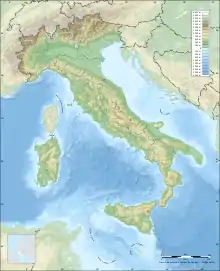
Italy is located in Southern Europe (it is also considered a part of western Europe)[19] between latitudes 35° and 47° N, and longitudes 6° and 19° E. To the north, Italy borders France, Switzerland, Austria, and Slovenia and is roughly delimited by the Alpine watershed, enclosing the Po Valley and the Venetian Plain. To the south, it consists of the entirety of the Italian Peninsula and the two Mediterranean islands of Sicily and Sardinia (the two biggest islands of the Mediterranean), in addition to many smaller islands. The sovereign states of San Marino and the Vatican City are enclaves within Italy,[153][154] while Campione d'Italia is an Italian exclave in Switzerland.[155]
The country's total area is 301,230 square kilometres (116,306 sq mi), of which 294,020 km2 (113,522 sq mi) is land and 7,210 km2 (2,784 sq mi) is water.[156] Including the islands, Italy has a coastline and border of 7,600 kilometres (4,722 miles) on the Adriatic, Ionian, Tyrrhenian seas (740 km (460 mi)), and borders shared with France (488 km (303 mi)), Austria (430 km (267 mi)), Slovenia (232 km (144 mi)) and Switzerland (740 km (460 mi)). San Marino (39 km (24 mi)) and Vatican City (3.2 km (2.0 mi)), both enclaves, account for the remainder.[156]
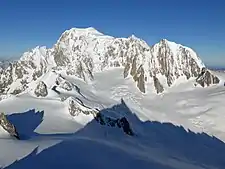
Over 35% of the Italian territory is mountainous.[157] The Apennine Mountains form the peninsula's backbone, and the Alps form most of its northern boundary, where Italy's highest point is located on Mont Blanc (Monte Bianco) (4,810 m or 15,780 ft).[note 1] Other worldwide-known mountains in Italy include the Matterhorn (Monte Cervino), Monte Rosa, Gran Paradiso in the West Alps, and Bernina, Stelvio and Dolomites along the eastern side.
The Po, Italy's longest river (652 kilometres or 405 miles), flows from the Alps on the western border with France and crosses the Padan plain on its way to the Adriatic Sea. The Po Valley is the largest plain in Italy, with 46,000 km2 (18,000 sq mi), and it represents over 70% of the total plain area in the country.[157]
Many elements of the Italian territory are of volcanic origin. Most of the small islands and archipelagos in the south, like Capraia, Ponza, Ischia, Eolie, Ustica and Pantelleria are volcanic islands. There are also active volcanoes: Mount Etna in Sicily (the largest active volcano in Europe), Vulcano, Stromboli, and Vesuvius (the only active volcano on mainland Europe).
The five largest lakes are, in order of diminishing size:[158] Garda (367.94 km2 or 142 sq mi), Maggiore (212.51 km2 or 82 sq mi, whose minor northern part is Switzerland), Como (145.9 km2 or 56 sq mi), Trasimeno (124.29 km2 or 48 sq mi) and Bolsena (113.55 km2 or 44 sq mi).
Although the country includes the Italian peninsula, adjacent islands, and most of the southern Alpine basin, some of Italy's territory extends beyond the Alpine basin and some islands are located outside the Eurasian continental shelf. These territories are the comuni of: Livigno, Sexten, Innichen, Toblach (in part), Chiusaforte, Tarvisio, Graun im Vinschgau (in part), which are all part of the Danube's drainage basin, while the Val di Lei constitutes part of the Rhine's basin and the islands of Lampedusa and Lampione are on the African continental shelf.
Waters

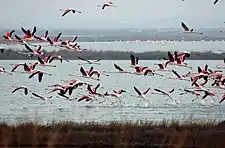
Four different seas surround the Italian Peninsula in the Mediterranean Sea from three sides: the Adriatic Sea in the east,[159] the Ionian Sea in the south,[160] and the Ligurian Sea and the Tyrrhenian Sea in the west.[161]
Including islands, Italy has a coastline of 7,900 km.[162][163][164] Italian coasts include the Amalfi Coast, Cilentan Coast, Coast of the Gods, Costa Verde, Riviera delle Palme, Riviera del Brenta, Costa Smeralda and Trabocchi Coast. The Italian Riviera includes nearly all of the coastline of Liguria, extending from the border with France near Ventimiglia eastwards to Capo Corvo, which marks the eastern end of the Gulf of La Spezia.[165][166]
The Apennines run along the entire length of the peninsula, dividing the waters into two opposite sides. On the other hand, the rivers are numerous due to the relative abundance of rains and to the presence of the Alpine chain in northern Italy with snowfields and glaciers. The fundamental watershed follows the ridge of the Alps and the Apennines and delimits five main slopes, corresponding to the seas into which the rivers flow: the Adriatic, Ionic, Tyrrhenian, Ligurian and Mediterranean sides.[167] Taking into consideration their origin, the Italian rivers can be divided into two main groups: the Alpine-Po rivers and the Apennine-island rivers.[167]
Most of the rivers of Italy drain either into the Adriatic Sea, such as the Po, Piave, Adige, Brenta, Tagliamento, and Reno, or into the Tyrrhenian, like the Arno, Tiber and Volturno. The waters from some border municipalities (Livigno in Lombardy, Innichen and Sexten in Trentino-Alto Adige/Südtirol) drain into the Black Sea through the basin of the Drava, a tributary of the Danube, and the waters from the Lago di Lei in Lombardy drain into the North Sea through the basin of the Rhine.[168]
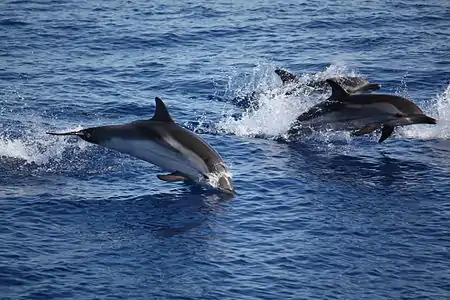
The longest Italian river is Po, which flows either 652 km (405 mi) or 682 km (424 mi) (considering the length of the right bank tributary Maira) and whose headwaters are a spring seeping from a stony hillside at Pian del Re, a flat place at the head of the Val Po under the northwest face of Monviso. The vast valley around the Po is called Po Valley (Italian: Pianura Padana or Val Padana) the main industrial area of the country; in 2002, more than 16 million people lived there, at the time nearly ⅓ of the population of Italy.[169] The second longest Italian river is Adige, which originates near Lake Resia and flows into the Adriatic Sea, after having made a north–south route, near Chioggia.[170]
In the north of the country are a number of large subalpine moraine-dammed lakes, commonly referred to as the Italian Lakes. There are more than 1000 lakes in Italy,[171] the largest of which is Garda (370 km2 or 143 sq mi). Other well-known subalpine lakes are Lake Maggiore (212.5 km2 or 82 sq mi), whose most northerly section is part of Switzerland, Como (146 km2 or 56 sq mi), one of the deepest lakes in Europe, Orta, Lugano, Iseo, and Idro.[172] Other notable lakes in the Italian peninsula are Trasimeno, Bolsena, Bracciano, Vico, Varano and Lesina in Gargano and Omodeo in Sardinia.[173]
Along the Italian coasts there are lagoons, including the Venice, Grado Lagoon and Marano lagoons in northern Adriatic, and the Orbetello lagoon on the Tuscan coast. The swamps and ponds that in the past covered vast flat areas of Italy, have largely been dried up in recent centuries;[171] the few remaining wetlands, such as the Comacchio Valleys in Emilia-Romagna or the Stagno di Cagliari in Sardinia, are protected natural environments.[171]
Volcanology


The country is situated at the meeting point of the Eurasian Plate and the African Plate, leading to considerable seismic and volcanic activity. There are 14 volcanoes in Italy, four of which are active: Etna, Stromboli, Vulcano and Vesuvius. The last is the only active volcano in mainland Europe and is most famous for the destruction of Pompeii and Herculanum in the eruption in 79 AD. Several islands and hills have been created by volcanic activity, and there is still a large active caldera, the Campi Flegrei north-west of Naples.
The high volcanic and magmatic neogenic activity is subdivided into provinces:
- Magmatic Tuscan (Monti Cimini, Tolfa and Amiata);[174][175]
- Magmatic Latium (Monti Volsini, Vico nel Lazio, Colli Albani, Roccamonfina);[175][176]
- Ultra-alkaline Umbrian Latium District (San Venanzo, Cupaello and Polino);[175][176]
- Volcanic bell (Vesuvius, Campi Flegrei, Ischia);[175][176]
- Windy arch and Tyrrhenian basin (Aeolian Islands and Tyrrhenian seamounts);[175][176]
- African-Adriatic Avampa (Channel of Sicily, Graham Island, Etna and Mount Vulture).[175][176]
Italy was the first country to exploit geothermal energy to produce electricity.[177] The high geothermal gradient that forms part of the peninsula makes potentially exploitable also other provinces: research carried out in the 1960s and 1970s identifies potential geothermal fields in Lazio and Tuscany, as well as in most volcanic islands.[177]
Environment
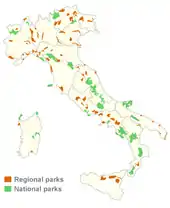
After its quick industrial growth, Italy took a long time to confront its environmental problems. After several improvements, it now ranks 84th in the world for ecological sustainability.[178] National parks cover about 5% of the country.[179]
In the last decade, Italy has become one of the world's leading producers of renewable energy, ranking as the world's fourth largest holder of installed solar energy capacity[180][181] and the sixth largest holder of wind power capacity in 2010.[182] Renewable energies now make up about 12% of the total primary and final energy consumption in Italy, with a future target share set at 17% for the year 2020.[183] However, air pollution remains a severe problem, especially in the industrialised north, reaching the tenth highest level worldwide of industrial carbon dioxide emissions in the 1990s.[184] Italy is the twelfth largest carbon dioxide producer.[185][186]
_naar_Colle_Tsa_S%C3%A8tse_in_Cogne_Valley_(Itali%C3%AB)._Zicht_op_de_omringende_alpentoppen_van_Gran_Paradiso_06.jpg.webp)
Extensive traffic and congestion in the largest metropolitan areas continue to cause severe environmental and health issues, even if smog levels have decreased dramatically since the 1970s and 1980s, and the presence of smog is becoming an increasingly rarer phenomenon and levels of sulphur dioxide are decreasing.[187]
Many watercourses and coastal stretches have also been contaminated by industrial and agricultural activity, while because of rising water levels, Venice has been regularly flooded throughout recent years. Waste from industrial activity is not always disposed of by legal means and has led to permanent health effects on inhabitants of affected areas, as in the case of the Seveso disaster. The country has also operated several nuclear reactors between 1963 and 1990 but, after the Chernobyl disaster and a referendum on the issue the nuclear programme was terminated, a decision that was overturned by the government in 2008, planning to build up to four nuclear power plants with French technology. This was in turn struck down by a referendum following the Fukushima nuclear accident.[188]
Deforestation, illegal building developments and poor land-management policies have led to significant erosion all over Italy's mountainous regions, leading to major ecological disasters like the 1963 Vajont Dam flood, the 1998 Sarno[189] and 2009 Messina mudslides. The country had a 2019 Forest Landscape Integrity Index mean score of 3.65/10, ranking it 142nd globally out of 172 countries.[190]
Biodiversity

Italy has the highest level of faunal biodiversity in Europe, with over 57,000 species recorded, representing more than a third of all European fauna.[192] Italy's varied geological structure contributes to its high climate and habitat diversity. The Italian peninsula is in the centre of the Mediterranean Sea, forming a corridor between central Europe and North Africa, and has 8,000 km (5,000 mi) of coastline. Italy also receives species from the Balkans, Eurasia, the Middle East. Italy's varied geological structure, including the Alps and the Apennines, Central Italian woodlands, and Southern Italian Garigue and Maquis shrubland, also contributes to high climate and habitat diversity.
Italian fauna includes 4,777 endemic animal species, which include the Sardinian long-eared bat, Sardinian red deer, spectacled salamander, brown cave salamander, Italian newt, Italian frog, Apennine yellow-bellied toad, Aeolian wall lizard, Sicilian wall lizard, Italian Aesculapian snake, and Sicilian pond turtle. There are 102 mammals species (most notably the Italian wolf, Marsican brown bear, Pyrenean chamois, Alpine ibex, crested porcupine, Mediterranean monk seal, Alpine marmot, Etruscan shrew, and European snow vole), 516 bird species and 56,213 invertebrate species.
The flora of Italy was traditionally estimated to comprise about 5,500 vascular plant species.[193] However, as of 2005, 6,759 species are recorded in the Data bank of Italian vascular flora.[194] Italy is a signatory to the Berne Convention on the Conservation of European Wildlife and Natural Habitats and the Habitats Directive both affording protection to Italian fauna and flora.
Climate
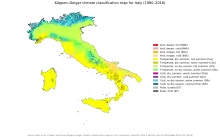
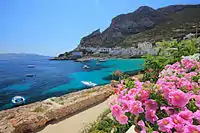
Because of the great longitudinal extension of the peninsula and the mostly mountainous internal conformation, the climate of Italy is highly diverse. In most of the inland northern and central regions, the climate ranges from humid subtropical to humid continental and oceanic. In particular, the climate of the Po valley geographical region is mostly continental, with harsh winters and hot summers.[196][197]
The coastal areas of Liguria, Tuscany and most of the South generally fit the Mediterranean climate stereotype (Köppen climate classification Csa). Conditions on peninsular coastal areas can be very different from the interior's higher ground and valleys, particularly during the winter months when the higher altitudes tend to be cold, wet, and often snowy. The coastal regions have mild winters and warm and generally dry summers, although lowland valleys can be quite hot in summer. Average winter temperatures vary from 0 °C (32 °F) on the Alps to 12 °C (54 °F) in Sicily, so average summer temperatures range from 20 °C (68 °F) to over 25 °C (77 °F). Winters can vary widely across the country with lingering cold, foggy and snowy periods in the north and milder, sunnier conditions in the south. Summers can be hot and humid across the country, particularly in the south while northern and central areas can experience occasional strong thunderstorms from spring to autumn.[198]
Politics
Italy has been a unitary parliamentary republic since 2 June 1946, when the monarchy was abolished by a constitutional referendum. The President of Italy (Presidente della Repubblica), currently Sergio Mattarella since 2015, is Italy's head of state. The President is elected for a single seven years mandate by the Parliament of Italy and some regional voters in joint session. Italy has a written democratic constitution, resulting from the work of a Constituent Assembly formed by the representatives of all the anti-fascist forces that contributed to the defeat of Nazi and Fascist forces during the Civil War.[199]
Government
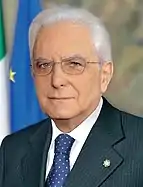
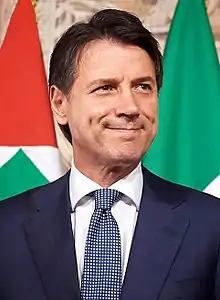
Italy has a parliamentary government based on a mixed proportional and majoritarian voting system. The parliament is perfectly bicameral: the two houses, the Chamber of Deputies that meets in Palazzo Montecitorio, and the Senate of the Republic that meets in Palazzo Madama, have the same powers. The Prime Minister, officially President of the Council of Ministers (Presidente del Consiglio dei Ministri), is Italy's head of government. The Prime Minister and the cabinet are appointed by the President of the Republic of Italy and must pass a vote of confidence in Parliament to come into office. To remain the Prime Minister has to pass also eventual further votes of confidence or no confidence in Parliament.
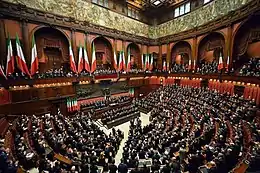
The prime minister is the President of the Council of Ministers – which holds effective executive power – and he must receive a vote of approval from it to execute most political activities. The office is similar to those in most other parliamentary systems, but the leader of the Italian government is not authorised to request the dissolution of the Parliament of Italy.
Another difference with similar offices is that the overall political responsibility for intelligence is vested in the President of the Council of Ministers. By virtue of that, the Prime Minister has exclusive power to: co-ordinate intelligence policies, determining the financial resources and strengthening national cyber security; apply and protect State secrets; authorise agents to carry out operations, in Italy or abroad, in violation of the law.[200]
A peculiarity of the Italian Parliament is the representation given to Italian citizens permanently living abroad: 12 Deputies and 6 Senators elected in four distinct overseas constituencies. In addition, the Italian Senate is characterised also by a small number of senators for life, appointed by the President "for outstanding patriotic merits in the social, scientific, artistic or literary field". Former Presidents of the Republic are ex officio life senators.
Italy's three major political parties are the Five Star Movement, the Democratic Party and the Lega. During the 2018 general election these three parties won 614 out of 630 seats available in the Chamber of Deputies and 309 out of 315 in the Senate.[201] Berlusconi's Forza Italia which formed a centre-right coalition with Matteo Salvini's Northern League and Giorgia Meloni's Brothers of Italy won most of the seats without getting the majority in parliament. The rest of the seats were taken by Five Star Movement, Matteo Renzi's Democratic Party along with Achammer and Panizza's South Tyrolean People's Party & Trentino Tyrolean Autonomist Party in a centre-left coalition and the independent Free and Equal party.
Law and criminal justice
The Italian judicial system is based on Roman law modified by the Napoleonic code and later statutes. The Supreme Court of Cassation is the highest court in Italy for both criminal and civil appeal cases. The Constitutional Court of Italy (Corte Costituzionale) rules on the conformity of laws with the constitution and is a post–World War II innovation. Since their appearance in the middle of the 19th century, Italian organised crime and criminal organisations have infiltrated the social and economic life of many regions in Southern Italy, the most notorious of which being the Sicilian Mafia, which would later expand into some foreign countries including the United States. Mafia receipts may reach 9%[202][203] of Italy's GDP.[204]
A 2009 report identified 610 comuni which have a strong Mafia presence, where 13 million Italians live and 14.6% of the Italian GDP is produced.[205][206] The Calabrian 'Ndrangheta, nowadays probably the most powerful crime syndicate of Italy, accounts alone for 3% of the country's GDP.[207] However, at 0.013 per 1,000 people, Italy has only the 47th highest murder rate[208] compared to 61 countries and the 43rd highest number of rapes per 1,000 people compared to 64 countries in the world. These are relatively low figures among developed countries.
Law enforcement
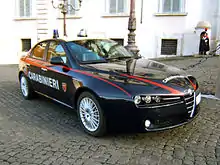
The Italian law enforcement system is complex, with multiple police forces.[209] The national policing agencies are the Polizia di Stato (State Police), the Arma dei Carabinieri, the Guardia di Finanza (Financial Guard), and the Polizia Penitenziaria (Prison Police),[210] as well as the Guardia Costiera (coast guard police).[209]
The Polizia di Stato are a civil police supervised by the Interior Ministry, while the Carabinieri is a gendarmerie supervised by the Defense Ministry; both share duties in law enforcement and the maintenance of public order.[210] Within the Carabinieri is a unit devoted to combating environmental crime.[209] The Guardia di Finanza is responsible for combating financial crime and white-collar crime,[210] as well as customs.[209] The Polizia Penitenziaria are responsible for guarding the prison system.[210] The Corpo Forestale dello Stato (State Forestry Corps) formerly existed as a separate national park ranger agency,[209][210] but was merged into the Carabinieri in 2016.[211] Although policing in Italy is primarily provided on a national basis,[210] there also exists Polizia Provinciale (provincial police) and Polizia Municipale (municipal police).[209]
Foreign relations
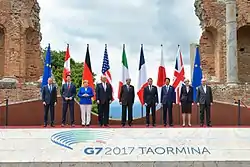
Italy is a founding member of the European Economic Community (EEC), now the European Union (EU), and of NATO. Italy was admitted to the United Nations in 1955, and it is a member and a strong supporter of a wide number of international organisations, such as the Organisation for Economic Co-operation and Development (OECD), the General Agreement on Tariffs and Trade/World Trade Organization (GATT/WTO), the Organization for Security and Co-operation in Europe (OSCE), the Council of Europe, and the Central European Initiative. Its recent or upcoming turns in the rotating presidency of international organisations include the Organization for Security and Co-operation in Europe in 2018, the G7 in 2017 and the EU Council from July to December 2014. Italy is also a recurrent non-permanent member of the UN Security Council, the most recently in 2017.
Italy strongly supports multilateral international politics, endorsing the United Nations and its international security activities. As of 2013, Italy was deploying 5,296 troops abroad, engaged in 33 UN and NATO missions in 25 countries of the world.[212] Italy deployed troops in support of UN peacekeeping missions in Somalia, Mozambique, and East Timor and provides support for NATO and UN operations in Bosnia, Kosovo and Albania. Italy deployed over 2,000 troops in Afghanistan in support of Operation Enduring Freedom (OEF) from February 2003.
Italy supported international efforts to reconstruct and stabilise Iraq, but it had withdrawn its military contingent of some 3,200 troops by 2006, maintaining only humanitarian operators and other civilian personnel. In August 2006 Italy deployed about 2,450 troops in Lebanon for the United Nations' peacekeeping mission UNIFIL.[213] Italy is one of the largest financiers of the Palestinian National Authority, contributing €60 million in 2013 alone.[214]
Military
The Italian Army, Navy, Air Force and Carabinieri collectively form the Italian Armed Forces, under the command of the Supreme Defence Council, presided over by the President of Italy. Since 2005, military service is voluntary.[215] In 2010, the Italian military had 293,202 personnel on active duty,[216] of which 114,778 are Carabinieri.[217] Total Italian military spending in 2010 ranked tenth in the world, standing at $35.8 billion, equal to 1.7% of national GDP. As part of NATO's nuclear sharing strategy Italy also hosts 90 United States B61 nuclear bombs, located in the Ghedi and Aviano air bases.[218]
The Italian Army is the national ground defence force, numbering 109,703 in 2008. Its best-known combat vehicles are the Dardo infantry fighting vehicle, the Centauro tank destroyer and the Ariete tank, and among its aircraft the Mangusta attack helicopter, in the last years deployed in EU, NATO and UN missions. It also has at its disposal many Leopard 1 and M113 armoured vehicles.
The Italian Navy in 2008 had 35,200 active personnel with 85 commissioned ships and 123 aircraft.[219] It is a blue-water navy. In modern times the Italian Navy, being a member of the EU and NATO, has taken part in many coalition peacekeeping operations around the world.
The Italian Air Force in 2008 had a strength of 43,882 and operated 585 aircraft, including 219 combat jets and 114 helicopters. A transport capability is guaranteed by a fleet of 27 C-130Js and C-27J Spartan.
An autonomous corps of the military, the Carabinieri are the gendarmerie and military police of Italy, policing the military and civilian population alongside Italy's other police forces. While the different branches of the Carabinieri report to separate ministries for each of their individual functions, the corps reports to the Ministry of Internal Affairs when maintaining public order and security.[220]
Constituent entities
Italy is constituted by 20 regions (regioni)—five of these regions having a special autonomous status that enables them to enact legislation on additional matters, 107 provinces (province) or metropolitan cities (città metropolitane), and 7,960 municipalities (comuni).[221]
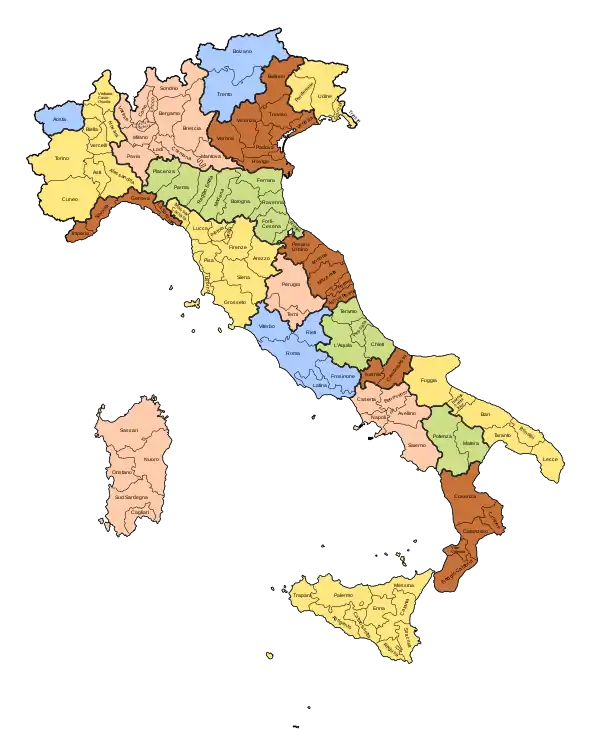
| Region | Capital | Area (km2) | Area (sq mi) | Population (January 2019) | Nominal GDP EURO billions (2016)[222] | Nominal GDP EURO per capita(2016) [223] |
|---|---|---|---|---|---|---|
| Abruzzo | L'Aquila | 10,763 | 4,156 | 1,311,580 | 32 | 24,100 |
| Aosta Valley | Aosta | 3,263 | 1,260 | 125,666 | 4 | 34,900 |
| Apulia | Bari | 19,358 | 7,474 | 4,029,053 | 72 | 17,800 |
| Basilicata | Potenza | 9,995 | 3,859 | 562,869 | 12 | 20,600 |
| Calabria | Catanzaro | 15,080 | 5,822 | 1,947,131 | 33 | 16,800 |
| Campania | Naples | 13,590 | 5,247 | 5,801,692 | 107 | 18,300 |
| Emilia-Romagna | Bologna | 22,446 | 8,666 | 4,459,477 | 154 | 34,600 |
| Friuli-Venezia Giulia | Trieste | 7,858 | 3,034 | 1,215,220 | 37 | 30,300 |
| Lazio | Rome | 17,236 | 6,655 | 5,879,082 | 186 | 31,600 |
| Liguria | Genoa | 5,422 | 2,093 | 1,550,640 | 48 | 30,800 |
| Lombardy | Milan | 23,844 | 9,206 | 10,060,574 | 367 | 36,600 |
| Marche | Ancona | 9,366 | 3,616 | 1,525,271 | 41 | 26,600 |
| Molise | Campobasso | 4,438 | 1,713 | 305,617 | 6 | 20,000 |
| Piedmont | Turin | 25,402 | 9,808 | 4,356,406 | 129 | 29,400 |
| Sardinia | Cagliari | 24,090 | 9,301 | 1,639,591 | 34 | 20,300 |
| Sicily | Palermo | 25,711 | 9,927 | 4,999,891 | 87 | 17,200 |
| Tuscany | Florence | 22,993 | 8,878 | 3,729,641 | 112 | 30,000 |
| Trentino-Alto Adige/Südtirol | Trento | 13,607 | 5,254 | 1,072,276 | 42 | 39,755 |
| Umbria | Perugia | 8,456 | 3,265 | 882,015 | 21 | 24,000 |
| Veneto | Venice | 18,399 | 7,104 | 4,905,854 | 156 | 31,700 |
Economy
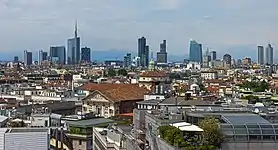
Italy has a major advanced[224] capitalist mixed economy, ranking as the third-largest in the Eurozone and the eighth-largest in the world.[225] A founding member of the G7, the Eurozone and the OECD, it is regarded as one of the world's most industrialised nations and a leading country in world trade and exports.[226][227][228] It is a highly developed country, with the world's 8th highest quality of life in 2005[33] and the 26th Human Development Index. The country is well known for its creative and innovative business,[229] a large and competitive agricultural sector[230] (with the world's largest wine production),[231] and for its influential and high-quality automobile, machinery, food, design and fashion industry.[232][233][234]
Italy is the world's sixth largest manufacturing country,[237] characterised by a smaller number of global multinational corporations than other economies of comparable size and many dynamic small and medium-sized enterprises, notoriously clustered in several industrial districts, which are the backbone of the Italian industry. This has produced a manufacturing sector often focused on the export of niche market and luxury products, that if on one side is less capable to compete on the quantity, on the other side is more capable of facing the competition from China and other emerging Asian economies based on lower labour costs, with higher quality products.[238] Italy was the world's 7th largest exporter in 2016. Its closest trade ties are with the other countries of the European Union, with whom it conducts about 59% of its total trade. Its largest EU trade partners, in order of market share, are Germany (12.9%), France (11.4%), and Spain (7.4%).[239]

The automotive industry is a significant part of the Italian manufacturing sector, with over 144,000 firms and almost 485,000 employed people in 2015,[240] and a contribution of 8.5% to Italian GDP.[241] Fiat Chrysler Automobiles or FCA is currently the world's seventh-largest auto maker.[242] The country boasts a wide range of acclaimed products, from very compact city cars to luxury supercars such as Maserati, Lamborghini, and Ferrari, which was rated the world's most powerful brand by Brand Finance.[243]
Italy is part of the European single market which represents more than 500 million consumers. Several domestic commercial policies are determined by agreements among European Union (EU) members and by EU legislation. Italy introduced the common European currency, the Euro in 2002.[244][245] It is a member of the Eurozone which represents around 330 million citizens. Its monetary policy is set by the European Central Bank.
Italy has been hit hard by the Financial crisis of 2007–08, that exacerbated the country's structural problems.[246] Effectively, after a strong GDP growth of 5–6% per year from the 1950s to the early 1970s,[247] and a progressive slowdown in the 1980-90s, the country virtually stagnated in the 2000s.[248][249] The political efforts to revive growth with massive government spending eventually produced a severe rise in public debt, that stood at over 131.8% of GDP in 2017,[250] ranking second in the EU only after the Greek one.[251] For all that, the largest chunk of Italian public debt is owned by national subjects, a major difference between Italy and Greece,[252] and the level of household debt is much lower than the OECD average.[253]
A gaping North–South divide is a major factor of socio-economic weakness.[254] It can be noted by the huge difference in statistical income between the northern and southern regions and municipalities.[255] The richest province, Alto Adige-South Tyrol, earns 152% of the national GDP per capita, while the poorest region, Calabria, 61%.[256] The unemployment rate (11.1%) stands slightly above the Eurozone average,[257] but the disaggregated figure is 6.6% in the North and 19.2% in the South.[258] The youth unemployment rate (31.7% in March 2018) is extremely high compared to EU standards.[259]
Italy has a strong cooperative sector, with the largest share of the population (4.5%) employed by a cooperative in the EU.[260]
Agriculture
.jpeg.webp)
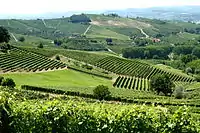
According to the last national agricultural census, there were 1.6 million farms in 2010 (−32.4% since 2000) covering 12.7 million hectares (63% of which are located in Southern Italy).[261] The vast majority (99%) are family-operated and small, averaging only 8 hectares in size.[261] Of the total surface area in agricultural use (forestry excluded), grain fields take up 31%, olive tree orchards 8.2%, vineyards 5.4%, citrus orchards 3.8%, sugar beets 1.7%, and horticulture 2.4%. The remainder is primarily dedicated to pastures (25.9%) and feed grains (11.6%).[261]
Italy is the world's largest wine producer,[262] and one of the leading in olive oil, fruits (apples, olives, grapes, oranges, lemons, pears, apricots, hazelnuts, peaches, cherries, plums, strawberries and kiwifruits), and vegetables (especially artichokes and tomatoes). The most famous Italian wines are probably the Tuscan Chianti and the Piedmontese Barolo. Other famous wines are Barbaresco, Barbera d'Asti, Brunello di Montalcino, Frascati, Montepulciano d'Abruzzo, Morellino di Scansano, and the sparkling wines Franciacorta and Prosecco.
Quality goods in which Italy specialises, particularly the already mentioned wines and regional cheeses, are often protected under the quality assurance labels DOC/DOP. This geographical indication certificate, which is attributed by the European Union, is considered important in order to avoid confusion with low-quality mass-produced ersatz products.
Infrastructure

.jpg.webp)
In 2004 the transport sector in Italy generated a turnover of about 119.4 billion euros, employing 935,700 persons in 153,700 enterprises. Regarding the national road network, in 2002 there were 668,721 km (415,524 mi) of serviceable roads in Italy, including 6,487 km (4,031 mi) of motorways, state-owned but privately operated by Atlantia. In 2005, about 34,667,000 passenger cars (590 cars per 1,000 people) and 4,015,000 goods vehicles circulated on the national road network.[264]
The national railway network, state-owned and operated by Rete Ferroviaria Italiana (FSI), in 2008 totalled 16,529 km (10,271 mi) of which 11,727 km (7,287 mi) is electrified, and on which 4,802 locomotives and railcars run. The main public operator of high-speed trains is Trenitalia, part of FSI. Higher-speed trains are divided into three categories: Frecciarossa (English: red arrow) trains operate at a maximum speed of 300 km/h on dedicated high-speed tracks; Frecciargento (English: silver arrow) trains operate at a maximum speed of 250 km/h on both high-speed and mainline tracks; and Frecciabianca (English: white arrow) trains operate on high-speed regional lines at a maximum speed of 200 km/h. Italy has 11 rail border crossings over the Alpine mountains with its neighbouring countries.
Italy is one of the countries with the most vehicles per capita, with 690 per 1000 people in 2010.[265] The national inland waterways network comprised 2,400 km (1,491 mi) of navigable rivers and channels for various types of commercial traffic in 2012.[266]
Italy's largest airline is Alitalia,[267] which serves 97 destinations (as of October 2019) and also operates a regional subsidiary under the Alitalia CityLiner brand. The country also has regional airlines (such as Air Dolomiti), low-cost carriers, and Charter and leisure carriers (including Neos, Blue Panorama Airlines and Poste Air Cargo. Major Italian cargo operators are Alitalia Cargo and Cargolux Italia.
Italy is the fifth in Europe by number of passengers by air transport, with about 148 million passengers or about 10% of the European total in 2011.[268] In 2012 there were 130 airports in Italy, including the two hubs of Malpensa International in Milan and Leonardo da Vinci International in Rome. In 2004 there were 43 major seaports, including the seaport of Genoa, the country's largest and second largest in the Mediterranean Sea. In 2005 Italy maintained a civilian air fleet of about 389,000 units and a merchant fleet of 581 ships.[264]

Italy does not invest enough to maintain its drinking water supply. The Galli Law, passed in 1993, aimed at raising the level of investment and to improve service quality by consolidating service providers, making them more efficient and increasing the level of cost recovery through tariff revenues. Despite these reforms, investment levels have declined and remain far from sufficient.[269][270][271]
Italy has been the final destination of the Silk Road for many centuries. In particular, the construction of the Suez Canal intensified sea trade with East Africa and Asia from the 19th century. Since the end of the Cold War and increasing European integration, the trade relations, which were often interrupted in the 20th century, have intensified again and the northern Italian ports such as the deep-water port of Trieste in the northernmost part of the Mediterranean with its extensive rail connections to Central and Eastern Europe are once again the destination of government subsidies and significant foreign investment.[272][273][274][275][276][277]
Energy

Eni, with operations in 79 countries, is one of the seven "Supermajor" oil companies in the world, and one of the world's largest industrial companies.[278] The Val d'Agri area, Basilicata, hosts he largest onshore hydrocarbon field in Europe.[280]
Moderate natural gas reserves, mainly in the Po Valley and offshore Adriatic Sea, have been discovered in recent years and constitute the country's most important mineral resource.
Italy is one of the world's leading producers of pumice, pozzolana, and feldspar.[281] Another notable mineral resource is marble, especially the world-famous white Carrara marble from the Massa and Carrara quarries in Tuscany. Italy needs to import about 80% of its energy requirements.[282][283][284]
In the last decade, Italy has become one of the world's largest producers of renewable energy, ranking as the second largest producer in the European Union and the ninth in the world. Wind power, hydroelectricity, and geothermal power are also important sources of electricity in the country. Renewable sources account for the 27.5% of all electricity produced in Italy, with hydro alone reaching 12.6%, followed by solar at 5.7%, wind at 4.1%, bioenergy at 3.5%, and geothermal at 1.6%.[286] The rest of the national demand is covered by fossil fuels (38.2% natural gas, 13% coal, 8.4% oil) and by imports.[286]
Solar energy production alone accounted for almost 9% of the total electric production in the country in 2014, making Italy the country with the highest contribution from solar energy in the world.[285] The Montalto di Castro Photovoltaic Power Station, completed in 2010, is the largest photovoltaic power station in Italy with 85 MW. Other examples of large PV plants in Italy are San Bellino (70.6 MW), Cellino san Marco (42.7 MW) and Sant’ Alberto (34.6 MW).[287] Italy was also the first country to exploit geothermal energy to produce electricity.[177]
Italy has managed four nuclear reactors until the 1980s. However, nuclear power in Italy has been abandoned following a 1987 referendum (in the wake of the 1986 Chernobyl disaster in Soviet Ukraine). The national power company Enel operates several nuclear reactors in Spain, Slovakia and France,[288][289] managing it to access nuclear power and direct involvement in design, construction, and operation of the plants without placing reactors on Italian territory.[289]
Science and technology
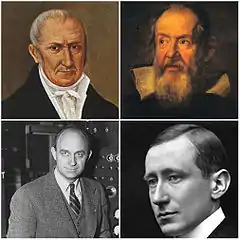
Through the centuries, Italy has fostered the scientific community that produced many major discoveries in physics and the other sciences. During the Renaissance Italian polymaths such as Leonardo da Vinci (1452–1519), Michelangelo (1475–1564) and Leon Battista Alberti (1404–1472) made important contributions to a variety of fields, including biology, architecture, and engineering. Galileo Galilei (1564–1642), a physicist, mathematician and astronomer, played a major role in the Scientific Revolution. His achievements include key improvements to the telescope and consequent astronomical observations, and ultimately the triumph of Copernicanism over the Ptolemaic model.
Other astronomers suchs as Giovanni Domenico Cassini (1625–1712) and Giovanni Schiaparelli (1835–1910) made many important discoveries about the Solar System. In mathematics, Joseph Louis Lagrange (born Giuseppe Lodovico Lagrangia, 1736–1813) was active before leaving Italy. Fibonacci (c. 1170 – c. 1250), and Gerolamo Cardano (1501–1576) made fundamental advances in mathematics. Luca Pacioli established accounting to the world. Physicist Enrico Fermi (1901–1954), a Nobel prize laureate, led the team in Chicago that developed the first nuclear reactor and is also noted for his many other contributions to physics, including the co-development of the quantum theory and was one of the key figures in the creation of the nuclear weapon. He, Emilio G. Segrè (1905–1989) who discovered the elements technetium and astatine, and the antiproton), Bruno Rossi (1905–1993) a pioneer in Cosmic Rays and X-ray astronomy) and a number of Italian physicists were forced to leave Italy in the 1930s by Fascist laws against Jews.[294]
Other prominent physicists include: Amedeo Avogadro (most noted for his contributions to molecular theory, in particular the Avogadro's law and the Avogadro constant), Evangelista Torricelli (inventor of barometer), Alessandro Volta (inventor of electric battery), Guglielmo Marconi (inventor of radio), Galileo Ferraris and Antonio Pacinotti, pioneers of the induction motor, Alessandro Cruto, pioneer of light bulb and Innocenzo Manzetti, eclectic pioneer of auto and robotics, Ettore Majorana (who discovered the Majorana fermions), Carlo Rubbia (1984 Nobel Prize in Physics for work leading to the discovery of the W and Z particles at CERN). Antonio Meucci is known for developing a voice-communication device which is often credited as the first telephone.[295][296] Pier Giorgio Perotto in 1964 designed one of the first desktop programmable calculators, the Programma 101.[297][298][299] In biology, Francesco Redi has been the first to challenge the theory of spontaneous generation by demonstrating that maggots come from eggs of flies and he described 180 parasites in details and Marcello Malpighi founded microscopic anatomy, Lazzaro Spallanzani conducted important research in bodily functions, animal reproduction, and cellular theory, Camillo Golgi, whose many achievements include the discovery of the Golgi complex, paved the way to the acceptance of the Neuron doctrine, Rita Levi-Montalcini discovered the nerve growth factor (awarded 1986 Nobel Prize in Physiology or Medicine). In chemistry, Giulio Natta received the Nobel Prize in Chemistry in 1963 for his work on high polymers. Giuseppe Occhialini received the Wolf Prize in Physics for the discovery of the pion or pi-meson decay in 1947. Ennio de Giorgi, a Wolf Prize in Mathematics recipient in 1990, solved Bernstein's problem about minimal surfaces and the 19th Hilbert problem on the regularity of solutions of Elliptic partial differential equations.
There are numerous technology parks in Italy such as the Science and Technology Parks Kilometro Rosso (Bergamo), the AREA Science Park (Trieste), The VEGA-Venice Gateway for Science and Technology (Venezia), the Toscana Life Sciences (Siena), the Technology Park of Lodi Cluster (Lodi), and the Technology Park of Navacchio (Pisa).[300] ELETTRA, Eurac Research, ESA Centre for Earth Observation, Institute for Scientific Interchange, International Centre for Genetic Engineering and Biotechnology, Centre for Maritime Research and Experimentation and the International Centre for Theoretical Physics conduct basic research. Trieste has the highest percentage of researchers in Europe in relation to the population.[301]
Tourism

Italy is the fifth most visited country in the world, with a total of 52.3 million international arrivals in 2016.[303] The total contribution of travel & tourism to GDP (including wider effects from investment, the supply chain and induced income impacts) was EUR162.7bn in 2014 (10.1% of GDP) and generated 1,082,000 jobs directly in 2014 (4.8% of total employment).[304]
Italy is well known for its cultural and environmental tourist routes and is home to 55 UNESCO World Heritage Sites, the most in the world.[305] Rome is the 3rd most visited city in Europe and the 12th in the world, with 9.4 million arrivals in 2017 while Milan is the 27th worldwide with 6.8 million tourists.[306] In addition, Venice and Florence are also among the world's top 100 destinations.
Demographics
_alt_colours.jpg.webp)
At the beginning of 2020, Italy had 60,317,116 inhabitants.[4] The resulting population density, at 202 inhabitants per square kilometre (520/sq mi), is higher than that of most Western European countries. However, the distribution of the population is widely uneven. The most densely populated areas are the Po Valley (that accounts for almost a half of the national population) and the metropolitan areas of Rome and Naples, while vast regions such as the Alps and Apennines highlands, the plateaus of Basilicata and the island of Sardinia are very sparsely populated.
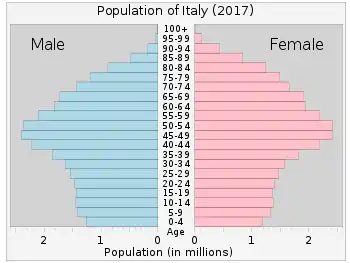
The population of Italy almost doubled during the 20th century, but the pattern of growth was extremely uneven because of large-scale internal migration from the rural South to the industrial cities of the North, a phenomenon which happened as a consequence of the Italian economic miracle of the 1950–1960s. High fertility and birth rates persisted until the 1970s, after which they started to decline. The population rapidly aged; by 2010, one in five Italians was over 65 years old, and the country currently has the fifth oldest population in the world, with a median age of 46.5 years.[307][308] However, in recent years Italy has experienced significant growth in birth rates.[309] The total fertility rate has also climbed from an all-time low of 1.18 children per woman in 1995 to 1.41 in 2008,[310] albeit still below the replacement rate of 2.1 and considerably below the high of 5.06 children born per woman in 1883.[311] Nevertheless, the total fertility rate is expected to reach 1.6–1.8 in 2030.[312]
From the late 19th century until the 1960s Italy was a country of mass emigration. Between 1898 and 1914, the peak years of Italian diaspora, approximately 750,000 Italians emigrated each year.[313] The diaspora concerned more than 25 million Italians and it is considered the biggest mass migration of contemporary times.[314] As a result, today more than 4.1 million Italian citizens are living abroad,[315] while at least 60 million people of full or part Italian ancestry live outside of Italy, most notably in Argentina,[316] Brazil,[317] Uruguay,[318] Venezuela,[319] the United States,[320] Canada,[321] Australia[322] and France.[323]
Metropolitan cities and larger urban zone
| Metropolitan city | Region | Area (km2) | Population (1 January 2019) | Functional Urban Areas (FUA) Population (2016) |
|---|---|---|---|---|
| Rome | Lazio | 5,352 | 4,342,212 | 4,414,288 |
| Milan | Lombardy | 1,575 | 3,250,315 | 5,111,481 |
| Naples | Campania | 1,171 | 3,084,890 | 3,418,061 |
| Turin | Piedmont | 6,829 | 2,259,523 | 1,769,475 |
| Palermo | Sicily | 5,009 | 1,252,588 | 1,033,226 |
| Bari | Apulia | 3,821 | 1,251,994 | 749,723 |
| Catania | Sicily | 3,574 | 1,107,702 | 658,805 |
| Florence | Tuscany | 3,514 | 1,011,349 | 807,896 |
| Bologna | Emilia-Romagna | 3,702 | 1,014,619 | 775,247 |
| Genoa | Liguria | 1,839 | 841,180 | 713,243 |
| Venice | Veneto | 2,462 | 853,338 | 561,697 |
| Messina | Sicily | 3,266 | 626,876 | 273,680 |
| Reggio Calabria | Calabria | 3,183 | 548,009 | 221,139 |
| Cagliari | Sardinia | 1,248 | 431,038 | 488,954 |
Immigration
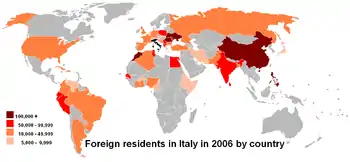
In 2016, Italy had about 5.05 million foreign residents,[326] making up 8.3% of the total population. The figures include more than half a million children born in Italy to foreign nationals (second generation immigrants) but exclude foreign nationals who have subsequently acquired Italian citizenship;[327] in 2016, about 201,000 people became Italian citizens,[328] compared to 130,000 in 2014.[329] The official figures also exclude illegal immigrants, who estimated to number at least 670,000 as of 2008.[330]
Starting from the early 1980s, until then a linguistically and culturally homogeneous society, Italy begun to attract substantial flows of foreign immigrants.[331] After the fall of the Berlin Wall and, more recently, the 2004 and 2007 enlargements of the European Union, large waves of migration originated from the former socialist countries of Eastern Europe (especially Romania, Albania, Ukraine and Poland). An equally important source of immigration is neighbouring North Africa (in particular, Morocco, Egypt and Tunisia), with soaring arrivals as a consequence of the Arab Spring. Furthermore, in recent years, growing migration fluxes from Asia-Pacific (notably China[332] and the Philippines) and Latin America have been recorded.
Currently, about one million Romanian citizens (around 10% of them being ethnic Romani people[333]) are officially registered as living in Italy, representing thus the most important individual country of origin, followed by Albanians and Moroccans with about 500,000 people each. The number of unregistered Romanians is difficult to estimate, but the Balkan Investigative Reporting Network suggested in 2007 that there might have been half a million or more.[334][note 2]
As of 2010, the foreign born population of Italy was from the following regions: Europe (54%), Africa (22%), Asia (16%), the Americas (8%) and Oceania (0.06%). The distribution of immigrants is largely uneven in Italy: 87% live in the northern and central parts of the country (the most economically developed areas), while only 13% live in the southern half.
Languages
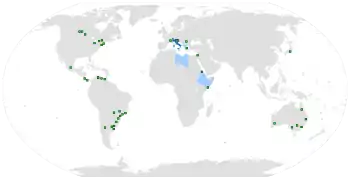
Italy's official language is Italian, as stated by the framework law no. 482/1999[336] and Trentino Alto-Adige's special Statute,[337] which is adopted with a constitutional law. Around the world there are an estimated 64 million native Italian speakers[338][339][340] and another 21 million who use it as a second language.[341] Italian is often natively spoken in a regional variety, not to be confused with Italy's regional and minority languages;[342][343] however, the establishment of a national education system led to a decrease in variation in the languages spoken across the country during the 20th century. Standardisation was further expanded in the 1950s and 1960s due to economic growth and the rise of mass media and television (the state broadcaster RAI helped set a standard Italian).
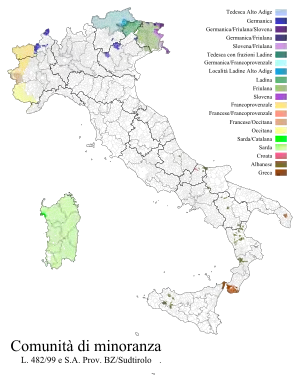
Twelve "historical minority languages" (minoranze linguistiche storiche) are formally recognised: Albanian, Catalan, German, Greek, Slovene, Croatian, French, Franco-Provençal, Friulian, Ladin, Occitan and Sardinian.[336] Four of these also enjoy a co-official status in their respective region: French in the Aosta Valley;[345] German in South Tyrol, and Ladin as well in some parts of the same province and in parts of the neighbouring Trentino;[346] and Slovene in the provinces of Trieste, Gorizia and Udine.[347] A number of other Ethnologue, ISO and UNESCO languages are not recognised by Italian law. Like France, Italy has signed the European Charter for Regional or Minority Languages, but has not ratified it.[348]
Because of recent immigration, Italy has sizeable populations whose native language is not Italian, nor a regional language. According to the Italian National Institute of Statistics, Romanian is the most common mother tongue among foreign residents in Italy: almost 800,000 people speak Romanian as their first language (21.9% of the foreign residents aged 6 and over). Other prevalent mother tongues are Arabic (spoken by over 475,000 people; 13.1% of foreign residents), Albanian (380,000 people) and Spanish (255,000 people).[349]
Religion
In 2017, the proportion of Italians who identified themselves as Roman Catholic Christians was 74.4%.[354] Since 1985, Roman Catholicism is no longer officially the state religion.[355] Italy has the fifth world's largest Roman Catholic population, and the largest Catholic nation in Europe.[356]
The Holy See, the episcopal jurisdiction of Rome, contains the central government of the Roman Catholic Church. It is recognised by other subjects of international law as a sovereign entity, headed by the Pope, who is also the Bishop of Rome, with which diplomatic relations can be maintained.[357][358] Often incorrectly referred to as "the Vatican", the Holy See is not the same entity as the Vatican City State, which came into existence only in 1929.
In 2011, minority Christian faiths in Italy included an estimated 1.5 million Orthodox Christians, or 2.5% of the population;[359] 500,000 Pentecostals and Evangelicals (of whom 400,000 are members of the Assemblies of God), 251,192 Jehovah's Witnesses,[360] 30,000 Waldensians,[361] 25,000 Seventh-day Adventists, 26,925 Latter-day Saints, 15,000 Baptists (plus some 5,000 Free Baptists), 7,000 Lutherans, 4,000 Methodists (affiliated with the Waldensian Church).[362]
One of the longest-established minority religious faiths in Italy is Judaism, Jews having been present in Ancient Rome since before the birth of Christ. Italy has for centuries welcomed Jews expelled from other countries, notably Spain. However, about 20% of Italian Jews were killed during the Holocaust.[363] This, together with the emigration which preceded and followed World War II, has left only around 28,400 Jews in Italy.[364]
Soaring immigration in the last two decades has been accompanied by an increase in non-Christian faiths. There are more than 800,000 followers of faiths originating in the Indian subcontinent with some 70,000 Sikhs with 22 gurdwaras across the country.[366]
The Italian state, as a measure to protect religious freedom, devolves shares of income tax to recognised religious communities, under a regime known as Eight per thousand. Donations are allowed to Christian, Jewish, Buddhist and Hindu communities; however, Islam remains excluded, since no Muslim communities have yet signed a concordat with the Italian state.[367] Taxpayers who do not wish to fund a religion contribute their share to the state welfare system.[368]
Education
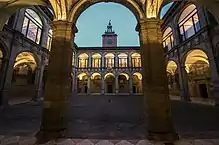
Education in Italy is free and mandatory from ages six to sixteen,[369] and consists of five stages: kindergarten (scuola dell'infanzia), primary school (scuola primaria), lower secondary school (scuola secondaria di primo grado, upper secondary school (scuola secondaria di secondo grado) and university (università).[370]
Primary education lasts eight years. Students are given a basic education in Italian, English, mathematics, natural sciences, history, geography, social studies, physical education and visual and musical arts. Secondary education lasts for five years and includes three traditional types of schools focused on different academic levels: the liceo prepares students for university studies with a classical or scientific curriculum, while the istituto tecnico and the Istituto professionale prepare pupils for vocational education. In 2012, the Italian secondary education was evaluated as slightly below the OECD average, with a strong and steady improvement in science and mathematics results since 2003;[371] however, a wide gap exists between northern schools, which performed significantly better than the national average (among the best in the world in some subjects), and schools in the South, that had much poorer results.[372]
Tertiary education in Italy is divided between public universities, private universities and the prestigious and selective superior graduate schools, such as the Scuola Normale Superiore di Pisa. 33 Italian universities were ranked among the world's top 500 in 2019, the third-largest number in Europe after the United Kingdom and Germany.[373] Bologna University, founded in 1088, is the oldest university in continuous operation,[374] as well as one of the leading academic institutions in Italy and Europe.[375] The Bocconi University, Università Cattolica del Sacro Cuore, LUISS, Polytechnic University of Turin, Polytechnic University of Milan, Sapienza University of Rome, and University of Milan are also ranked among the best in the world.[376]
Health
The Italian state runs a universal public healthcare system since 1978.[378] However, healthcare is provided to all citizens and residents by a mixed public-private system. The public part is the Servizio Sanitario Nazionale, which is organised under the Ministry of Health and administered on a devolved regional basis. Healthcare spending in Italy accounted for 9.2% of the national GDP in 2012, very close the OECD countries' average of 9.3%.[379] Italy in 2000 ranked as having the world's 2nd best healthcare system,[378][380] and the world's 2nd best healthcare performance.
Life expectancy in Italy is 80 for males and 85 for females, placing the country 5th in the world for life expectancy.[381] In comparison to other Western countries, Italy has a relatively low rate of adult obesity (below 10%[382]), as there are several health benefits of the Mediterranean diet.[383] The proportion of daily smokers was 22% in 2012, down from 24.4% in 2000 but still slightly above the OECD average.[379] Smoking in public places including bars, restaurants, night clubs and offices has been restricted to specially ventilated rooms since 2005.[384] In 2013, UNESCO added the Mediterranean diet to the Representative List of the Intangible Cultural Heritage of Humanity of Italy (promoter), Morocco, Spain, Portugal, Greece, Cyprus and Croatia.[385][386]
North-South gap
In the decades following the unification of Italy, the northern regions of the country, Lombardy, Piedmont and Liguria in particular, began a process of industrialization and economic development while the southern regions remained behind. Due to the growing economic and social gap, the southern question is beginning to be talked about[387] The imbalance between North and South, which widened steadily in the first post-unification century, was reduced in the sixties and seventies also through the construction of public works, the implementation of agrarian and scholastic reforms,[388] the expansion of industrialization and the improved living conditions of the population. This convergence process was interrupted, however, in the 1980s. To date, the per capita GDP of the South is just 58% of that of the Center-North,[389] while the unemployment rate is more than double (6.7% in the North against 14.9% in the South).[390]
A study by Censis attributes to the pervasive presence of criminal organizations an important role in the delay of Southern Italy, they estimate an annual loss of wealth of 2.5% in the South in the period 1981-2003 due to the presence of such organizations and evaluating that without of these, the per capita GDP of the South would have reached that of the North.[391]
Culture
Italy is considered one of the birthplaces of western civilization and a cultural superpower.[392] Divided by politics and geography for centuries until its eventual unification in 1861, Italy's culture has been shaped by a multitude of regional customs and local centres of power and patronage.[393] Italy has had a central role in Western culture for centuries and is still recognised for its cultural traditions and artists. During the Middle Ages and the Renaissance, a number of magnificent courts competed for attracting the best architects, artists and scholars, thus producing a great legacy of monuments, paintings, music and literature. Despite the political and social isolation of these courts, Italy's contribution to the cultural and historical heritage of Europe and the world remain immense.[394]
Italy has more UNESCO World Heritage Sites (55) than any other country in the world, and has rich collections of art, culture and literature from many periods. The country has had a broad cultural influence worldwide, also because numerous Italians emigrated to other places during the Italian diaspora. Furthermore, Italy has, overall, an estimated 100,000 monuments of any sort (museums, palaces, buildings, statues, churches, art galleries, villas, fountains, historic houses and archaeological remains),[395] and according to some estimates the nation is home to half the world's great art treasures.[396]
Architecture
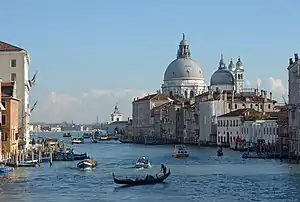
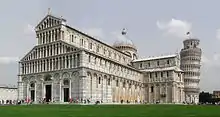
Italy is known for its considerable architectural achievements,[397] such as the construction of arches, domes and similar structures during ancient Rome, the founding of the Renaissance architectural movement in the late-14th to 16th centuries, and being the homeland of Palladianism, a style of construction which inspired movements such as that of Neoclassical architecture, and influenced the designs which noblemen built their country houses all over the world, notably in the UK, Australia and the US during the late 17th to early 20th centuries.
Along with pre-historic architecture, the first people in Italy to truly begin a sequence of designs were the Greeks and the Etruscans, progressing to classical Roman,[398] then to the revival of the classical Roman era during the Renaissance and evolving into the Baroque era. The Christian concept of a Basilica, a style of church architecture that came to dominate the early Middle Ages, was invented in Rome. They were known for being long, rectangular buildings, which were built in an almost ancient Roman style, often rich in mosaics and decorations. The early Christians' art and architecture was also widely inspired by that of the pagan Romans; statues, mosaics and paintings decorated all their churches.[399] The first significant buildings in the medieval Romanesque style were churches built in Italy during the 800's. Byzantine architecture was also widely diffused in Italy. The Byzantines kept Roman principles of architecture and art alive, and the most famous structure from this period is the Basilica of St. Mark in Venice.
The Romanesque movement, which went from approximately 800 AD to 1100 AD, was one of the most fruitful and creative periods in Italian architecture, when several masterpieces, such as the Leaning Tower of Pisa in the Piazza dei Miracoli, and the Basilica of Sant'Ambrogio in Milan were built. It was known for its usage of the Roman arches, stained glass windows, and also its curved columns which commonly featured in cloisters. The main innovation of Italian Romanesque architecture was the vault, which had never been seen before in the history of Western architecture.[400]
The greatest flowering of Italian architecture took place during the Renaissance. Filippo Brunelleschi made great contributions to architectural design with his dome for the Cathedral of Florence, a feat of engineering that had not been accomplished since antiquity.[401] A popular achievement of Italian Renaissance architecture was St. Peter's Basilica, originally designed by Donato Bramante in the early 16th century. Also, Andrea Palladio influenced architects throughout western Europe with the villas and palaces he designed in the middle and late 16th century; the city of Vicenza, with its twenty-three buildings designed by Palladio, and twenty-four Palladian Villas of the Veneto are listed by UNESCO as part of a World Heritage Site named City of Vicenza and the Palladian Villas of the Veneto.[402]
The Baroque period produced several outstanding Italian architects in the 17th century, especially known for their churches. The most original work of all late Baroque and Rococo architecture is the Palazzina di caccia di Stupinigi, dating back to the 18th century.[403] Luigi Vanvitelli began in 1752 the construction of the Royal Palace of Caserta. In this large complex, the grandiose Baroque style interiors and gardens are opposed to a more sober building envelope.[404] In the late 18th and early 19th centuries Italy was affected by the Neoclassical architectural movement. Everything from villas, palaces, gardens, interiors and art began to be based on Roman and Greek themes.[405]
During the Fascist period, the so-called "Novecento movement" flourished, based on the rediscovery of imperial Rome, with figures such as Gio Ponti and Giovanni Muzio. Marcello Piacentini, responsible for the urban transformations of several cities in Italy and remembered for the disputed Via della Conciliazione in Rome, devised a form of simplified Neoclassicism.[406]
Visual art
_-_The_Last_Supper_(1495-1498).jpg.webp)
The history of Italian visual arts is significant to the history of Western painting. Roman art was influenced by Greece and can in part be taken as a descendant of ancient Greek painting. Roman painting does have its own unique characteristics. The only surviving Roman paintings are wall paintings, many from villas in Campania, in Southern Italy. Such paintings can be grouped into four main "styles" or periods[407] and may contain the first examples of trompe-l'œil, pseudo-perspective, and pure landscape.[408]
Panel painting becomes more common during the Romanesque period, under the heavy influence of Byzantine icons. Towards the middle of the 13th century, Medieval art and Gothic painting became more realistic, with the beginnings of interest in the depiction of volume and perspective in Italy with Cimabue and then his pupil Giotto. From Giotto onwards, the treatment of composition by the best painters also became much more free and innovative. The two are considered to be the two great medieval masters of painting in western culture.
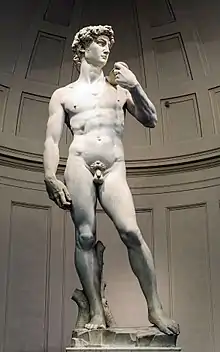
The Italian Renaissance is said by many to be the golden age of painting; roughly spanning the 14th through the mid-17th centuries with a significant influence also out of the borders of modern Italy. In Italy artists like Paolo Uccello, Fra Angelico, Masaccio, Piero della Francesca, Andrea Mantegna, Filippo Lippi, Giorgione, Tintoretto, Sandro Botticelli, Leonardo da Vinci, Michelangelo Buonarroti, Raphael, Giovanni Bellini, and Titian took painting to a higher level through the use of perspective, the study of human anatomy and proportion, and through their development of an unprecedented refinement in drawing and painting techniques. Michelangelo was an active sculptor from about 1500 to 1520, and his great masterpieces including his David, Pietà, Moses. Other prominent Renaissance sculptors include Lorenzo Ghiberti, Luca Della Robbia, Donatello, Filippo Brunelleschi and Andrea del Verrocchio.
In the 15th and 16th centuries, the High Renaissance gave rise to a stylised art known as Mannerism. In place of the balanced compositions and rational approach to perspective that characterised art at the dawn of the 16th century, the Mannerists sought instability, artifice, and doubt. The unperturbed faces and gestures of Piero della Francesca and the calm Virgins of Raphael are replaced by the troubled expressions of Pontormo and the emotional intensity of El Greco.
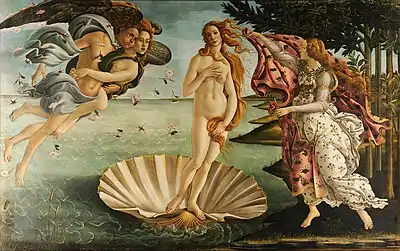
In the 17th century, among the greatest painters of Italian Baroque are Caravaggio, Annibale Carracci, Artemisia Gentileschi, Mattia Preti, Carlo Saraceni and Bartolomeo Manfredi. Subsequently, in the 18th century, Italian Rococo was mainly inspired by French Rococo, since France was the founding nation of that particular style, with artists such as Giovanni Battista Tiepolo and Canaletto. Italian Neoclassical sculpture focused, with Antonio Canova's nudes, on the idealist aspect of the movement.
In the 19th century, major Italian Romantic painters were Francesco Hayez, Giuseppe Bezzuoli and Francesco Podesti. Impressionism was brought from France to Italy by the Macchiaioli, led by Giovanni Fattori, and Giovanni Boldini; Realism by Gioacchino Toma and Giuseppe Pellizza da Volpedo. In the 20th century, with Futurism, primarily through the works of Umberto Boccioni and Giacomo Balla, Italy rose again as a seminal country for artistic evolution in painting and sculpture. Futurism was succeeded by the metaphysical paintings of Giorgio de Chirico, who exerted a strong influence on the Surrealists and generations of artists to follow like Bruno Caruso and Renato Guttuso.
Literature
Formal Latin literature began in 240 BC, when the first stage play was performed in Rome.[409] Latin literature was, and still is, highly influential in the world, with numerous writers, poets, philosophers, and historians, such as Pliny the Elder, Pliny the Younger, Virgil, Horace, Propertius, Ovid and Livy. The Romans were also famous for their oral tradition, poetry, drama and epigrams.[410] In early years of the 13th century, St. Francis of Assisi was considered the first Italian poet by literary critics, with his religious song Canticle of the Sun.[411]
Another Italian voice originated in Sicily. At the court of Emperor Frederick II, who ruled the Sicilian kingdom during the first half of the 13th century, lyrics modelled on Provençal forms and themes were written in a refined version of the local vernacular. The most important of these poets was the notary Giacomo da Lentini, inventor of the sonnet form, though the most famous early sonneteer was Petrarch.[412]
Guido Guinizelli is considered the founder of the Dolce Stil Novo, a school that added a philosophical dimension to traditional love poetry. This new understanding of love, expressed in a smooth, pure style, influenced Guido Cavalcanti and the Florentine poet Dante Alighieri, who established the basis of the modern Italian language; his greatest work, the Divine Comedy, is considered among the foremost literary statements produced in Europe during the Middle Ages; furthermore, the poet invented the difficult terza rima. The two great writers of the 14th century, Petrarch and Giovanni Boccaccio, sought out and imitated the works of antiquity and cultivated their own artistic personalities. Petrarch achieved fame through his collection of poems, Il Canzoniere. Petrarch's love poetry served as a model for centuries. Equally influential was Boccaccio's The Decameron, one of the most popular collections of short stories ever written.[413]
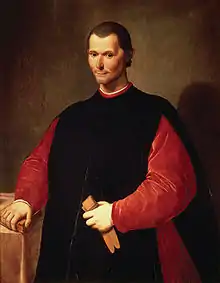
Italian Renaissance authors produced a number of important works. Niccolò Machiavelli's The Prince is one of the world's most famous essays on political science and modern philosophy, in which the "effectual truth" is taken to be more important than any abstract ideal. Another important work of the period, Ludovico Ariosto's Orlando Furioso, continuation of Matteo Maria Boiardo's unfinished romance Orlando Innamorato, is perhaps the greatest chivalry poem ever written. Baldassare Castiglione's dialogue The Book of the Courtier describes the ideal of the perfect court gentleman and of spiritual beauty. The lyric poet Torquato Tasso in Jerusalem Delivered wrote a Christian epic, making use of the ottava rima, with attention to the Aristotelian canons of unity.
Giovanni Francesco Straparola and Giambattista Basile, which have written The Facetious Nights of Straparola (1550–1555) and the Pentamerone (1634) respectively, printed some of the first known versions of fairy tales in Europe.[414][415][416] In the early 17th century, some literary masterpieces were created, such as Giambattista Marino's long mythological poem, L'Adone. The Baroque period also produced the clear scientific prose of Galileo as well as Tommaso Campanella's The City of the Sun, a description of a perfect society ruled by a philosopher-priest. At the end of the 17th century, the Arcadians began a movement to restore simplicity and classical restraint to poetry, as in Metastasio's heroic melodramas. In the 18th century, playwright Carlo Goldoni created full written plays, many portraying the middle class of his day.
The Romanticism coincided with some ideas of the Risorgimento, the patriotic movement that brought Italy political unity and freedom from foreign domination. Italian writers embraced Romanticism in the early 19th century. The time of Italy's rebirth was heralded by the poets Vittorio Alfieri, Ugo Foscolo, and Giacomo Leopardi. The works by Alessandro Manzoni, the leading Italian Romantic, are a symbol of the Italian unification for their patriotic message and because of his efforts in the development of the modern, unified Italian language; his novel The Betrothed was the first Italian historical novel to glorify Christian values of justice and Providence, and it has been called the most famous and widely read novel in the Italian language.[419]
In the late 19th century, a realistic literary movement called Verismo played a major role in Italian literature; Giovanni Verga and Luigi Capuana were its main exponents. In the same period, Emilio Salgari, writer of action adventure swashbucklers and a pioneer of science fiction, published his Sandokan series.[420] In 1883, Carlo Collodi also published the novel The Adventures of Pinocchio, the most celebrated children's classic by an Italian author and the most translated non-religious book in the world.[417] A movement called Futurism influenced Italian literature in the early 20th century. Filippo Tommaso Marinetti wrote Manifesto of Futurism, called for the use of language and metaphors that glorified the speed, dynamism, and violence of the machine age.[421]
Modern literary figures and Nobel laureates are Gabriele D'Annunzio from 1889 to 1910, nationalist poet Giosuè Carducci in 1906, realist writer Grazia Deledda in 1926, modern theatre author Luigi Pirandello in 1936, short stories writer Italo Calvino in 1960, poets Salvatore Quasimodo in 1959 and Eugenio Montale in 1975, Umberto Eco in 1980, and satirist and theatre author Dario Fo in 1997.[422]
Philosophy
Over the ages, Italian philosophy and literature had a vast influence on Western philosophy, beginning with the Greeks and Romans, and going onto Renaissance humanism, the Age of Enlightenment and modern philosophy.[423] Philosophy was brought to Italy by Pythagoras, founder of the Italian school of philosophy in Crotone.[424] Major Italian philosophers of the Greek period include Xenophanes, Parmenides, Zeno, Empedocles and Gorgias. Roman philosophers include Cicero, Lucretius, Seneca the Younger, Musonius Rufus, Plutarch, Epictetus, Marcus Aurelius, Clement of Alexandria, Sextus Empiricus, Alexander of Aphrodisias, Plotinus, Porphyry, Iamblichus, Augustine of Hippo, Philoponus of Alexandria and Boethius.[423]
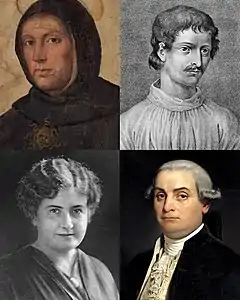
Italian Medieval philosophy was mainly Christian, and included several important philosophers and theologians such as St Thomas Aquinas, the foremost classical proponent of natural theology and the father of Thomism, who reintroduced Aristotelian philosophy to Christianity.[429] Notable Renaissance philosophers include: Giordano Bruno, one of the major scientific figures of the western world; Marsilio Ficino, one of the most influential humanist philosophers of the period; and Niccolò Machiavelli, one of the main founders of modern political science. Machiavelli's most famous work was The Prince, whose contribution to the history of political thought is the fundamental break between political realism and political idealism.[430] Italy was also affected by the Enlightenment, a movement which was a consequence of the Renaissance.[431] Cities with important universities such as Padua, Bologna and Naples remained great centres of scholarship and the intellect, with several philosophers such as Giambattista Vico (who is widely regarded as being the founder of modern Italian philosophy)[432] and Antonio Genovesi.[431] Cesare Beccaria was also one of the greatest Italian Enlightenment writers and is now considered one of the fathers of classical criminal theory as well as modern penology.[427] Beccaria is famous for his On Crimes and Punishments (1764), a treatise that served as one of the earliest prominent condemnations of torture and the death penalty and thus a landmark work in anti-death penalty philosophy.[431]
Italy also had a renowned philosophical movement in the 1800s, with Idealism, Sensism and Empiricism. The main Sensist Italian philosophers were Melchiorre Gioja and Gian Domenico Romagnosi.[432] Criticism of the Sensist movement came from other philosophers such as Pasquale Galluppi (1770–1846), who affirmed that a priori relationships were synthetic.[432] Antonio Rosmini, instead, was the founder of Italian Idealism. During the late 19th and 20th centuries, there were also several other movements which gained some form of popularity in Italy, such as Ontologism (whose main philosopher was Vincenzo Gioberti),[433] anarchism, communism, socialism, futurism, fascism and Christian democracy. Giovanni Gentile and Benedetto Croce were two of the most significant 20th-century Idealist philosophers. Anarcho-communism first fully formed into its modern strain within the Italian section of the First International.[434] Antonio Gramsci remains an important philosopher within Marxist and communist theory, credited with creating the theory of cultural hegemony. Italian philosophers were also influential in the development of the non-Marxist liberal socialism philosophy, including Carlo Rosselli, Norberto Bobbio, Piero Gobetti and Aldo Capitini. In the 1960s, many Italian left-wing activists adopted the anti-authoritarian pro-working class leftist theories that would become known as autonomism and operaismo.[435]
Early and important Italian feminists include Sibilla Aleramo, Alaide Gualberta Beccari, and Anna Maria Mozzoni, though proto-feminist philosophies had previously been touched upon by earlier Italian writers such as Christine de Pizan, Moderata Fonte, and Lucrezia Marinella. Italian physician and educator Maria Montessori is credited with the creation of the philosophy of education that bears her name, an educational philosophy now practiced throughout the world.[428] Giuseppe Peano was one of the founders of analytic philosophy and contemporary philosophy of mathematics. Recent analytic philosophers include Carlo Penco, Gloria Origgi, Pieranna Garavaso and Luciano Floridi.[423]
Theatre
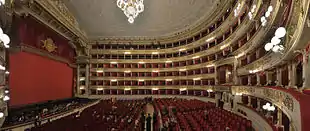
Italian theatre can be traced back to the Roman tradition. The theatre of ancient Rome was a thriving and diverse art form, ranging from festival performances of street theatre, nude dancing, and acrobatics, to the staging of Plautus's broadly appealing situation comedies, to the high-style, verbally elaborate tragedies of Seneca. Although Rome had a native tradition of performance, the Hellenization of Roman culture in the 3rd century BCE had a profound and energising effect on Roman theatre and encouraged the development of Latin literature of the highest quality for the stage. As with many other literary genres, Roman dramatists was heavily influenced or tended to adapt from the Greek. For example, Seneca's Phaedra was based on that of Euripides, and many of the comedies of Plautus were direct translations of works by Menander.[436]

During the 16th century and on into the 18th century, Commedia dell'arte was a form of improvisational theatre, and it is still performed today. Travelling troupes of players would set up an outdoor stage and provide amusement in the form of juggling, acrobatics and, more typically, humorous plays based on a repertoire of established characters with a rough storyline, called canovaccio. Plays did not originate from written drama but from scenarios called lazzi, which were loose frameworks that provided the situations, complications, and outcome of the action, around which the actors would improvise. The characters of the commedia usually represent fixed social types and stock characters, each of which has a distinct costume, such as foolish old men, devious servants, or military officers full of false bravado. The main categories of these characters include servants, old men, lovers, and captains.[437]
The first recorded Commedia dell'arte performances came from Rome as early as 1551,[438] and was performed outdoors in temporary venues by professional actors who were costumed and masked, as opposed to commedia erudita, which were written comedies, presented indoors by untrained and unmasked actors.[439] By the mid-16th century, specific troupes of commedia performers began to coalesce, and by 1568 the Gelosi became a distinct company. Commedia often performed inside in court theatres or halls, and also as some fixed theatres such as Teatro Baldrucca in Florence. Flaminio Scala, who had been a minor performer in the Gelosi published the scenarios of the commedia dell'arte around the start of the 17th century, really in an effort to legitimize the form—and ensure its legacy. These scenari are highly structured and built around the symmetry of the various types in duet: two zanni, vecchi, inamorate and inamorati, among others.[440]
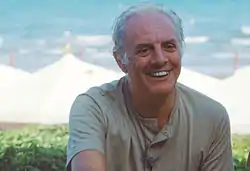
In commedia dell'arte, female roles were played by women, documented as early as the 1560s, making them the first known professional actresses in Europe since antiquity. Lucrezia Di Siena, whose name is on a contract of actors from 10 October 1564, has been referred to as the first Italian actress known by name, with Vincenza Armani and Barbara Flaminia as the first primadonnas and the first well documented actresses in Europe.[443]
The Ballet dance genre also originated in Italy. It began during the Italian Renaissance court as an outgrowth of court pageantry,[444] where aristocratic weddings were lavish celebrations. Court musicians and dancers collaborated to provide elaborate entertainment for them.[445] Domenico da Piacenza was one of the first dancing masters. Along with his students, Antonio Cornazzano and Guglielmo Ebreo, he was trained in dance and responsible for teaching nobles the art. Da Piacenza left one work: De arte saltandi et choreus ducendi (On the art of dancing and conducting dances), which was put together by his students.
At first, ballets were woven in to the midst of an opera to allow the audience a moment of relief from the dramatic intensity. By the mid-seventeenth century, Italian ballets in their entirety were performed in between the acts of an opera. Over time, Italian ballets became a more beloved and important part of theatrical life: ballet companies in Italy's major opera houses employed an average of four to twelve dancers; in 1815 many companies employed anywhere from eighty to one hundred dancers.[446]
Carlo Goldoni, who wrote a few scenarios starting in 1734, superseded the comedy of masks and the comedy of intrigue by representations of actual life and manners through the characters and their behaviours. He rightly maintained that Italian life and manners were susceptible of artistic treatment such as had not been given them before. Italian theatre has been active in producing contemporary European work and in staging important revivals, including the works of Luigi Pirandello and Dario Fo.
The Teatro di San Carlo in Naples is the oldest continuously active venue for public opera in the world, opening in 1737, decades before both the Milan's La Scala and Venice's La Fenice theatres.[447]
Music
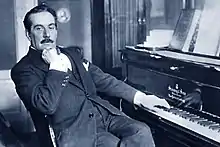
From folk music to classical, music has always played an important role in Italian culture. Instruments associated with classical music, including the piano and violin, were invented in Italy,[450][451] and many of the prevailing classical music forms, such as the symphony, concerto, and sonata, can trace their roots back to innovations of 16th- and 17th-century Italian music.
Italy's most famous composers include the Renaissance composers Palestrina, Monteverdi and Gesualdo, the Baroque composers Scarlatti, Corelli and Vivaldi, the Classical composers Paisiello, Paganini and Rossini, and the Romantic composers Verdi and Puccini. Modern Italian composers such as Berio and Nono proved significant in the development of experimental and electronic music. While the classical music tradition still holds strong in Italy, as evidenced by the fame of its innumerable opera houses, such as La Scala of Milan and San Carlo of Naples (the oldest continuously active venue for public opera in the world),[447] and performers such as the pianist Maurizio Pollini and tenor Luciano Pavarotti, Italians have been no less appreciative of their thriving contemporary music scene.

Italy is widely known for being the birthplace of opera.[453] Italian opera was believed to have been founded in the early 17th century, in cities such as Mantua and Venice.[453] Later, works and pieces composed by native Italian composers of the 19th and early 20th centuries, such as Rossini, Bellini, Donizetti, Verdi and Puccini, are among the most famous operas ever written and today are performed in opera houses across the world. La Scala operahouse in Milan is also renowned as one of the best in the world. Famous Italian opera singers include Enrico Caruso and Alessandro Bonci.
Introduced in the early 1920s, jazz took a particularly strong foothold in Italy, and remained popular despite the xenophobic cultural policies of the Fascist regime. Today, the most notable centres of jazz music in Italy include Milan, Rome, and Sicily. Later, Italy was at the forefront of the progressive rock and pop movement of the 1970s, with bands like PFM, Banco del Mutuo Soccorso, Le Orme, Goblin, and Pooh.[454] The same period saw diversification in the cinema of Italy, and Cinecittà films included complex scores by composers including Ennio Morricone, Armando Trovaioli, Piero Piccioni and Piero Umiliani. In the early 1980s, the first star to emerge from the Italian hip hop scene was singer Jovanotti.[455] Popular Italian metal bands such as Rhapsody of Fire, Lacuna Coil, Elvenking, Forgotten Tomb, and Fleshgod Apocalypse are also seen as pioneers of various heavy metal subgenres.[456]
.jpg.webp)
Italy was also an important country in the development of disco and electronic music, with Italo disco, known for its futuristic sound and prominent use of synthesisers and drum machines, being one of the earliest electronic dance genres, as well as European forms of disco aside from Euro disco (which later went on to influence several genres such as Eurodance and Nu-disco).[458] By circa 1988, the genre had merged into other forms of European dance and electronic music, such as Italo house, which blended elements of Italo disco with traditional house music; its sound was generally uplifting, and made strong usage of piano melodies. Some bands of this genre are Black Box, East Side Beat, and 49ers. By the latter half of the 1990s, a subgenre of Eurodance known as Italo dance emerged. Taking influences from Italo disco and Italo house, Italo dance generally included synthesizer riffs, a melodic sound, and the usage of vocoders. Notable Italian DJs and remixers include Gabry Ponte (member of the group Eiffel 65), Benny Benassi, Gigi D'Agostino, and the trio Tacabro.
Producers such as Giorgio Moroder, who won three Academy Awards and four Golden Globes for his music, were highly influential in the development of electronic dance music.[457] Today, Italian pop music is represented annually with the Sanremo Music Festival, which served as inspiration for the Eurovision song contest, and the Festival of Two Worlds in Spoleto.[459] Singers such as Mina, Andrea Bocelli, Grammy winner Laura Pausini, Zucchero, Eros Ramazzotti and Tiziano Ferro have attained international acclaim.
Cinema
The history of Italian cinema began a few months after the Lumière brothers began motion picture exhibitions. The first Italian film was a few seconds, showing Pope Leo XIII giving a blessing to the camera. The Italian film industry was born between 1903 and 1908 with three companies: the Società Italiana Cines, the Ambrosio Film and the Itala Film. Other companies soon followed in Milan and in Naples. In a short time these first companies reached a fair producing quality, and films were soon sold outside Italy. Cinema was later used by Benito Mussolini, who founded Rome's renowned Cinecittà studio for the production of Fascist propaganda until World War II.[460]
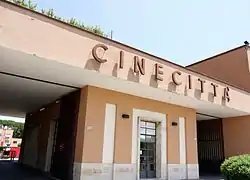
After the war, Italian film was widely recognised and exported until an artistic decline around the 1980s. Notable Italian film directors from this period include Vittorio De Sica, Federico Fellini, Sergio Leone, Pier Paolo Pasolini, Luchino Visconti, Michelangelo Antonioni and Roberto Rossellini; some of these are recognised among the greatest and most influential filmmakers of all time.[461][462] Movies include world cinema treasures such as Bicycle Thieves, La dolce vita, 8½, The Good, the Bad and the Ugly and Once Upon a Time in the West. The mid-1940s to the early 1950s was the heyday of neorealist films, reflecting the poor condition of post-war Italy.[463][464]
As the country grew wealthier in the 1950s, a form of neorealism known as pink neorealism succeeded, and other film genres, such as sword-and-sandal followed as Spaghetti Westerns, were popular in the 1960s and 1970s. Actresses such as Sophia Loren, Giulietta Masina and Gina Lollobrigida achieved international stardom during this period. Erotic Italian thrillers, or giallos, produced by directors such as Mario Bava and Dario Argento in the 1970s, also influenced the horror genre worldwide. In recent years, the Italian scene has received only occasional international attention, with movies like Life Is Beautiful directed by Roberto Benigni, Il Postino: The Postman with Massimo Troisi and The Great Beauty directed by Paolo Sorrentino.
The aforementioned Cinecittà studio is today the largest film and television production facility in continental Europe and the centre of the Italian cinema, where many of the biggest box office hits are filmed, and one of the biggest production communities in the world. In the 1950s, the number of international productions being made there led to Rome's being dubbed "Hollywood on the Tiber". More than 3,000 productions have been made on its lot, of which 90 received an Academy Award nomination and 47 of these won it, from some cinema classics to recent rewarded features (such as Roman Holiday, Ben-Hur, Cleopatra, Romeo and Juliet, The English Patient, The Passion of the Christ, and Gangs of New York).[465]
Italy is the most awarded country at the Academy Awards for Best Foreign Language Film, with 14 awards won, 3 Special Awards and 31 nominations. As of 2016, Italian films have also won 12 Palmes d'Or (the second-most of any country), 11 Golden Lions and 7 Golden Bears.
Sport
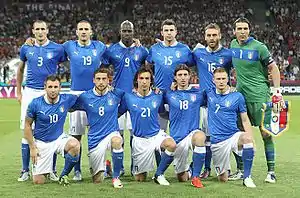
The most popular sport in Italy is football.[466][467] Italy's national football team is one of the world's most successful teams with four FIFA World Cup victories (1934, 1938, 1982 and 2006).[468] Italian clubs have won 48 major European trophies, making Italy the second most successful country in European football. Italy's top-flight club football league is named Serie A and is followed by millions of fans around the world.
Other popular team sports in Italy include basketball, volleyball and rugby. Italy's male and female national volleyball teams are often featured among the world's best. The Italian national basketball team's best results were gold at Eurobasket 1983 and EuroBasket 1999, as well as silver at the Olympics in 2004. Lega Basket Serie A is widely considered one of the most competitive in Europe. Rugby union enjoys a good level of popularity, especially in the north of the country. Italy's national team competes in the Six Nations Championship, and is a regular at the Rugby World Cup. Italy ranks as a tier-one nation by World Rugby. The men's volleyball team won three consecutive World Championships (in 1990, 1994, and 1998) and earned the Olympic silver medal in 1996, 2004, and 2016.
.jpg.webp)
Italy has a long and successful tradition in individual sports as well. Bicycle racing is a very familiar sport in the country.[470] Italians have won the UCI World Championships more than any other country, except Belgium. The Giro d'Italia is a cycling race held every May, and constitutes one of the three Grand Tours, along with the Tour de France and the Vuelta a España, each of which last approximately three weeks. Alpine skiing is also a very widespread sport in Italy, and the country is a popular international skiing destination, known for its ski resorts.[471] Italian skiers achieved good results in Winter Olympic Games, Alpine Ski World Cup, and World Championship.
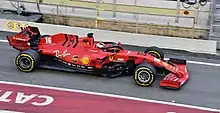
Tennis has a significant following in Italy, ranking as the fourth most practised sport in the country.[473] The Rome Masters, founded in 1930, is one of the most prestigious tennis tournaments in the world. Italian professional tennis players won the Davis Cup in 1976 and the Fed Cup in 2006, 2009, 2010 and 2013. Motorsports are also extremely popular in Italy. Italy has won, by far, the most MotoGP World Championships. Italian Scuderia Ferrari is the oldest surviving team in Grand Prix racing, having competed since 1948, and statistically the most successful Formula One team in history with a record of 232 wins.
The Italian Grand Prix of Formula 1 is the fifth oldest surviving Grand Prix, having been held since 1921. It's also one of the two Grand Prix present in every championship since the first one in 1950. Every Formula 1 Grand Prix (except for the 1980) has been held at Autodromo Nazionale Monza. Formula 1 was also held at Imola (1980-2006, 2020) and Mugello (2020)
Historically, Italy has been successful in the Olympic Games, taking part from the first Olympiad and in 47 Games out of 48. Italian sportsmen have won 522 medals at the Summer Olympic Games, and another 106 at the Winter Olympic Games, for a combined total of 628 medals with 235 golds, which makes them the fifth most successful nation in Olympic history for total medals. The country hosted two Winter Olympics and will host a third (in 1956, 2006, and 2026), and one Summer games (in 1960).
Fashion and design
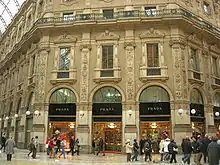
Italian fashion has a long tradition, and is regarded as one most important in the world. Milan, Florence and Rome are Italy's main fashion capitals. According to Top Global Fashion Capital Rankings 2013 by Global Language Monitor, Rome ranked sixth worldwide when Milan was twelfth.[474] Major Italian fashion labels, such as Gucci, Armani, Prada, Versace, Valentino, Dolce & Gabbana, Missoni, Fendi, Moschino, Max Mara, Trussardi, and Ferragamo, to name a few, are regarded as among the finest fashion houses in the world. Jewellers like Bvlgari, Damiani and Buccellati have been founded in Italy. Also, the fashion magazine Vogue Italia, is considered one of the most prestigious fashion magazines in the world.[475] The talent of young, creative fashion is also promoted, as in the ITS young fashion designer competition in Trieste.[476]
Italy is also prominent in the field of design, notably interior design, architectural design, industrial design and urban design. The country has produced some well-known furniture designers, such as Gio Ponti and Ettore Sottsass, and Italian phrases such as "Bel Disegno" and "Linea Italiana" have entered the vocabulary of furniture design.[477] Examples of classic pieces of Italian white goods and pieces of furniture include Zanussi's washing machines and fridges,[478] the "New Tone" sofas by Atrium,[478] and the post-modern bookcase by Ettore Sottsass, inspired by Bob Dylan's song "Stuck Inside of Mobile with the Memphis Blues Again".[478] Today, Milan and Turin are the nation's leaders in architectural design and industrial design. The city of Milan hosts Fiera Milano, Europe's largest design fair.[479] Milan also hosts major design and architecture-related events and venues, such as the "Fuori Salone" and the Salone del Mobile, and has been home to the designers Bruno Munari, Lucio Fontana, Enrico Castellani and Piero Manzoni.[480]
Cuisine
The Italian cuisine has developed through centuries of social and political changes, with roots as far back as the 4th century BC. Italian cuisine in itself takes heavy influences, including Etruscan, ancient Greek, ancient Roman, Byzantine, and Jewish.[481] Significant changes occurred with the discovery of the New World with the introduction of items such as potatoes, tomatoes, bell peppers and maize, now central to the cuisine but not introduced in quantity until the 18th century.[482][483] Italian cuisine is noted for its regional diversity,[484][485][486] abundance of difference in taste, and is known to be one of the most popular in the world,[487] wielding strong influence abroad.[488]
The Mediterranean diet forms the basis of Italian cuisine, rich in pasta, fish, fruits and vegetables and characterised by its extreme simplicity and variety, with many dishes having only four to eight ingredients.[489] Italian cooks rely chiefly on the quality of the ingredients rather than on elaborate preparation.[490] Dishes and recipes are often derivatives from local and familial tradition rather than created by chefs, so many recipes are ideally suited for home cooking, this being one of the main reasons behind the ever-increasing worldwide popularity of Italian cuisine, from America[491] to Asia.[492] Ingredients and dishes vary widely by region.
A key factor in the success of Italian cuisine is its heavy reliance on traditional products; Italy has the most traditional specialities protected under EU law.[493] Cheese, cold cuts and wine are a major part of Italian cuisine, with many regional declinations and Protected Designation of Origin or Protected Geographical Indication labels, and along with coffee (especially espresso) make up a very important part of the Italian gastronomic culture.[494] Desserts have a long tradition of merging local flavours such as citrus fruits, pistachio and almonds with sweet cheeses like mascarpone and ricotta or exotic tastes as cocoa, vanilla and cinnamon. Gelato,[495] tiramisù[496] and cassata are among the most famous examples of Italian desserts, cakes and patisserie.
Public holidays and festivals
Public holidays celebrated in Italy include religious, national and regional observances.[499] Italy's National Day, the Festa della Repubblica (Republic Day) is celebrated on 2 June each year, and commemorates the birth of the Italian Republic in 1946.
The Saint Lucy's Day, which take place on 13 December, is very popular among children in some Italian regions, where she plays a role similar to Santa Claus.[500] In addition, the Epiphany in Italy is associated with the folkloristic figure of the Befana, a broomstick-riding old woman who, in the night between 5 and 6 January, bringing good children gifts and sweets, and bad ones charcoal or bags of ashes.[501] The Assumption of Mary coincides with Ferragosto on 15 August, the summer vacation period which may be a long weekend or most of the month.[502] Each city or town also celebrates a public holiday on the occasion of the festival of the local patron saint, for example: Rome on 29 June (Saints Peter and Paul) and Milan on 7 December (Saint Ambrose).[503]
There are many festivals and festivities in Italy. Some of them include the Palio di Siena horse race, Holy Week rites, Saracen Joust of Arezzo, Saint Ubaldo Day in Gubbio, Giostra della Quintana in Foligno, and the Calcio Fiorentino. In 2013, UNESCO has included among the intangible cultural heritage some Italian festivals and pasos (in Italian "macchine a spalla"), such as the Varia di Palmi, the Macchina di Santa Rosa in Viterbo, the Festa dei Gigli in Nola, and faradda di li candareri in Sassari.[504]
Other festivals include the carnivals in Venice, Viareggio, Satriano di Lucania, Mamoiada, and Ivrea, mostly known for its Battle of the Oranges. The prestigious Venice International Film Festival, awarding the "Golden Lion" and held annually since 1932, is the oldest film festival in the world.[497]
Notes
- Official French maps show the border detouring south of the main summit, and claim the highest point in Italy is Mont Blanc de Courmayeur (4,748 m or 15,577 ft), but these are inconsistent with an 1861 convention and topographic watershed analysis.
- According to Mitrica, an October 2005 Romanian report estimates that 1,061,400 Romanians are living in Italy, constituting 37% of 2.8 million immigrants in that country[335] but it is unclear how the estimate was made, and therefore whether it should be taken seriously.
References
- "Foreign citizens 2017". ISTAT. Archived from the original on 6 August 2017. Retrieved 15 June 2018.
- "The Global Religious Landscape" (PDF). Pewforum.org. Archived from the original (PDF) on 25 January 2017. Retrieved 2 October 2015.
- "Surface water and surface water change". Organisation for Economic Co-operation and Development (OECD). Retrieved 11 October 2020.
- "Indicatori demografici". www.istat.it (in Italian). 20 February 2020. Retrieved 11 April 2020.
- "La popolazione legale del 15° Censimento della popolazione". www.istat.it (in Italian). 19 December 2012. Retrieved 18 September 2019.
- "World Economic Outlook Database, October 2019". IMF.org. International Monetary Fund. Retrieved 30 October 2020.
- "Gini coefficient of equivalised disposable income – EU-SILC survey". ec.europa.eu. Eurostat. Retrieved 12 September 2019.
- "Human Development Report 2020" (PDF). United Nations Development Programme. 15 December 2020. Retrieved 15 December 2020.
- Year-month-day also sometimes used, though rarely, mainly used for computing contexts. See Date and time notation in Italy.
- "Legge Regionale 15 ottobre 1997, n. 26". Regione autonoma della Sardegna – Regione Autònoma de Sardigna.
- https://www.regione.fvg.it/rafvg/cms/RAFVG/cultura-sport/patrimonio-culturale/comunita-linguistiche/
- "Comune di Campione d'Italia". Comune.campione-d-italia.co.it. 14 July 2010. Archived from the original on 30 April 2011. Retrieved 30 October 2010.
- Search the agreements database Archived 29 March 2014 at the Wayback Machine Council of the European Union (retrieved 13 October 2013).
- Italy: The World Factbook Central Intelligence Agency (retrieved 13 October 2013).
- "Country names". Archived from the original on 19 May 2011.
- "BBC News – Italy profile – Facts". BBC News. 17 December 2015. Archived from the original on 25 September 2013.
- "UNSD — Methodology". unstats.un.org.
- "Italy – Facts, Geography, & History". Encyclopedia Britannica. Retrieved 9 February 2020.
- "UNITED NATIONS DGACM". www.un.org.
- Italy is often grouped in Western Europe. Academic works describing Italy as a Western European country:
- Hancock, M. Donald; Conradt, David P.; Peters, B. Guy; Safran, William; Zariski, Raphael (11 November 1998). Politics in Western Europe : an introduction to the politics of the United Kingdom, France, Germany, Italy, Sweden, and the European Union (2nd ed.). Chatham House Publishers. ISBN 978-1-56643-039-5.
list of Western European countries Italy.
- Ugo, Ascoli; Emmanuele, Pavolini (2016). The Italian welfare state in a European perspective: A comparative analysis. Policy Press. ISBN 978-1-4473-3444-6.
- Zloch-Christy, Iliana (1991). East-West Financial Relations: Current Problems and Future Prospects. Cambridge University Press. ISBN 978-0-521-39530-4. Retrieved 29 September 2019.
list of Western European countries Italy.
- Clout, Hugh D. (1989). Western Europe: Geographical Perspectives. Longman Scientific & Technical. ISBN 978-0-582-01772-6. Retrieved 29 September 2019.
- Furlong, Paul (2003). Modern Italy: Representation and Reform. Routledge. ISBN 978-1-134-97983-7. Retrieved 29 September 2019.
- Hanf, Kenneth; Jansen, Alf-Inge (2014). Governance and Environment in Western Europe: Politics, Policy and Administration. Routledge. ISBN 978-1-317-87917-6. Retrieved 29 September 2019.
- Hancock, M. Donald; Conradt, David P.; Peters, B. Guy; Safran, William; Zariski, Raphael (11 November 1998). Politics in Western Europe : an introduction to the politics of the United Kingdom, France, Germany, Italy, Sweden, and the European Union (2nd ed.). Chatham House Publishers. ISBN 978-1-56643-039-5.
- Carl Waldman; Catherine Mason (2006). Encyclopedia of European Peoples. Infobase Publishing. p. 586. ISBN 978-1-4381-2918-1. Retrieved 23 February 2013.
- Lazenby, John Francis (4 February 1998). Hannibal's War: A Military History of the Second Punic War. University of Oklahoma Press. p. 29. ISBN 978-0-8061-3004-0 – via Internet Archive.
Italy homeland of the Romans.
- Maddison, Angus (20 September 2007). Contours of the World Economy 1-2030 AD: Essays in Macro-Economic History. OUP Oxford. ISBN 978-0-19-922721-1 – via Google Books.
- Sée, Henri. "Modern Capitalism Its Origin and Evolution" (PDF). University of Rennes. Batoche Books. Archived from the original (PDF) on 7 October 2013. Retrieved 29 August 2013.
- Jepson, Tim (2012). National Geographic Traveler: Italy. National Geographic Books. ISBN 978-1-4262-0861-4.
- Bouchard, Norma; Ferme, Valerio (2013). Italy and the Mediterranean: Words, Sounds, and Images of the Post-Cold War Era. Palgrave Macmillan. ISBN 978-1-137-34346-8. Retrieved 17 December 2015.
- "Unification of Italy". Library.thinkquest.org. 4 April 2003. Archived from the original on 7 March 2009. Retrieved 19 November 2009.
- "The Italian Colonial Empire". All Empires. Archived from the original on 24 February 2012. Retrieved 17 June 2012.
At its peak, just before WWII, the Italian Empire comprehended the territories of present time Italy, Albania, Rhodes, Dodecanese, Libya, Ethiopia, Eritrea, the majority of Somalia and the little concession of Tientsin in China
- Jon Rynn. "WHAT IS A GREAT POWER?" (PDF). economicreconstruction.com. Archived (PDF) from the original on 28 April 2017. Retrieved 15 March 2017.
- "IMF Advanced Economies List. World Economic Outlook, April 2016, p. 148" (PDF). Archived (PDF) from the original on 21 April 2016.
- CIA (2008). "Appendix B. International Organizations and Groups". World Factbook. Archived from the original on 9 April 2008. Retrieved 10 April 2008.
- Country and Lending Groups. Archived 2 July 2014 at the Wayback Machine World Bank. Retrieved 1 August 2016.
- The Economist Intelligence Unit's quality-of-life index Archived 2 August 2012 at the Wayback Machine, Economist, 2005
- "The World Health Organization's ranking of the world's health systems". Photius.com. Retrieved 7 September 2015.
- Gabriele Abbondanza, Italy as a Regional Power: the African Context from National Unification to the Present Day (Rome: Aracne, 2016)
- "Operation Alba may be considered one of the most important instances in which Italy has acted as a regional power, taking the lead in executing a technically and politically coherent and determined strategy." See Federiga Bindi, Italy and the European Union (Washington, D.C.: Brookings Institution Press, 2011), p. 171.
- Canada Among Nations, 2004: Setting Priorities Straight. McGill-Queen's Press – MQUP. 17 January 2005. p. 85. ISBN 978-0-7735-2836-9. Retrieved 13 June 2016. ("The United States is the sole world's superpower. France, Italy, Germany and the United Kingdom are great powers")
- Sterio, Milena (2013). The right to self-determination under international law : "selfistans", secession and the rule of the great powers. Milton Park, Abingdon, Oxon: Routledge. p. xii (preface). ISBN 978-0-415-66818-7. Retrieved 13 June 2016. ("The great powers are super-sovereign states: an exclusive club of the most powerful states economically, militarily, politically and strategically. These states include veto-wielding members of the United Nations Security Council (United States, United Kingdom, France, China, and Russia), as well as economic powerhouses such as Germany, Italy and Japan.")
- Michael Barone (2 September 2010). "The essence of Italian culture and the challenge of the global age". Council for Research in Values and philosophy. Archived from the original on 22 September 2012. Retrieved 22 September 2012.
- Alberto Manco, Italia. Disegno storico-linguistico, 2009, Napoli, L'Orientale, ISBN 978-88-95044-62-0
- J.P. Mallory and D.Q. Adams, Encyclopedia of Indo-European Culture (London: Fitzroy and Dearborn, 1997), 24.
- Dionysius of Halicarnassus, Roman Antiquities, 1.35, on LacusCurtius
- Aristotle, Politics, 7.1329b Archived 10 September 2015 at the Wayback Machine, on Perseus
- Thucydides, The Peloponnesian War, 6.2.4 Archived 24 September 2015 at the Wayback Machine, on Perseus
- Pallottino, M., History of Earliest Italy, trans. Ryle, M & Soper, K. in Jerome Lectures, Seventeenth Series, p. 50
- Giovanni Brizzi, Roma. Potere e identità: dalle origini alla nascita dell'impero cristiano, Bologna, Patron, 2012 p. 94
- Carlà-Uhink, Filippo (25 September 2017). The "Birth" of Italy: The Institutionalization of Italy as a Region, 3rd-1st Century BCE. ISBN 978-3-11-054478-7.
- Levene, D. S. (17 June 2010). Livy on the Hannibalic War. ISBN 978-0-19-815295-8.
- Carlà-Uhink, Filippo (25 September 2017). The "Birth" of Italy: The Institutionalization of Italy as a Region, 3rd-1st Century BCE. ISBN 978-3-11-054478-7.
- In his book Beyond the Rubicon, J. H. C. Williams also explains that Cisalpine Gaul was geographically considered part of Italy since the 220s. He argues that Julius Caesar drafted the act that officially merged Cisalpine Gaul into the political unit of Italy, some years after he gave Roman citizenship to the inhabitants of Cisaline Gaul with the Lex Roscia of 49 BC, but his assassination prevented the publication of the act. Octavian will finally enforce it in his capacity a Triumvir in 42 BC.
- Long, George (1866). Decline of the Roman republic: Volume 2. London.
- Cassius, Dio. Historia Romana. 41. 36.
- Laffi, Umberto (1992). "La provincia della Gallia Cisalpina". Athenaeum (in Italian) (80): 5–23.
- Aurigemma, Salvatore. "Gallia Cisalpina". www.treccani.it (in Italian). Enciclopedia Italiana. Retrieved 14 October 2014.
- "Italy (ancient Roman territory)". britannica.com. Encyclopædia Britannica. Retrieved 10 November 2013.
- "Sassi di Matera". AmusingPlanet.
- Society, National Geographic. "Erano padani i primi abitanti d'Italia". National Geographic. Archived from the original on 26 June 2019. Retrieved 11 March 2019.
- Kluwer Academic/Plenum Publishers 2001, ch. 2. ISBN 0-306-46463-2.
- 42.7–41.5 ka (1σ CI). Douka, Katerina; et al. (2012). "A new chronostratigraphic framework for the Upper Palaeolithic of Riparo Mochi (Italy)". Journal of Human Evolution. 62 (2): 286–299. doi:10.1016/j.jhevol.2011.11.009. PMID 22189428.
- "Istituto Italiano di Preistoria e Protostoria". IIPP. 29 January 2010. Archived from the original on 15 October 2013.
- "Rock Drawings in Valcamonica". UNESCO World Heritage Centre. Retrieved 29 June 2010.
- Bonani, Georges; Ivy, Susan D.; et al. (1994). "AMS 14
C
Age Determination of Tissue, Bone and Grass Samples from the Ötzal Ice Man" (PDF). Radiocarbon. 36 (2): 247–250. doi:10.1017/s0033822200040534. Retrieved 4 February 2016. - Zucca, Raimondo (2011). Tharros, Othoca e Neapolis. Porti e approdi antichi in Sardegna. Oristano. Archived from the original on 9 April 2016. Retrieved 9 April 2016.
- The Mycenaeans Archived 27 September 2013 at the Wayback Machine and Italy: the archaeological and archaeometric ceramic evidence, University of Glasgow, Department of Archaeology
- Emilio Peruzzi, Mycenaeans in early Latium, (Incunabula Graeca 75), Edizioni dell'Ateneo & Bizzarri, Roma, 1980
- Gert Jan van Wijngaarden, Use and Appreciation of Mycenaean Pottery in the Levant, Cyprus and Italy (1600–1200 B.C.): The Significance of Context, Amsterdam Archaeological Studies, Amsterdam University Press, 2001
- Bryan Feuer, Mycenaean civilization: an annotated bibliography through 2002, McFarland & Company; Rev Sub edition (2 March 2004)
- "Uomini e vicende di Magna Grecia" (in Italian). Archived from the original on 24 March 2017. Retrieved 3 August 2018.
- Raclot, Thierry; Oudart, Hugues (January 2000). "CORPS GRAS ET OBESITE Acides gras alimentaires et obésité : aspects qualitatifs et quantitatifs". Oléagineux, Corps gras, Lipides. 7 (1): 77–85. doi:10.1051/ocl.2000.0077. ISSN 1258-8210. no-break space character in
|title=at position 58 (help) - "II 1987: Uomini e vicende di Magna Grecia". www.bpp.it. Retrieved 31 January 2021.
- Mommsen, Theodor (1855). History of Rome, Book II: From the Abolition of the Monarchy in Rome to the Union of Italy. Leipzig: Reimer & Hirsel.
- Fear, Andrew (25 March 2010). Historiae Mundi: Studies in Universal History. ISBN 978-1-4725-1980-1.
- Taagepera, Rein (1979). "Size and Duration of Empires: Growth-Decline Curves, 600 B.C. to 600 A.D". Social Science History. 3 (3/4): 115–138. doi:10.2307/1170959. JSTOR 1170959.
- Turchin, Peter; Adams, Jonathan M.; Hall, Thomas D (2006). "East–West Orientation of Historical Empires" (PDF). Journal of World-Systems Research. 12 (2): 222. doi:10.5195/JWSR.2006.369. ISSN 1076-156X. Archived (PDF) from the original on 17 May 2016. Retrieved 6 February 2016.
- Richard, Carl J. (2010). Why we're all Romans : the Roman contribution to the western world (1st pbk. ed.). Lanham, MD: Rowman & Littlefield. pp. xi–xv. ISBN 978-0-7425-6779-5.
- Sarris, Peter (2011). Empires of faith : the fall of Rome to the rise of Islam, 500–700 (1st. pub. ed.). Oxford: Oxford UP. p. 118. ISBN 978-0-19-926126-0.
- Nolan, Cathal J. (2006). The age of wars of religion, 1000–1650 : an encyclopedia of global warfare and civilization (1. publ. ed.). Westport (Connecticut): Greenwood Press. p. 360. ISBN 978-0-313-33045-2.
- "Marco Polo – Exploration". History.com. Retrieved 9 January 2017.
- Jones, Philip (1997). The Italian city-state : from Commune to Signoria. Oxford: Clarendon Press. pp. 55–77. ISBN 978-0-19-822585-0.
- Niall, Ferguson (2008). The Ascent of Money: The Financial History of the World. Penguin.
- Lane, Frederic C. (1991). Venice, a maritime republic (4. print. ed.). Baltimore: Johns Hopkins University Press. p. 73. ISBN 978-0-8018-1460-0.
- G. Benvenuti – Le Repubbliche Marinare. Amalfi, Pisa, Genova, Venezia – Newton & Compton editori, Roma 1989; Armando Lodolini, Le repubbliche del mare, Biblioteca di storia patria, 1967, Roma. Peris, Persi (1982). Conoscere l'Italia. Istituto Geografico De Agostini. p. 74.
- "Repubbliche Marinare". Treccani.it (in Italian). Istituto dell'Enciclopedia Italiana.
- "Repubbliche marinare". thes.bncf.firenze.sbn.it (in Italian). National Central Library (Florence).
- Zorzi, Alvise (1983). Venice: The Golden Age, 697 – 1797. New York: Abbeville Press. p. 255. ISBN 0-89659-406-8. Retrieved 16 September 2017.
- Ali, Ahmed Essa with Othman (2010). Studies in Islamic civilization: the Muslim contribution to the Renaissance. Herndon, VA: International Institute of Islamic Thought. pp. 38–40. ISBN 978-1-56564-350-5.
- Stéphane Barry and Norbert Gualde, "The Biggest Epidemics of History" (La plus grande épidémie de l'histoire), in L'Histoire n° 310, June 2006, pp. 45–46
- "Plague". Brown University. Archived 31 August 2009 at the Wayback Machine
- Strathern, Paul The Medici: Godfathers of the Renaissance (2003)
- Peter Barenboim, Sergey Shiyan, Michelangelo: Mysteries of Medici Chapel, SLOVO, Moscow, 2006 Archived 11 May 2011 at the Wayback Machine. ISBN 5-85050-825-2
- Encyclopædia Britannica, Renaissance, 2008, O.Ed.
- Har, Michael H. History of Libraries in the Western World, Scarecrow Press Incorporate, 1999, ISBN 0-8108-3724-2
- Norwich, John Julius, A Short History of Byzantium, 1997, Knopf, ISBN 0-679-45088-2
- Leonardo Bruni; James Hankins (9 October 2010). History of the Florentine People. 1. Boston: Harvard University Press. Archived from the original on 3 January 2013.
- Encyclopædia Britannica, 1993 ed., Vol. 16, pp. 605ff / Morison, Christopher Columbus, 1955 ed., pp. 14ff
- "Catholic Encyclopedia "John & Sebastian Cabot"". newadvent. 2007. Retrieved 17 May 2008.
- Martone 2016, p. 504.
- Sider 2007, p. 226.
- Greene, George Washington (1837). The Life and Voyages of Verrazzano. Cambridge University: Folsom, Wells, and Thurston. p. 13. Retrieved 18 August 2017 – via Google Books.
- Napoleon Bonaparte, "The Economy of the Empire in Italy: Instructions from Napoleon to Eugène, Viceroy of Italy," Exploring the European Past: Texts & Images, Second Edition, ed. Timothy E. Gregory (Mason: Thomson, 2007), 65–66.
- "Scholar and Patriot". Manchester University Press – via Google Books.
- "Giuseppe Garibaldi (Italian revolutionary)". Archived from the original on 26 February 2014. Retrieved 6 March 2014.
- Dennis Mack Smith, Modern Italy; A Political History, (University of Michigan Press, 1997) p. 15. A literary echo may be found in the character of Giorgio Viola in Joseph Conrad's Nostromo.
- Enrico Dal Lago, "Lincoln, Cavour, and National Unification: American Republicanism and Italian Liberal Nationalism in Comparative Perspective." The Journal of the Civil War Era 3#1 (2013): 85-113.
- William L. Langer, ed., An Encyclopedia of World Cup History. 4th ed. 1968. pp 704-7.
- Mack Smith, Denis (1997). Modern Italy; A Political History. Ann Arbor: The University of Michigan Press. ISBN 0-472-10895-6
- "Everything you need to know about March 17th, Italy's Unity Day". 17 March 2017. Retrieved 17 July 2017.
- (Bosworth (2005), p. 49.)
- Burgwyn, H. James: Italian foreign policy in the interwar period, 1918–1940. Greenwood Publishing Group, 1997. p. 4. ISBN 0-275-94877-3
- Schindler, John R.: Isonzo: The Forgotten Sacrifice of the Great War. Greenwood Publishing Group, 2001. p. 303. ISBN 0-275-97204-6
- Mack Smith, Denis: Mussolini. Knopf, 1982. p. 31. ISBN 0-394-50694-4
- Mortara, G (1925). La Salute pubblica in Italia durante e dopo la Guerra. New Haven: Yale University Press.
- James H. Burgwyn (2004). General Roatta's war against the partisans in Yugoslavia: 1942 Archived 21 September 2013 at the Wayback Machine, Journal of Modern Italian Studies, Volume 9, Number 3, pp. 314–329(16)
- Italy's bloody secret (archived by WebCite), written by Rory Carroll, Education, The Guardian, June 2001
- Effie Pedaliu (2004) JSTOR 4141408? Britain and the 'Hand-over' of Italian War Criminals to Yugoslavia, 1945–48. Journal of Contemporary History. Vol. 39, No. 4, Special Issue: Collective Memory, pp. 503–529
- Oliva, Gianni (2006) «Si ammazza troppo poco». I crimini di guerra italiani. 1940–43 Archived 20 July 2011 at the Wayback Machine, Mondadori, ISBN 88-04-55129-1
- Baldissara, Luca & Pezzino, Paolo (2004). Crimini e memorie di guerra: violenze contro le popolazioni e politiche del ricordo, L'Ancora del Mediterraneo. ISBN 978-88-8325-135-1
- Viganò, Marino (2001), "Un'analisi accurata della presunta fuga in Svizzera", Nuova Storia Contemporanea (in Italian), 3
- "1945: Italian partisans kill Mussolini". BBC News. 28 April 1945. Archived from the original on 26 November 2011. Retrieved 17 October 2011.
- "Italy – Britannica Online Encyclopedia". Britannica.com. Archived from the original on 6 March 2012. Retrieved 2 August 2010.
- Adrian Lyttelton (editor), "Liberal and fascist Italy, 1900–1945", Oxford University Press, 2002. p. 13
- Damage Foreshadows A-Bomb Test, 1946/06/06 (1946). Universal Newsreel. 1946. Retrieved 22 February 2012.
- "Italia 1946: le donne al voto, dossier a cura di Mariachiara Fugazza e Silvia Cassamagnaghi" (PDF). Archived from the original (PDF) on 20 May 2011. Retrieved 30 May 2011.
- Lawrence S. Kaplan; Morris Honick (2007). NATO 1948: The Birth of the Transatlantic Alliance. Rowman & Littlefield. pp. 52–55. ISBN 978-0-7425-3917-4.
- Robert Ventresca (2004). From Fascism to Democracy: Culture and Politics in the Italian Election of 1948. University of Toronto Press. pp. 236–37.
- "Commissione parlamentare d'inchiesta sul terrorismo in Italia e sulle cause della mancata individuazione dei responsabili delle stragi (Parliamentary investigative commission on terrorism in Italy and the failure to identify the perpetrators)" (PDF) (in Italian). 1995. Archived from the original (PDF) on 19 August 2006. Retrieved 2 May 2006.
- (in English, Italian, French, and German) "Secret Warfare: Operation Gladio and NATO's Stay-Behind Armies". Swiss Federal Institute of Technology / International Relation and Security Network. Archived from the original on 25 April 2006. Retrieved 2 May 2006.
- "Clarion: Philip Willan, Guardian, 24 June 2000, p. 19". Cambridgeclarion.org. 24 June 2000. Archived from the original on 29 March 2010. Retrieved 24 April 2010.
- "New Arrests for Via D'Amelio Bomb Attack". corriere.it. 8 March 2012.
- Dickie (2007), p. 416
- "Sentenza del processo di 1º grado a Francesco Tagliavia per le stragi del 1993" (PDF).
- "Audizione del procuratore Sergio Lari dinanzi alla Commissione Parlamentare Antimafia – XVI LEGISLATURA (PDF)" (PDF).
- The so-called "Second Republic" was born by forceps: not with a revolt of Algiers, but formally under the same Constitution, with the mere replacement of one ruling class to another: Buonomo, Giampiero (2015). "Tovaglie pulite". Mondoperaio Edizione Online.
- Hooper, John (16 November 2011). "Mario Monti appoints technocrats to steer Italy out of economic crisis". The Guardian. Retrieved 19 March 2020.
- "New Italian PM Paolo Gentiloni sworn in". BBC News. 12 December 2016. Retrieved 19 March 2020.
- "What will Italy's new government mean for migrants?". The Local. 21 May 2018.
- "African migrants fear for future as Italy struggles with surge in arrivals". Reuters. 18 July 2017.
- "Italy starts to show the strains of migrant influx". The Local. Archived from the original on 29 April 2017. Retrieved 10 January 2017.
- "Italy's far right jolts back from dead". Politico. 3 February 2016. Archived from the original on 19 January 2017. Retrieved 10 January 2017.
- "Opinion – The Populists Take Rome". 24 May 2018. Retrieved 2 June 2018 – via NYTimes.com.
- "Italy's Conte forms coalition of bitter rivals, booting far-right from power". France 24. 5 September 2019. Retrieved 9 September 2019.
- "New Italian government formed, allying M5S and the center-left | DW | 4 September 2019". Deutsche Welle. 4 September 2019. Retrieved 9 September 2019.
- Nuovo coronavirus, Minsitero della Salute
- "Italy extends emergency measures nationwide".
- Beaumont, Peter; Sample, Ian (10 March 2020). "From confidence to quarantine: how coronavirus swept Italy". The Guardian. ISSN 0261-3077. Retrieved 12 March 2020.
- "Coronavirus, Conte firma il nuovo Dpcm: in semi-lockdown per un mese. Stop a bar e ristoranti alle 18 ma aperti la domenica". la Repubblica (in Italian). 25 October 2020. Retrieved 25 October 2020.
- De Feo, Gianluca (20 March 2020). "Sondaggio Demos: gradimento per Conte alle stelle". YouTrend (in Italian). Retrieved 22 March 2020.
- "Blog | Coronavirus, la sospensione delle libertà costituzionali è realtà. Ma per me ce la stiamo cavando bene". Il Fatto Quotidiano (in Italian). 18 March 2020. Retrieved 22 March 2020.
- "Un uomo solo è al comando dell'Italia, e nessuno ha niente da ridire". Linkiesta (in Italian). 24 March 2020. Retrieved 4 March 2020.
- Ellyatt, Holly (19 March 2020). "Italy's lockdown will be extended, prime minister says as death toll spikes and hospitals struggle". CNBC. Retrieved 19 March 2020.
- L'Italia pagherà il conto più salato della crisi post-epidemia, AGI
- Avataneo, Giulia (27 October 2020). "Italia, diventano violente le proteste contro le misure antipandemia". Euronews (in Italian). Retrieved 7 February 2021.
- "San Marino". Encyclopædia Britannica. 2012. Retrieved 1 March 2011.
- "Vatican country profile". BBC News. 2018. Retrieved 24 August 2018.
- http://demo.istat.it/index_e.html ISTAT demographics
- "Principali dimensioni geostatistiche e grado di urbanizzazione del Paese". www.istat.it. 30 October 2014.
- Riganti, dir. da Alberto (1991). Enciclopedia universale Garzanti (Nuova ed. aggiornata e ampliata. ed.). Milano: Garzanti. ISBN 88-11-50459-7.
- "Morphometric and hydrological characteristics of some important Italian lakes". Verbania Pallanza: Istituto per lo Studio degli Ecosistemi. Archived from the original on 5 February 2010. Retrieved 3 March 2010.
- Cushman-Roisin, Gačić & Poulain 2001, pp. 1–2.
- Limits of Oceans and Seas (PDF) (3rd ed.). Organisation hydrographique internationale. 1953. Archived from the original (PDF) on 8 October 2011. Retrieved 28 December 2020.
- Chisholm, Hugh (ed.). "Tyrrhenian Sea". Encyclopedia Britannica. Cambridge University Press. Retrieved 18 July 2017.
- "Lunghezza Coste Italiane" (in Italian).
- "Lunghezza Coste Italiane" (PDF) (in Italian).
- "Lunghezza Coste Italiane" (PDF) (in Italian).
- Baughan, Rosa (1880). Winter havens in the sunny South, a complete handbook to the Riviera. London: The Bazaar.
- Black, Charles B. (1887). The Riviera, Or The Coast from Marseilles to Leghorn, Including Carrara, Lucca, Pisa, Pistoja and Florence (Third ed.). Edinburgh: Adam and Charles Black.
- Antonio Londrillo (2004). Alla scoperta della mia regione (in Italian). Bulgarini. p. 26. ISBN 88-234-2327-9.
- "List of Italian rivers". comuni-italiani.it. Retrieved 30 July 2018.
- Zwingle, Erla (May 2002). "Italy's Po River Punished for centuries by destructive floods, northern Italians stubbornly embrace their nation's longest river, which nurtures rice fields, vineyards, fisheries—and legends". National Geographic. Retrieved 6 April 2009.
- Karel Kovar "Hydrology, Water Resources and Ecology in Headwaters". p. 505
- Antonio Londrillo (2004). Alla scoperta della mia regione (in Italian). Bulgarini. p. 28. ISBN 88-234-2327-9.
- Catherine Richards (2011). Lake Como, Lake Lugano, Lake Maggiore, Lake Garda – The Italian Lakes. Hunter Publishing, Inc. p. 91. ISBN 978-1-58843-770-9.
- "Laghi italiani". Istituto Italiano di Idrobiologia. Archived from the original on 12 October 2006. Retrieved 17 November 2006.
- "ALEX STREKEISEN". www.alexstrekeisen.it.
- Scrocca et al..
- "ALEX STREKEISEN". www.alexstrekeisen.it.
- "Inventario delle risorse geotermiche nazionali". UNMIG. 2011. Archived from the original on 22 July 2011. Retrieved 14 September 2011.
- "Italy – Environment". Dev.prenhall.com. Archived from the original on 1 July 2009. Retrieved 2 August 2010.
- "National Parks in Italy". Parks.it. 1995–2010. Archived from the original on 29 March 2010. Retrieved 15 March 2010.
- "Renewables 2010 Global Status Report" (PDF). REN21. 15 July 2010. Archived from the original (PDF) on 20 August 2011. Retrieved 16 July 2010.
- "Photovoltaic energy barometer 2010 – EurObserv'ER" (PDF). Retrieved 30 October 2010.
- "World Wind Energy Report 2010" (PDF). Report. World Wind Energy Association. February 2011. Archived from the original (PDF) on 4 September 2011. Retrieved 8 August 2011.
- wwea
- "Italy – Environment". Encyclopedia of the Nations. Archived from the original on 4 January 2011. Retrieved 7 April 2010.
- United Nations Statistics Division, Millennium Development Goals indicators: Carbon dioxide emissions (CO
2), thousand metric tons of CO
2 Archived 25 December 2009 at the Wayback Machine (collected by CDIAC) - Human-produced, direct emissions of carbon dioxide only. Excludes other greenhouse gases; land-use, land-use-change and forestry (LULUCF); and natural background flows of CO
2 (See also: Carbon cycle) - Archived 3 March 2010 at the Wayback Machine
- Duncan Kennedy (14 June 2011). "Italy nuclear: Berlusconi accepts referendum blow". Bbc.co.uk. Archived from the original on 12 June 2011. Retrieved 20 April 2013.
- Nick Squires (2 October 2009). "Sicily mudslide leaves scores dead". The Daily Telegraph. London. Archived from the original on 6 October 2009. Retrieved 2 October 2009.
- Grantham, H. S.; Duncan, A.; Evans, T. D.; Jones, K. R.; Beyer, H. L.; Schuster, R.; Walston, J.; Ray, J. C.; Robinson, J. G.; Callow, M.; Clements, T.; Costa, H. M.; DeGemmis, A.; Elsen, P. R.; Ervin, J.; Franco, P.; Goldman, E.; Goetz, S.; Hansen, A.; Hofsvang, E.; Jantz, P.; Jupiter, S.; Kang, A.; Langhammer, P.; Laurance, W. F.; Lieberman, S.; Linkie, M.; Malhi, Y.; Maxwell, S.; Mendez, M.; Mittermeier, R.; Murray, N. J.; Possingham, H.; Radachowsky, J.; Saatchi, S.; Samper, C.; Silverman, J.; Shapiro, A.; Strassburg, B.; Stevens, T.; Stokes, E.; Taylor, R.; Tear, T.; Tizard, R.; Venter, O.; Visconti, P.; Wang, S.; Watson, J. E. M. (2020). "Anthropogenic modification of forests means only 40% of remaining forests have high ecosystem integrity - Supplementary Material". Nature Communications. 11 (1): 5978. doi:10.1038/s41467-020-19493-3. ISSN 2041-1723. PMC 7723057. PMID 33293507.
- Livy (1797). The history of Rome. George Baker (trans.). Printed for A. Strahan.
- "Italy's Fifth National Report to the Convention on Biological Diversity" (PDF). Italian Ministry for the Environment, Land and Sea. Archived (PDF) from the original on 18 May 2015. Retrieved 17 May 2015.
- Pignatti, S. (1982). Flora d'Italia. Edagricole, Bologna, vol. 1–3, 1982
- "Riccardo Guarino, Sabina Addamiano, Marco La Rosa, Sandro Pignatti Flora Italiana Digitale:an interactive identification tool for the Flora of Italy" (PDF). Archived from the original (PDF) on 26 December 2016.
- Beck, Hylke E.; Zimmermann, Niklaus E.; McVicar, Tim R.; Vergopolan, Noemi; Berg, Alexis; Wood, Eric F. (30 October 2018). "Present and future Köppen-Geiger climate classification maps at 1-km resolution". Scientific Data. 5: 180214. Bibcode:2018NatSD...580214B. doi:10.1038/sdata.2018.214. PMC 6207062. PMID 30375988.
- Adriana Rigutti, Meteorologia, Giunti, p. 95, 2009.
- Thomas A. Blair, Climatology: General and Regional, Prentice Hall pp. 131–132
- "Climate Atlas of Italy". Network of the Air Force Meteorological Service. Archived from the original on 14 November 2012. Retrieved 30 September 2012.
- Smyth, Howard McGaw Italy: From Fascism to the Republic (1943–1946) The Western Political Quarterly vol. 1 no. 3 (pp. 205–222), September 1948.JSTOR 442274
- "About us – Sistema di informazione per la sicurezza della Repubblica". www.sicurezzanazionale.gov.it. Archived from the original on 29 March 2015. Retrieved 19 November 2015.
- "Italy's new parliament is younger, more diverse and more female". 21 March 2018.
- Claudio Tucci (11 November 2008). "Confesercenti, la crisi economica rende ancor più pericolosa la mafia". Confesercenti (in Italian). Ilsole24ore.com. Archived from the original on 27 April 2011. Retrieved 21 April 2011.
- Nick Squires (9 January 2010). "Italy claims finally defeating the mafia". The Daily Telegraph. Archived from the original on 29 April 2011. Retrieved 21 April 2011.
- Kiefer, Peter (22 October 2007). "Mafia crime is 7% of GDP in Italy, group reports". The New York Times. Archived from the original on 1 May 2011. Retrieved 19 April 2011.
- Maria Loi (1 October 2009). "Rapporto Censis: 13 milioni di italiani convivono con la mafia". Censis (in Italian). Antimafia Duemila. Archived from the original on 29 April 2011. Retrieved 21 April 2011.
- Kington, Tom (1 October 2009). "Mafia's influence hovers over 13 m Italians, says report". The Guardian. London. Archived from the original on 8 September 2013. Retrieved 5 May 2010.
- ANSA (14 March 2011). "Italy: Anti-mafia police arrest 35 suspects in northern Lombardy region". adnkronos.com. Mafia Today. Archived from the original on 29 April 2011. Retrieved 21 April 2011.
- "Crime Statistics – Murders (per capita) (more recent) by country". NationMaster.com. Archived from the original on 29 September 2008. Retrieved 4 April 2010.
- Reece Walters (2013). "Eco Mafia and Environmental Crime". In Kerry Carrington; Matthew Ball; Erin O'Brien; Juan Tauri (eds.). Crime, Justice and Social Democracy. Crime, Justice and Social Democracy: International Perspectives. Palgrave Macmillan. p. 286. doi:10.1057/9781137008695_19. ISBN 978-1-349-43575-3.
- Paulo Buonanno; Giovanni Mastrobuoni (2013). "Centralized versus Decentralized Police Hiring in Italy and the United States". In Philip J. Cook; Stephen Machin; Olivier Marie; Giovanni Mastrobuoni (eds.). Lessons from the Economics of Crime: What Reduces Offending?. MIT Press. p. 193. doi:10.7551/mitpress/9780262019613.001.0001. ISBN 978-0-262-01961-3.
- Grazia Maria Vagliasindi (2017). "Environmental Criminal Law in Italy". In Andrew Farmer; Michael Faure; Grazia Maria Vagliasindi (eds.). Environmental Crime in Europe. Modern Studies in European Law. Bloomsbury.
- "Missioni/Attivita' Internazionali DAL 1 October 2013 AL 31 December 2013 – Situazione AL 11 December 2013" (PDF). Italian Ministry of Defence. Archived (PDF) from the original on 1 February 2014. Retrieved 27 January 2014.
- "Italian soldiers leave for Lebanon" Archived 2 September 2006 at the Wayback Machine Corriere della Sera, 30 August 2006
- "Italy donates 60 million euros to PA". Ma'an News Agency. 4 September 2013. Archived from the original on 18 October 2014. Retrieved 27 January 2014.
- "Law n°226 of August 23, 2004". Camera.it. Archived from the original on 17 January 2013. Retrieved 13 July 2012.
- "The Military Balance 2010", pp. 141–145. International Institute for Strategic Studies, 3 February 2010.
- Italian Ministry of Defence. "Nota aggiuntiva allo stato di previsione per la Difesa per l'anno 2009" (PDF) (in Italian). Archived from the original (PDF) on 4 May 2011. Retrieved 11 July 2014.
- Hans M. Kristensen / Natural Resources Defense Council (2005). "NRDC: U.S. Nuclear Weapons in Europe – part 1" (PDF). Archived from the original (PDF) on 1 January 2011. Retrieved 30 May 2011.
- "Marina Militare (Italian military navy website)" (in Italian). Marina.difesa.it. Archived from the original on 24 November 2010. Retrieved 30 May 2011.
- "The Carabinieri Force is linked to the Ministry of Defence". Carabinieri. Archived from the original on 30 April 2011. Retrieved 14 May 2010.
- "Codici comuni, province e regioni". www.istat.it (in Italian). Archived from the original on 10 October 2017. Retrieved 17 January 2018.
- "Archived copy". Archived from the original on 3 March 2018. Retrieved 13 May 2018.CS1 maint: archived copy as title (link)
- "Select Country or Country Groups". Archived from the original on 22 October 2017. Retrieved 22 October 2017.
- "Gross domestic product (2015)" (PDF). The World Bank: World Development Indicators database. World Bank. 28 April 2017. Archived (PDF) from the original on 1 February 2017. Retrieved 17 May 2017.
- Sensenbrenner, Frank; Arcelli, Angelo Federico. "Italy's Economy Is Much Stronger Than It Seems". The Huffington Post. Archived from the original on 6 December 2014. Retrieved 25 November 2014.
- Dadush, Uri. "Is the Italian Economy on the Mend?". Carnegie Europe. Archived from the original on 13 July 2015. Retrieved 25 November 2014.
- "Doing Business in Italy: 2014 Country Commercial Guide for U.S. Companies" (PDF). United States Commercial Service. Archived from the original (PDF) on 15 July 2014. Retrieved 25 November 2014.
- "The Global Creativity Index 2011" (PDF). Martin Prosperity Institute. Archived (PDF) from the original on 30 September 2014. Retrieved 26 November 2014.
- Aksoy, M. Ataman; Ng, Francis. "The Evolution of Agricultural Trade Flows" (PDF). The World Bank. Archived (PDF) from the original on 29 November 2014. Retrieved 25 November 2014.
- Pisa, Nick (12 June 2011). "Italy overtakes France to become world's largest wine producer". The Telegraph. Archived from the original on 3 September 2011. Retrieved 17 August 2011.
- "Automotive Market Sector Profile – Italy" (PDF). The Canadian Trade Commissioner Service. Archived from the original (PDF) on 5 December 2014. Retrieved 26 November 2014.
- "Data & Trends of the European Food and Drink Industry 2013–2014" (PDF). FoodDrinkEurope. Archived from the original (PDF) on 6 December 2014. Retrieved 26 November 2014.
- "Italy fashion industry back to growth in 2014". Reuters. 10 January 2014. Archived from the original on 5 December 2014. Retrieved 26 November 2014.
- Leblanc, John (25 April 2014). "The top 10 largest automakers in the world". Driving. Archived from the original on 17 March 2017. Retrieved 29 April 2017.
- "Trade in goodsExports, Million US dollars, 2016". OECD. Archived from the original on 15 April 2017. Retrieved 17 May 2017.
- "Manufacturing, value added (current US$) Archived 10 October 2017 at the Wayback Machine". accessed on 17 May 2017.
- "Knowledge Economy Forum 2008: Innovative Small And Medium Enterprises Are Key To Europe & Central Asian Growth". The World Bank. 19 May 2005. Archived from the original on 23 June 2008. Retrieved 17 June 2008.
- "The World Factbook". CIA. Retrieved 26 January 2011.
- "Auto: settore da 144mila imprese in Italia e 117 mld fatturato". adnkronos.com. Archived from the original on 25 September 2015. Retrieved 23 September 2015.
- "Country Profiles – Italy". acea.thisconnect.com. Archived from the original on 11 February 2008. Retrieved 9 February 2008.
- "Fiat Chrysler to spin off Ferrari, issue $2.5 billion convertible bond". Reuters. 29 October 2014. Archived from the original on 29 October 2014. Retrieved 29 October 2014.
- Haigh, Robert (18 February 2014). "Ferrari – The World's Most Powerful Brand". Brand Finance. Archived from the original on 2 February 2016. Retrieved 9 February 2015.
- Andrews, Edmund L. (1 January 2002). "Germans Say Goodbye to the Mark, a Symbol of Strength and Unity". The New York Times. Archived from the original on 1 May 2011. Retrieved 18 March 2011.
- Taylor Martin, Susan (28 December 1998). "On Jan. 1, out of many arises one Euro". St. Petersburg Times. p. National, 1.A.
- Orsi, Roberto. "The Quiet Collapse of the Italian Economy". The London School of Economics. Archived from the original on 19 November 2014. Retrieved 24 November 2014.
- Nicholas Crafts, Gianni Toniolo (1996). Economic growth in Europe since 1945. Cambridge University Press. p. 428. ISBN 978-0-521-49627-8.
- Balcerowicz, Leszek. "Economic Growth in the European Union" (PDF). The Lisbon Council. Archived (PDF) from the original on 14 July 2014. Retrieved 8 October 2014.
- ""Secular stagnation" in graphics". The Economist. Archived from the original on 23 November 2014. Retrieved 24 November 2014.
- "Debito pubblico oltre 2.300 miliardi e all'estero non lo comprano". 15 May 2018.
- "Government debt increased to 93.9% of GDP in euro area and to 88.0% in EU28" (PDF). Eurostat. Archived (PDF) from the original on 21 October 2014. Retrieved 24 November 2014.
- "Could Italy Be Better Off than its Peers?". CNBC. 18 May 2010. Archived from the original on 30 April 2011. Retrieved 30 May 2011.
- "Household debt and the OECD's surveillance of member states" (PDF). OECD Economics Department. Archived from the original (PDF) on 9 January 2015. Retrieved 26 November 2014.
- "Oh for a new risorgimento". The Economist. Archived from the original on 24 October 2014. Retrieved 24 November 2014.
- "Comune per Comune, ecco la mappa navigabile dei redditi dichiarati in Italia". www.lastampa.it. Archived from the original on 5 April 2015. Retrieved 4 April 2015.
- "GDP per capita at regional level" (PDF). Istat. Archived (PDF) from the original on 26 October 2017. Retrieved 25 October 2017.
- "Euro area unemployment rate at 11%". Eurostat. Archived (PDF) from the original on 31 July 2017. Retrieved 26 October 2017.
- Istat. "Employment and unemployment: second quarter 2017" (PDF). Archived (PDF) from the original on 26 October 2017. Retrieved 26 October 2017.
- "Youth unemployment rate in EU member states as of March 2018". Statista.
- https://coopseurope.coop/sites/default/files/The%20power%20of%20Cooperation%20-%20Cooperatives%20Europe%20key%20statistics%202015.pdf
- "Censimento Agricoltura 2010". ISTAT. 24 October 2010. Archived from the original on 13 February 2015. Retrieved 11 February 2015.
- "OIV report on the State of the vitiviniculture world market". news.reseau-concept.net. Réseau-CONCEPT. 2010. Archived from the original (PowerPoint presentation) on 28 July 2011.
- "Frecciarossa 1000 in Figures". Ferrovie dello Stato Italiane. Archived from the original on 18 December 2014. Retrieved 24 November 2014.
- European Commission. "Panorama of Transport" (PDF). Archived from the original (PDF) on 7 April 2009. Retrieved 3 May 2009.
- John Sousanis (15 August 2011). "World Vehicle Population Tops 1 Billion Units". Ward AutoWorld. Archived from the original on 27 August 2011. Retrieved 27 August 2011.
- "Italy". The World Factbook. CIA. Retrieved 8 January 2012.
- "Italy: Alitalia still dominant on domestic routes; 3rd behind Ryanair/easyJet on intl/EU". anna.aero. Retrieved 7 October 2012.
- "Trasporto aereo in Italia (PDF)". ISTAT. Retrieved 5 August 2013.
- L. Anwandter and P. Rubino (2006). Risks, uncertainties and conflicts of Interest in the Italian water sector: A review and proposals for reform. Materiali UVAL (Public Investment Evaluation Unit of the Department for Development and Cohesion Policies (DPS) in the Ministry for Economic Development), According to ISTAT figures analysed by the Water Resources Surveillance Committee (CoViRi). p. 9.
- Bardelli, Lorenzo. Pro aqua Italian policy to get prices and governance right. Utilitatis, 29th International Congress of CIRIEC, Wien, 14 September 2012. p. 16.
- Albasser, Francesco (May 2012). The Italian Water industry – Beyond the Public/Private debate & back to basics, Presentation at the Conference Water Loss Europe. in3act Energy. p. 12.
- Marcus Hernig: Die Renaissance der Seidenstraße (2018) pp 112.
- Bernhard Simon: Can The New Silk Road Compete With The Maritime Silk Road? in The Maritime Executive, 1 January 2020.
- Chazizam, M. (2018). The Chinese Maritime Silk Road Initiative: The Role of the Mediterranean. Mediterranean Quarterly, 29(2), 54-69.
- Guido Santevecchi: Di Maio e la Via della Seta: «Faremo i conti nel 2020», siglato accordo su Trieste in Corriere della Sera: 5. November 2019.
- Linda Vierecke, Elisabetta Galla "Triest und die neue Seidenstraße" In: Deutsche Welle, 8 December 2020.
- HHLA PLT Italy starting on schedule
- "Summary for Eni SpA". Retrieved 1 July 2020.
- https://www.globalwitness.org/en/campaigns/oil-gas-and-mining/spotlight-sharpens/
- "In Val d'Agri with Upstream activities". Eni. Retrieved 3 February 2021.
- "Italy, the economy: Resources and power". Encyclopædia Britannica Online. 3 February 2015. Retrieved 9 February 2015.
- "Energy imports, net (% of energy use)". World Bank. Archived from the original on 30 April 2011. Retrieved 24 November 2014.
- Eurostat. "Energy, transport and environment indicators" (PDF). Archived from the original (PDF) on 23 November 2009. Retrieved 10 May 2009.
- Eurostat. "Panorama of energy" (PDF). Archived from the original (PDF) on 3 June 2010. Retrieved 10 May 2009.
- "Il rapporto Comuni Rinnovabili 2015". Comuni Rinnovabili (in Italian). Legambiente. Retrieved 13 March 2016.
- "Rapporto Statistico sugli Impianti a fonti rinnovabili". Gestore dei Servizi Energetici. 19 December 2013. Archived from the original (PDF) on 18 October 2017. Retrieved 11 February 2015.
- Author. "The Italian Montalto di Castro and Rovigo PV plants". www.solarserver.com. Retrieved 8 May 2018.
- "Nuclear Production". Enel. 31 December 2013. Archived from the original on 7 February 2015. Retrieved 11 February 2015.
- "Emerging Nuclear Energy Countries". World Nuclear Association. December 2014. Retrieved 11 February 2015.
- Giuliano Pancaldi, "Volta: Science and culture in the age of enlightenment", Princeton University Press, 2003.
- Weidhorn, Manfred (2005). The Person of the Millennium: The Unique Impact of Galileo on World History. iUniverse. p. 155. ISBN 978-0-595-36877-8.
- Bondyopadhyay, Prebir K. (1995). "Guglielmo Marconi – The father of long distance radio communication – An engineer's tribute". 25th European Microwave Conference, 1995. p. 879. doi:10.1109/EUMA.1995.337090. S2CID 6928472.
- "Enrico Fermi, architect of the nuclear age, dies". Autumn 1954. Archived from the original on 17 November 2015. Retrieved 31 October 2016.
- Lucia Orlando, "Physics in the 1930s: Jewish Physicists' Contribution to the Realization of the" New Tasks" of Physics in Italy." Historical studies in the physical and biological sciences (1998): 141–181. JSTOR 27757806
- Wheen, Andrew. Dot-Dash to Dot.com: How Modern Telecommunications Evolved from the Telegraph to the Internet. Archived 29 April 2016 at the Wayback Machine Springer, 2010. p. 45. Web. 23 September 2011.
- Cleveland, Cutler (Lead Author); Saundry, Peter (Topic Editor). Meucci, Antonio. Archived 26 May 2013 at the Wayback Machine Encyclopedia of Earth, 2006. Web. 22 July 2012.
- "Olivetti Programma 101 Electronic Calculator". The Old Calculator Web Museum.
technically, the machine was a programmable calculator, not a computer.
- "2008/107/1 Computer, Programma 101, and documents (3), plastic / metal / paper / electronic components, hardware architect Pier Giorgio Perotto, designed by Mario Bellini, made by Olivetti, Italy, 1965–1971". www.powerhousemuseum.com. Retrieved 20 March 2016.
- "Olivetti Programma 101 Electronic Calculator". The Old Calculator Web Museum.
It appears that the Mathatronics Mathatron calculator preceeded [sic] the Programma 101 to market.
- Science and Technology Parks in Italy by Michela Cozza
- G. Bar "Trieste, è record europeo di ricercatori: 37 ogni mille abitanti. Più della Finlandia", In: il Fatto Quotidiano, 26 April 2018.
- "Foreign tourist numbers in Italy head towards new record" Archived 1 June 2017 at the Wayback Machine, Retrieved 21 May 2017.
- "International tourism, number of arrivals". World Tourism Organization. Retrieved 4 August 2016.
- "Travel & Tourism Economic Impact 2015 Italy" (PDF). World Travel and Tourism Council. Archived from the original (PDF) on 10 October 2017. Retrieved 20 May 2017.
- "The World Heritage Convention". UNESCO. Archived from the original on 27 August 2016. Retrieved 1 August 2018.
- "Ranking the 30 Most-Visited Cities in the World".
- "The World FactBook – Italy", The World Factbook, 3 February 2021
- EUROSTAT. "Ageing characterises the demographic perspectives of the European societies – Issue number 72/2008" (PDF). Archived from the original (PDF) on 2 January 2009. Retrieved 28 April 2009.
- ISTAT. "Crude birth rates, mortality rates and marriage rates 2005–2008" (PDF) (in Italian). Archived (PDF) from the original on 10 August 2011. Retrieved 10 May 2009.
- ISTAT. "Average number of children born per woman 2005–2008" (PDF) (in Italian). Archived (PDF) from the original on 10 August 2011. Retrieved 3 May 2009.
- Max Roser (2014), "Total Fertility Rate around the world over the last centuries", Our World In Data, Gapminder Foundation, archived from the original on 7 August 2018, retrieved 7 May 2019
- "Previsioni della popolazione, 2011–2065, dati al 1° gennaio". Demo.istat.it. Archived from the original on 6 March 2013. Retrieved 12 March 2013.
- "Causes of the Italian mass emigration". ThinkQuest Library. 15 August 1999. Archived from the original on 1 July 2009. Retrieved 11 August 2014.
- Favero, Luigi e Tassello, Graziano. Cent'anni di emigrazione italiana (1861–1961) Introduction
- "Statistiche del Ministero dell'Interno". Archived from the original on 27 February 2010.
- Lee, Adam (3 April 2006). "Unos 20 millones de personas que viven en la Argentina tienen algún grado de descendencia italiana" (in Spanish). Archived from the original on 11 June 2008. Retrieved 27 June 2008.
- Consulta Nazionale Emigrazione. Progetto ITENETs – "Gli italiani in Brasile"; pp. 11, 19 Archived 12 February 2012 at the Wayback Machine . Retrieved 10 September 2008.
- "Ethnic origins, 2006 counts, for Uruguay, provinces and territories – 20% sample data". Archived from the original on 11 May 2011.
- Santander Laya-Garrido, Alfonso. Los Italianos forjadores de la nacionalidad y del desarrollo economico en Venezuela. Editorial Vadell. Valencia, 1978
- American FactFinder, United States Census Bureau. "U.S Census Bureau – Selected Population Profile in the United States". American FactFinder, United States Census Bureau. Archived from the original on 10 February 2020. Retrieved 30 May 2011.
- "Ethnic origins, 2006 counts, for Canada, provinces and territories – 20% sample data". 2 April 2008. Archived from the original on 1 November 2009.
- "20680-Ancestry by Country of Birth of Parents – Time Series Statistics (2001, 2006 Census Years) – Australia". Australian Bureau of Statistics. 27 June 2007. Archived from the original on 1 October 2007. Retrieved 30 December 2008.
- "The Cambridge survey of world migration Archived 13 April 2016 at the Wayback Machine". Robin Cohen (1995). Cambridge University Press. p. 143. ISBN 0-521-44405-5
- Roberto, Vincenzo Patruno, Marina Venturi, Silvestro. "Demo-Geodemo. – Mappe, Popolazione, Statistiche Demografiche dell'ISTAT". demo.istat.it. Archived from the original on 9 July 2011.
- "Archived copy". Archived from the original on 3 September 2015. Retrieved 3 November 2017.CS1 maint: archived copy as title (link)
- "Resident Foreigners on 31st December 2016". Istat. Archived from the original on 22 June 2017. Retrieved 15 June 2017.
- "Immigrants.Stat". Istat. Archived from the original on 9 July 2017. Retrieved 15 June 2017.
- "National demographic balance 2016". Istat. Retrieved 15 June 2017.
- "National demographic balance 2014". Istat. 14 June 2015. Archived from the original on 2 May 2017. Retrieved 15 June 2017.
- Elisabeth Rosenthal, "Italy cracks down on illegal immigration Archived 21 August 2013 at the Wayback Machine". The Boston Globe. 16 May 2008.
- Allen, Beverly (1997). Revisioning Italy national identity and global culture. Minneapolis: University of Minnesota Press. p. 169. ISBN 978-0-8166-2727-1.
- "Milan police in Chinatown clash Archived 10 October 2017 at the Wayback Machine". BBC News. 13 April 2007.
- "EUROPE: Home to Roma, And No Place for Them". IPS ipsnews.net. Archived 5 March 2012 at the Wayback Machine
- "Balkan Investigative Reporting Network". Birn.eu.com. 8 November 2007. Archived from the original on 29 October 2008. Retrieved 4 November 2008.
- Mitrica, Mihai Un milion de romani s-au mutat in Italia ("One million Romanians have moved to Italy"). Evenimentul Zilei, 31 October 2005. Visited 11 April 2006.
- "Legge 15 Dicembre 1999, n. 482 "Norme in materia di tutela delle minoranze linguistiche storiche" pubblicata nella Gazzetta Ufficiale n. 297 del 20 dicembre 1999". Italian Parliament. Archived from the original on 12 May 2015. Retrieved 2 December 2014.
- Statuto Speciale per il Trentino-Alto Adige, Art. 99
- Italian language Archived 30 July 2015 at the Wayback Machine Ethnologue.com
- "Eurobarometer – Europeans and their languages" (485 KB). February 2006. Archived (PDF) from the original on 30 April 2011.
- Nationalencyklopedin "Världens 100 största språk 2007" The World's 100 Largest Languages in 2007
- Italian language Archived 2 May 2014 at the Wayback Machine University of Leicester
- "UNESCO Atlas of the World's Languages in danger". www.unesco.org. Archived from the original on 18 December 2016. Retrieved 2 January 2018.
- "Italian language". Encyclopædia Britannica. 3 November 2008. Archived from the original on 29 November 2009. Retrieved 19 November 2009.
- "Lingue di Minoranza e Scuola: Carta Generale". www.minoranze-linguistiche-scuola.it. Archived from the original on 10 October 2017. Retrieved 16 July 2016.
- [L.cost. 26 febbraio 1948, n. 4, Statuto speciale per la Valle d'Aosta
- L.cost. 26 febbraio 1948, n. 5, Statuto speciale per il Trentino-Alto Adige
- L. cost. 31 gennaio 1963, n. 1, Statuto speciale della Regione Friuli Venezia Giulia
- "Ready for Ratification". European Centre for Minority Issues. Archived from the original on 3 January 2018.
- "Linguistic diversity among foreign citizens in Italy". Italian National Institute of Statistics. 24 July 2014. Archived from the original on 30 July 2014. Retrieved 27 July 2014.
- "The Duomo of Florence | Tripleman". tripleman.com. Archived from the original on 6 December 2009. Retrieved 25 March 2010.
- "Brunelleschi's Dome". Brunelleschi's Dome.com. Archived from the original on 16 April 2010. Retrieved 25 March 2010.
- "St. Peter's Basilica (Basilica di San Pietro) in Rome, Italy". reidsitaly.com. Archived from the original on 23 February 2015.
- "Basilica di San Marco". Archived from the original on 5 March 2015. Retrieved 10 February 2016.
- "I cattolici tra presenza nel sociale e nuove domande alla politica – novembre 2017" (PDF). Ipsos MORI. 17 November 2017. Archived from the original (PDF) on 24 January 2018.
- "Catholicism No Longer Italy's State Religion". Sun Sentinel. 4 June 1985. Archived from the original on 20 October 2013. Retrieved 7 September 2013.
- "The Global Catholic Population". Pew Research Center's Religion & Public Life Project. 13 February 2013.
- Text taken directly from "Archived copy". Archived from the original on 31 December 2010. Retrieved 5 February 2016.CS1 maint: archived copy as title (link) (viewed on 14 December 2011), on the website of the British Foreign & Commonwealth Office.
- The Holy See's sovereignty has been recognized explicitly in many international agreements and is particularly emphasized in article 2 of the Lateran Treaty of 11 February 1929, in which "Italy recognizes the sovereignty of the Holy See in international matters as an inherent attribute in conformity with its traditions and the requirements of its mission to the world" (Lateran Treaty, English translation).
- Leustean, Lucian N. (2014). Eastern Christianity and Politics in the Twenty-First Century. Routledge. p. 723. ISBN 978-0-415-68490-3.
- 2017 Service Year Report of Jehovah's Witnesses
- "Chiesa Evangelica Valdese – Unione delle chiese Metodiste e Valdesi (Waldensian Evangelical Church – Union of Waldensian and Methodist churches)" (in Italian). Chiesa Evangelica Valdese – Unione delle chiese Metodiste e Valdesi (Waldensian Evangelical Church – Union of Waldensian and Methodist churches). Archived from the original on 11 February 2006. Retrieved 30 May 2011.
- "World Council of Churches – Evangelical Methodist Church in Italy". World Council of Churches. Archived from the original on 9 July 2008. Retrieved 30 October 2010.
- Dawidowicz, Lucy S. (1986). The war against the Jews, 1933–1945. New York: Bantam Books. ISBN 978-0-553-34302-1. p. 403
- "The Jewish Community of Italy (Unione delle Comunita Ebraiche Italiane)". The European Jewish Congress. Archived from the original on 13 March 2013. Retrieved 25 August 2014.
- "Being Christian in Western Europe" (PDF). Pew Research Center. 2018. Archived from the original (PDF) on 2 August 2019. Retrieved 7 January 2020.
- "NRI Sikhs in Italy". Nriinternet.com. 15 November 2004. Archived from the original on 7 February 2011. Retrieved 30 October 2010.
- "Italy: Islam denied income tax revenue – Adnkronos Religion". Adnkronos.com. 7 April 2003. Archived from the original on 20 June 2013. Retrieved 2 June 2013.
- Camera dei deputati Dossier BI0350 Archived 27 September 2013 at the Wayback Machine. Documenti.camera.it (10 March 1998). Retrieved on 12 July 2013.
- "Law 27 December 2007, n.296". Italian Parliament. Archived from the original on 6 December 2012. Retrieved 30 September 2012.
- "| Human Development Reports" (PDF). Hdr.undp.org. Archived from the original (PDF) on 29 April 2011. Retrieved 18 January 2014.
- "PISA 2012 Results" (PDF). OECD. Archived (PDF) from the original on 4 March 2016. Retrieved 16 November 2015.
- "The literacy divide: territorial differences in the Italian education system" (PDF). Parthenope University of Naples. Archived from the original (PDF) on 17 November 2015. Retrieved 16 November 2015.
- "Number of top-ranked universities by country in Europe". jakubmarian.com. 2019.
- Nuria Sanz, Sjur Bergan: "The heritage of European universities", 2nd edition, Higher Education Series No. 7, Council of Europe, 2006, , p. 136
- "Censis, la classifica delle università: Bologna ancora prima". 3 July 2017.
- "Academic Ranking of World Universities 2015". Shanghai Ranking Consultancy. 2015. Archived from the original on 30 October 2015. Retrieved 29 October 2015.
- Duarte, A., Fernandes, J., Bernardes, J. & Miguel, G. (2016). "Citrus as a Component of the Mediterranean Diet". Journal of Spatial and Organizational Dynamics - JSOD. 4: 289–304.CS1 maint: multiple names: authors list (link)
- "Italy – Health". Dev.prenhall.com. Archived from the original on 1 July 2009. Retrieved 2 August 2010.
- "OECD Health Statistics 2014 How Does Italy Compare?" (PDF). OECD. 2014. Archived from the original (PDF) on 24 September 2015.
- "The World Health Organization's ranking of the world's health systems". ΦΩΤΗΣ ΚΟΥΤΣΟΥΚΗΣ (Photius Coutsoukis). Archived from the original on 5 January 2010. Retrieved 27 October 2009.
- "World Health Statistics 2016: Monitoring health for the SDGs Annex B: tables of health statistics by country, WHO region and globally". World Health Organization. 2016. Archived from the original on 23 June 2016. Retrieved 27 June 2016.
- "Global Prevalence of Adult Obesity" (PDF). International Obesity Taskforce. Archived from the original (PDF) on 27 March 2009. Retrieved 29 January 2008.
- Dinu, M; Pagliai, G; Casini, A; Sofi, F (10 May 2017). "Mediterranean diet and multiple health outcomes: an umbrella review of meta-analyses of observational studies and randomised trials". European Journal of Clinical Nutrition. 72 (1): 30–43. doi:10.1038/ejcn.2017.58. PMID 28488692. S2CID 7702206.
- "Smoking Ban Begins in Italy | Europe | DW.COM | 10 January 2005". Deutsche Welle. Archived from the original on 21 June 2015. Retrieved 1 August 2010.
- "UNESCO Culture Sector, Eighth Session of the Intergovernmental Committee (8.COM) – from 2 to 7 December 2013". Archived from the original on 20 December 2013. Retrieved 3 April 2014.
- "UNESCO – Culture – Intangible Heritage – Lists & Register – Inscribed Elements – Mediterranean Diet". Archived from the original on 15 April 2014. Retrieved 3 April 2014.
- "meridionale, questione nell'Enciclopedia Treccani". www.treccani.it (in Italian). Retrieved 4 February 2021.
- Torres, Raymond (May 2014). "Sintesi del rapporto-Rapporto sul mondo del lavoro 2014: L'occupazione al centro dello sviluppo". World of Work Report. 2014 (1): i–8. doi:10.1002/wow3.54. ISSN 2049-9280.
- "Principali aggregati dei conti economici regionali". www.istat.it (in Italian). 2 February 2012. Retrieved 4 February 2021.
- "Occupati e disoccupati". www.istat.it (in Italian). 2 April 2012. Retrieved 4 February 2021.
- "Senza la mafia il Sud raggiunge il Nord". Censis (in Italian). Retrieved 4 February 2021.
- Italy has been described as a "cultural superpower" by Arab news, the Washington Post, The Australian, the Italian consul general in San Francisco Archived 27 November 2015 at the Wayback Machine, the former Foreign Affairs Minister Giulio Terzi and the U.S. President Barack Obama Archived 26 December 2014 at the Wayback Machine.
- Killinger, Charles (2005). Culture and customs of Italy (1. publ. ed.). Westport, Conn.: Greenwood Press. p. 3. ISBN 978-0-313-32489-5.
- Cole, Alison (1995). Virtue and magnificence : art of the Italian Renaissance courts. New York: H.N. Abrams. ISBN 978-0-8109-2733-9.
- Eyewitness Travel (2005), pg. 19
- Abbot, Charles (2006). Italy. Morellini Editore. p. 101. ISBN 978-88-89550-13-7.
- Architecture in Italy Archived 15 January 2012 at the Wayback Machine, ItalyTravel.com
- Sear, Frank. Roman architecture. Cornell University Press, 1983. p. 10. Web. 23 September 2011.
- Italy Architecture: Early Christian and Byzanthine Archived 28 March 2013 at the Wayback Machine, ItalyTravel.com
- Italy Architecture: Romanesque Archived 28 March 2013 at the Wayback Machine, ItalyTravel.com
- Campbell, Stephen J; Cole, Michael Wayne (2012). Italian Renaissance Art. New York: Thames & Hudson Inc. pp. 95–97.
- Centre, UNESCO World Heritage. "City of Vicenza and the Palladian Villas of the Veneto". UNESCO World Heritage Centre.
- R. De Fusco, A thousand years of architecture in Europe, pg. 443.
- Hersey, George (2001). Architecture and Geometry in the Age of the Baroque. Chicago: University of Chicago Press. p. 119. ISBN 0-226-32784-1.
- Italy Architecture: Neoclassicism Archived 28 March 2013 at the Wayback Machine, ItalyTravel.com
- "Renzo Piano". Nytimes.com. Retrieved 20 August 2017.
- "Roman Painting". art-and-archaeology.com. Archived from the original on 26 July 2013.
- "Roman Wall Painting". accd.edu. Archived from the original on 19 March 2007.
- Duckworth, George Eckel. The nature of Roman comedy: a study in popular entertainment. University of Oklahoma Press, 1994. p. 3. Web. 15 October 2011.
- Poetry and Drama: Literary Terms and Concepts. The Rosen Publishing Group. 2011. ISBN 978-1-61530-490-5. Retrieved 18 October 2011.
- Brand, Peter; Pertile, Lino, eds. (1999). "2 – Poetry. Francis of Assisi (pp. 5ff.)". The Cambridge History of Italian Literature. Cambridge University Press. ISBN 978-0-521-66622-0. Archived from the original on 10 June 2016. Retrieved 31 December 2015.
- Ernest Hatch Wilkins, The invention of the sonnet, and other studies in Italian literature (Rome: Edizioni di Storia e letteratura, 1959), 11–39
- "Giovanni Boccaccio: The Decameron.". Encyclopædia Britannica. Archived from the original on 19 December 2013. Retrieved 18 December 2013.
- Steven Swann Jones, The Fairy Tale: The Magic Mirror of Imagination, Twayne Publishers, New York, 1995, ISBN 0-8057-0950-9, p. 38
- Bottigheimer 2012a, 7; Waters 1894, xii; Zipes 2015, 599.
- Opie, Iona; Opie, Peter (1974), The Classic Fairy Tales, Oxford and New York: Oxford University Press, ISBN 978-0-19-211559-1 See p. 20. The claim for earliest fairy-tale is still debated, see for example Jan M. Ziolkowski, Fairy tales from before fairy tales: the medieval Latin past of wonderful lies, University of Michigan Press, 2007. Ziolkowski examines Egbert of Liège's Latin beast poem Fecunda natis (The Richly Laden Ship, c. 1022/24), the earliest known version of "Little Red Riding Hood". Further info: Little Red Pentecostal, Peter J. Leithart, 9 July 2007.
- Giovanni Gasparini. La corsa di Pinocchio. Milano, Vita e Pensiero, 1997. p. 117. ISBN 88-343-4889-3
- "Pinocchio: Carlo Collodi – Children's Literature Review". Encyclopedia.com. Archived from the original on 3 October 2015. Retrieved 1 October 2015.
- Archibald Colquhoun. Manzoni and his Times. J.M. Dent & Sons, London, 1954.
- Gaetana Marrone; Paolo Puppa (2006). Encyclopedia of Italian Literary Studies. Routledge. p. 1654. ISBN 978-1-135-45530-9.
- The 20th-Century art book (Reprinted. ed.). dsdLondon: Phaidon Press. 2001. ISBN 978-0-7148-3542-6.
- "All Nobel Prizes in Literature". Nobelprize.org. Archived from the original on 29 May 2011. Retrieved 30 May 2011.
- Garin, Eugenio (2008). History of Italian Philosophy. VIBS. ISBN 9789042023215.
- Herodotus. The Histories. Penguin Classics. p. 226.
- "St. Thomas Aquinas | Biography, Philosophy, & Facts". Encyclopedia Britannica. Retrieved 20 January 2020.
- Gatti, Hilary. Giordano Bruno and Renaissance Science: Broken Lives and Organizational Power. Cornell University Press, 2002, 1, ISBN 0-801-48785-4
- Hostettler, John (2011). Cesare Beccaria: The Genius of 'On Crimes and Punishments'. Hampshire: Waterside Press. p. 160. ISBN 978-1904380634.
- "Introduction to Montessori Method". American Montessori Society.
- Blair, Peter. "Reason and Faith: The Thought of Thomas Aquinas". The Dartmouth Apologia. Archived from the original on 13 September 2013. Retrieved 18 December 2013.
- Moschovitis Group Inc, Christian D. Von Dehsen and Scott L. Harris, Philosophers and religious leaders, (The Oryx Press, 1999), 117.
- "The Enlightenment throughout Europe". history-world.org. Archived from the original on 23 January 2013. Retrieved 12 December 2017.
- "History of Philosophy 70". maritain.nd.edu. Retrieved 12 December 2017.
- Scarangello, Anthony (1964). "Major Catholic-Liberal Educational Philosophers of the Italian Risorgimento". History of Education Quarterly. 4 (4): 232–250. doi:10.2307/367499. JSTOR 367499.
- Pernicone, Nunzio (2009). Italian Anarchism 1864–1892. AK Press. pp. 111–113.
- Balestrini, Nanni; Moroni, Primo (1997). L'orda d'oro 1968-1977. La grande ondata rivoluzionaria e creativa, politica ed esistenziale. SugarCo. ISBN 88-07-81462-5.
- Gassner, John (1992). Theatre and Drama in the Making. New York: Applause Theatre Books.
- Chaffee, Judith; Crick, Olly (2015). The Routledge Companion to Commedia Dell'Arte. London and New York: Rutledge Taylor and Francis Group. p. 1. ISBN 978-0-415-74506-2.
- Katritzky 2006, p. 82.
- Rudlin, John; Crick, Oliver (2001). Commedia dell'arte: A Handbook for Troupes. London: Routledge. ISBN 041-520-408-9.
- "Compagnia dei Gelosi". Encyclopædia Britannica. Retrieved 20 August 2019.
- Mitchell, Tony (1999). Dario Fo: People's Court Jester (Updated and Expanded). London: Methuen. ISBN 0-413-73320-3.
- Scuderi, Antonio (2011). Dario Fo: Framing, Festival, and the Folkloric Imagination. Lanham (Md.): Lexington Books. ISBN 9780739151112.
- Giacomo Oreglia (2002). Commedia dell'arte. Ordfront. ISBN 91-7324-602-6
- "The Ballet". metmuseum.org.
- "Andros on Ballet - Catherine Medici De". michaelminn.net. Archived from the original on 9 February 2008.
- Hansell (1980), Opera and Ballet, p. 200.
- "The Theatre and its history". Teatro di San Carlo's official website. 23 December 2013.
- "Quick Opera Facts 2007". OPERA America. 2007. Archived from the original on 1 October 2006. Retrieved 23 April 2007.
- Alain P. Dornic (1995). "An Operatic Survey". Opera Glass. Archived from the original on 14 September 2007. Retrieved 23 April 2007.
- Erlich, Cyril (1990). The Piano: A History. Oxford University Press, US; Revised edition. ISBN 978-0-19-816171-4.
- Allen, Edward Heron (1914). Violin-making, as it was and is: Being a Historical, Theoretical, and Practical Treatise on the Science and Art of Violin-making, for the Use of Violin Makers and Players, Amateur and Professional. Preceded by An Essay on the Violin and Its Position as a Musical Instrument. E. Howe. Accessed 5 September 2015.
- "Obituary: Luciano Pavarotti". The Times. London. 6 September 2007. Archived from the original on 25 July 2008.
- Kimbell, David R.B. (1994). Italian Opera. ISBN 978-0-521-46643-1. Retrieved 20 December 2009.
- Keller, Catalano and Colicci (25 September 2017). Garland Encyclopedia of World Music. pp. 604–625. ISBN 978-1-351-54426-9.
- "A Roman Rapper Comes to New York, Where He Can Get Real". The New York Times. Retrieved 24 February 2014.
- Sharpe-Young, Garry (2003). A–Z of Power Metal. Rockdetector Series. Cherry Red Books. ISBN 978-1-901447-13-2. "American metal such as Queensrÿche, Attacker, Jag Panzer, Iced Earth, Liege Lord, and Savatage; European bands such as Helloween, Gamma Ray, Blind Guardian, Running Wild, and Grave Digger;"
- "This record was a collaboration between Philip Oakey, the big-voiced lead singer of the techno-pop band the Human League, and Giorgio Moroder, the Italian-born father of disco who spent the '80s writing synth-based pop and film music." Evan Cater. "Philip Oakey & Giorgio Moroder: Overview". AllMusic. Retrieved 21 December 2009.
- McDonnell, John (1 September 2008). "Scene and heard: Italo-disco". The Guardian. London. Retrieved 14 July 2012.
- Yiorgos Kasapoglou (27 February 2007). "Sanremo Music Festival kicks off tonight". www.esctoday.com. Retrieved 18 August 2011.
- "The Cinema Under Mussolini". Ccat.sas.upenn.edu. Archived from the original on 31 July 2010. Retrieved 30 October 2010.
- Ebert, Roger. "The Bicycle Thief / Bicycle Thieves (1949)". Chicago Sun-Times. Archived from the original on 27 February 2009. Retrieved 8 September 2011.
- "The 25 Most Influential Directors of All Time". MovieMaker Magazine. 7 July 2002. Archived from the original on 11 December 2015. Retrieved 21 February 2017.
- "Historical origins of italian neorealism – Neorealism – actor, actress, film, children, voice, show, born, director, son, cinema, scene". Filmreference.com. Archived from the original on 14 May 2012. Retrieved 7 September 2011.
- "Italian Neorealism – Explore – The Criterion Collection". Criterion.com. Archived from the original on 18 September 2011. Retrieved 7 September 2011.
- Bondanella, Peter E. (2001). Italian Cinema: From Neorealism to the Present. Continuum. p. 13. ISBN 978-0-8264-1247-8.
- Wilson, Bill (10 March 2014). "BBC News – Italian football counts cost of stagnation". Bbc.co.uk. Retrieved 12 June 2015.
- Hamil, Sean; Chadwick, Simon (2010). Managing football : an international perspective (1st ed., dodr. ed.). Amsterdam: Elsevier/Butterworth-Heinemann. p. 285. ISBN 978-1-85617-544-9.
- "Previous FIFA World Cups". FIFA.com. Archived from the original on 25 January 2011. Retrieved 8 January 2011.
- "Union Cycliste Internationale". Archived from the original on 14 November 2012. Retrieved 11 January 2017.
- Foot, John (2012). Pedalare! Pedalare! : a history of Italian cycling. London: Bloomsbury. p. 312. ISBN 978-1-4088-2219-7.
- Hall, James (23 November 2012). "Italy is best value skiing country, report finds". The Daily Telegraph. Archived from the original on 3 October 2013. Retrieved 29 August 2013.
- "Ferrari". Formula1.com. Archived from the original on 8 February 2016. Retrieved 6 February 2016.
- "Il tennis è il quarto sport in Italia per numero di praticanti". Federazione Italiana Tennis. Archived from the original on 27 September 2013. Retrieved 29 August 2013.
- "New York Takes Top Global Fashion Capital Title from London, edging past Paris". Languagemonitor.com. Archived from the original on 22 February 2014. Retrieved 25 February 2014.
- Press, Debbie (2000). Your Modeling Career: You Don't Have to Be a Superstar to Succeed. ISBN 978-1-58115-045-2.
- Get to Know the Young Winners of the 2020 International Talent Support Awards - Vogue 28.10.2020.
- Miller (2005) p. 486
- Insight Guides (2004) p. 220
- "Design City Milan". Wiley. Archived from the original on 6 December 2010. Retrieved 3 January 2010.
- "Frieze Magazine – Archive – Milan and Turin". Frieze. Archived from the original on 10 January 2010. Retrieved 3 January 2010.
- "Italian Cooking: History of Food and Cooking in Rome and Lazio Region, Papal Influence, Jewish Influence, The Essence of Roman Italian Cooking". Inmamaskitchen.com. Archived from the original on 10 April 2010. Retrieved 24 April 2010.
- "The Making of Italian Food...From the Beginning". Epicurean.com. Archived from the original on 27 March 2010. Retrieved 24 April 2010.
- Del Conte, 11–21.
- Related Articles (2 January 2009). "Italian cuisine – Britannica Online Encyclopedia". Britannica.com. Archived from the original on 16 July 2010. Retrieved 24 April 2010.
- "Italian Food – Italy's Regional Dishes & Cuisine". Indigoguide.com. Archived from the original on 2 January 2011. Retrieved 24 April 2010.
- "Regional Italian Cuisine". Rusticocooking.com. Archived from the original on 10 April 2010. Retrieved 24 April 2010.
- "Which country has the best food?". CNN. 6 January 2013. Archived from the original on 29 June 2013. Retrieved 14 October 2013.
- Freeman, Nancy (2 March 2007). "American Food, Cuisine". Sallybernstein.com. Archived from the original on 18 April 2010. Retrieved 24 April 2010.
- The Silver Spoon ISBN 88-7212-223-6, 1997 ed.
- Mario Batali Simple Italian Food: Recipes from My Two Villages (1998), ISBN 0-609-60300-0
- "Most Americans Have Dined Outin the Past Month and, Among Type of Cuisine, American Food is Tops Followed by Italian" (PDF). Harris interactive. Archived from the original (PDF) on 20 May 2013. Retrieved 31 August 2013.
- Kazmin, Amy (26 March 2013). "A taste for Italian in New Delhi". Financial Times. Retrieved 31 August 2013.
- Keane, John. "Italy leads the way with protected products under EU schemes". Bord Bia. Archived from the original on 29 March 2014. Retrieved 5 September 2013.
- Marshall, Lee (30 September 2009). "Italian coffee culture: a guide". The Daily Telegraph. Archived from the original on 10 October 2013. Retrieved 5 September 2013.
- Jewkes, Stephen (13 October 2012). "World's first museum about gelato culture opens in Italy". Times Colonist. Archived from the original on 16 October 2013. Retrieved 5 September 2013.
- Squires, Nick (23 August 2013). "Tiramisu claimed by Treviso". The Daily Telegraph. Archived from the original on 29 August 2013. Retrieved 5 September 2013.
- Anderson, Ariston. "Venice: David Gordon Green's 'Manglehorn,' Abel Ferrara's 'Pasolini' in Competition Lineup". The Hollywood Reporter. Archived from the original on 18 February 2016.
- "Addio, Lido: Last Postcards from the Venice Film Festival". Time. Archived from the original on 20 September 2014.
- "Festività nazionali in Italia" (in Italian). Italian Embassy in London. Archived from the original on 24 June 2012. Retrieved 15 April 2012.
- "Saint Lucy – Sicily's Most Famous Woman – Best of Sicily Magazine". www.bestofsicily.com. Archived from the original on 15 October 2012.
- Roy, Christian (2005). Traditional Festivals. ABC-CLIO. p. 144. ISBN 978-1-57607-089-5. Retrieved 13 January 2015.
- Jonathan Boardman (2000). Rome: A Cultural and Literary Companion (Google Books). University of California: Signal Books. p. 219. ISBN 978-1-902669-15-1.
- "Festività nazionali in Italia" (in Italian). Governo Italiano – Dipartimento per il Cerimoniale dello Stato. Archived from the original on 22 May 2013. Retrieved 25 April 2013.
- "Celebrations of big shoulder-borne processional structures". UNESCO.org. Archived from the original on 13 December 2014. Retrieved 29 November 2014.
Bibliography
- Hacken, Richard. "History of Italy: Primary Documents". EuroDocs: Harold B. Lee Library: Brigham Young University. Retrieved 6 March 2010.
- "FastiOnline: A database of archaeological excavations since the year 2000". International Association of Classical Archaeology (AIAC). 2004–2007. Retrieved 6 March 2010.
- Hibberd, Matthew. The media in Italy (McGraw-Hill International, 2007)
- Sarti, Roland, ed. Italy: A reference guide from the Renaissance to the present (2004)
- Sassoon, Donald. Contemporary Italy: politics, economy and society since 1945 (Routledge, 2014)
- "Italy History – Italian History Index" (in Italian and English). European University Institute, The World Wide Web Virtual Library. 1995–2010. Retrieved 6 March 2010.
External links
| The Wikibook Wikijunior:Countries A-Z has a page on the topic of: Italy |
- Government
- (in Italian) Government website
- (in Italian) Official site of the Italian Parliament
- Official site of the President of the Italian Republic
- Italian Higher Education for International Students
- Italian National and Regional parks
- Italian tourism official website
- Economy
- General information
- Italy from the BBC News
- Italy. The World Factbook. Central Intelligence Agency.
- Italy from UCB Libraries GovPubs
- Italy at Curlie
- Italy Encyclopædia Britannica entry
- Italy from the OECD
- Italy at the EU
 Wikimedia Atlas of Italy
Wikimedia Atlas of Italy Geographic data related to Italy at OpenStreetMap
Geographic data related to Italy at OpenStreetMap- Key Development Forecasts for Italy from International Futures


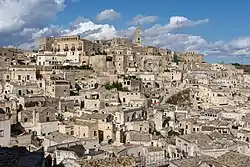
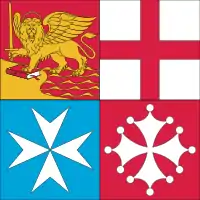
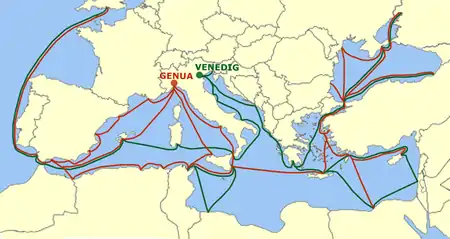
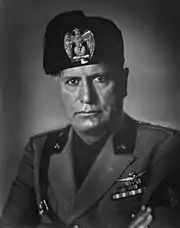
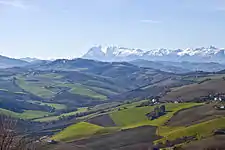
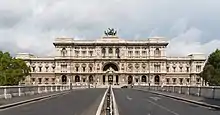
.jpg.webp)
.jpg.webp)
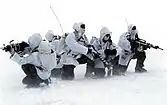
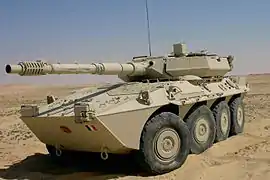





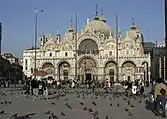
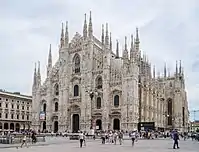

.jpg.webp)
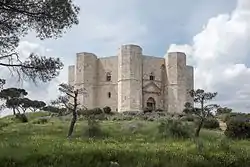


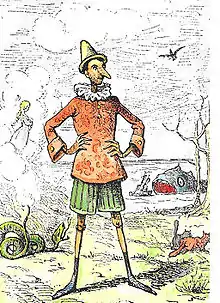

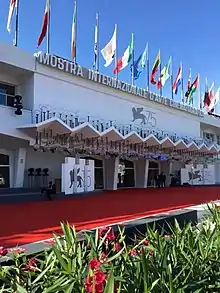
.svg.png.webp)



